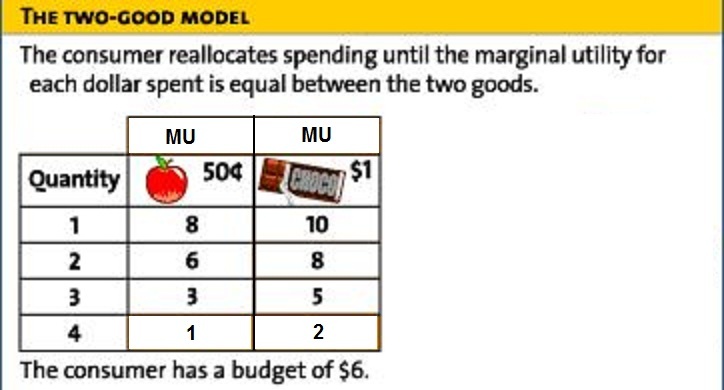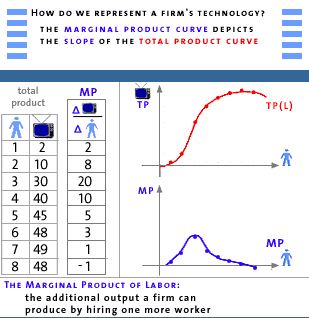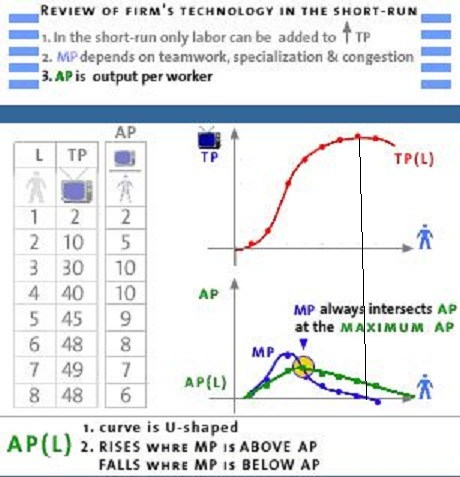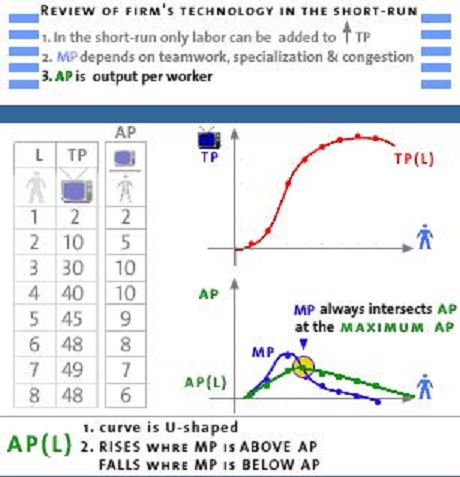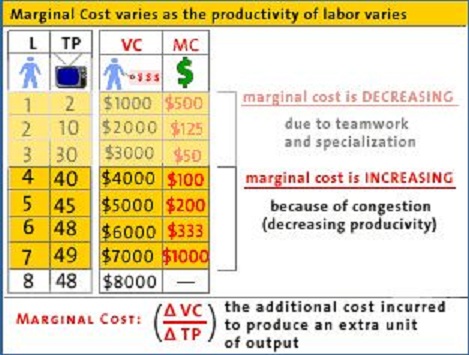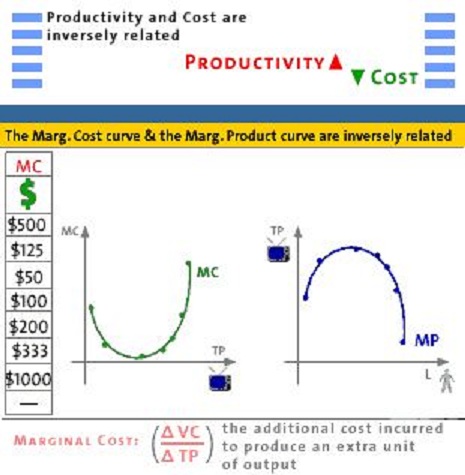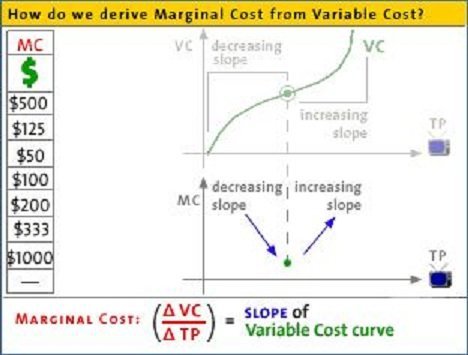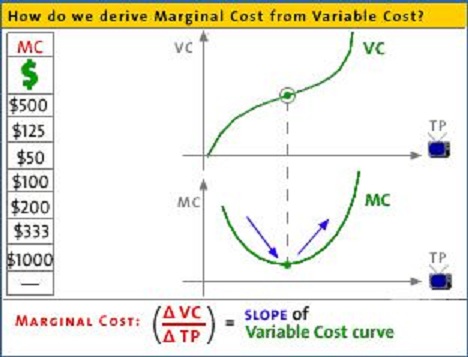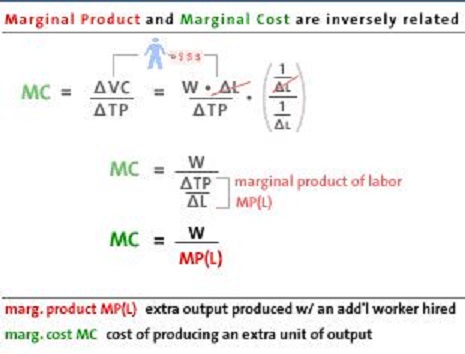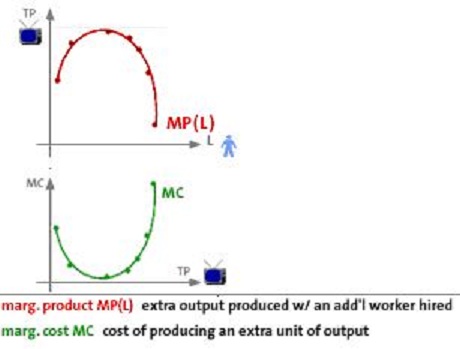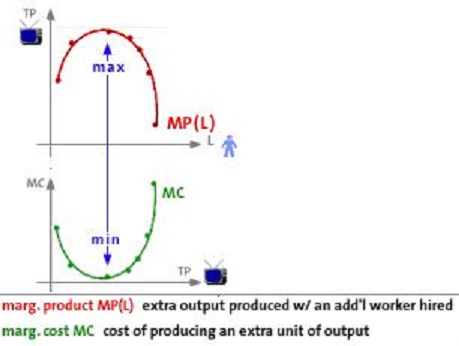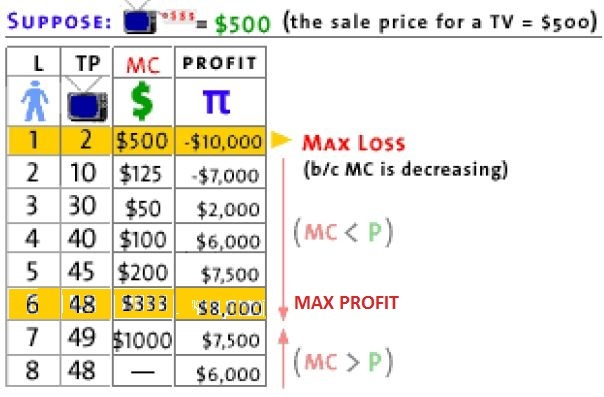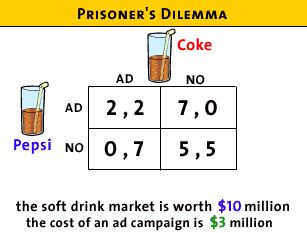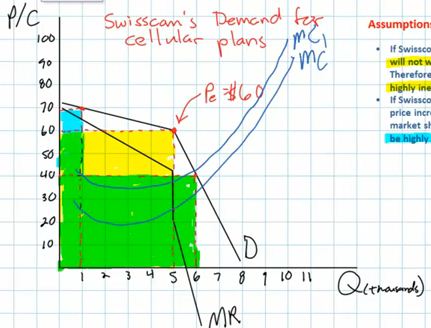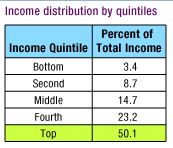The textbook and the online video lectures are
written by different authors and sometimes (often?) different
economic authors use different terminology or different approaches to
discuss the same concept. This webpage will help you see the
connections between our textbook and the online video
lectures.
Also, this webpage will allow me to add some
of my own comments and explanations. All of my comments begin with
"ME".
You should refer to this page when watching the
videos. Don't forget the quizzes (Thinkwell Exercises),
transcripts, and lecture notes that accompany most of the video
lectures. These can be very helpful.
Instructor Notes from the
Video Lectures
An introduction to Economics
(LESSONs 1a, 1b, 1c, and 1d)
LESSON 1a - BASIC MATH
SKILLS
Videos are usually between 5 and 10 minutes
long and most of them have a written transcript available and a
multiple choice question review quiz.
Instructions on how to purchase and access the video lectures can be
found in our syllabus.
- REVIEW OF GRAPHING CONCEPTS
- OPTIONAL: SIMPLE MATH, ALGEBRA, AND
GEOMETRY FOR ECONOMICS STUDENTS
REVIEW OF
GRAPHING CONCEPTS
1.2.1
(9:50) Using Graphs to Understand Direct Relationships -
1a
- Outline
- How do graphs work?
- About this graph
- How do graphs work
- economists use graphs to represent the
relationship between two variables (sometimes three) in a
two-dimensional space
- Example: the relationship between
consumption and income
- income on horizontal axis and
consumption on the vertical axis
- ALWAYS LABEL THE
AXES
- calibrate the axis with
numbers
- put data points on the graph; every
point on a graph represents two numbers
- (horizontal, vertical); (x,y);
(30,40)
- About this graph
- the x-axis is horizontal
- the y-axis is vertical
- a scatter diagram (or scatter
plot) is a collection of points on a graph showing the
observed relationship between two variables
- ME: even though Tomlinson just puts a
bunch of points on the graph, each one of them should have been
actual observed data; you can't just make up points on a
graph
- ME: most people seem to use the terms
"scatter diagram" and "scatter plot" TO MEAN THE SAME
THING
- "fitting" a line to the scatter plot to
show the relationship between the two variables
- on the scatter plot it looks like
when income increases consumption also increases
- x and y are directly related
when if x increases then y increases, or if x decreases then
y decreases; a direct relationship is also called a
positive relationship
- "fitting a line to a scatter plot
means that you draw a straight line that is as close to all
the dots as possible
- an upward sloping (from left to
right) line on a graph indicates a direct
relationship
- an upward sloping line will have a
positive slope (we will discuss the idea of slope
more later)
- economists will first notice general
relationships between data points like the positive, or direct.
relationship between income and household consumption
1.2.2
(9:57) Plotting A Linear Relationship Between Two Variables -
1a
- Outline
- Creating the demand
curve
- The demand curve
- Formula for the demand
curve
- The slope describes the consumer's
behavior when price changes
- Creating the demand curve
- look at the data and determine the
relationship between the two variables
- draw, LABEL, and calibrate the axes
("calibrate" means put numbers along the axes)
- the "origin" is the point
where the x and y axes intersect
- plot the data on the graph
- connect the points to draw the demand
curve
- The demand curve
- the demand curve shows the relationship
between the price of a good and he quantity a consumer wants to
buy
- ME:
- note that as the price of hamburgers
goes down then Bob will buy more hamburgers
- this represents an inverse, or
negative, relationship between price and quantity of
hamburgers purchased
- an downward sloping (from left to
right) line on a graph indicates an inverse
relationship
- an downward sloping line will have a
negative slope (we will discuss the idea of slope
more later)
- Formula for the demand curve
ME: We will not do this.
- y = a + bx
- y = the vertical axis variable
(Price)
- a = the y-intercept
- b = slope
- x = the horizontal axis variable
(Quantity)
- in our example:
- Price = $4.50 - $0.50 *
Quantity
- P=4.50 -.5Q
- The slope describes the consumer's behavior
when price changes
- b = slope = rise/run =
 y/
y/ x
= change in price / change in quantity =
x
= change in price / change in quantity =  P/
P/ Q
Q
- if the price of hamburgers decrease by
$0.50 then Bob will buy one more hamburger
- b =
 P/
P/ Q
Q
- slope = -$0.50 / 1 =
-0.50
- slope is negative indicating the
inverse relationship (or that have to DECREASE the prise to
get Bob to INCREASE the quantity that he will
buy)
- "
 "
means "change"
"
means "change"
- ME:
- So, if you know the
y-intercept and the slope of a straight line you can
find all of the possible values for the two
variables
- we know that a=4.50 and b=-.50,
then
- if the price is $3.00 how
many burgers will Bob buy?
- first, write down the
information that you have:
- price = y =
3.00
- y-intercept = a =
4.50
- slope = b =
-.50
- then, write down the
formula:
- y = a + bx
- Price = y-intercept +
slope times the quantity
- now, plug the data into the
formula
- finally, you can you solve
for Q
- subtract 4.50 from each
side:
- 3.00 - 4.50 = 4.50 +
-50Q - 4.50
- -1.50- = -50 *
Q
- then divide each side by
-50:
- -1/50/-50 =
(-.50Q)/.50
- -1.50/.50 =
Q
- 3 = Q;
- if you look at the
graph or the table you can see that we got it
right; when the price was $3.00, Bob bought 3
hamburgers
|
|
1.2.3
(8:42) Changing the Intercept of a Linear Function -
1a
- Outline
- What happens if we change Bob's
income?
- Raising Income
- Lowering income
- Summary
- What happens to the relationship between
price and quantity if we change Bob's income?
- Raising Income
- if Bob gets a higher income we can
expect that he will change his behavior; he will probably buy
more hamburgers
- on the demand table we can see that at
the same prices, Bob will buy more hamburgers
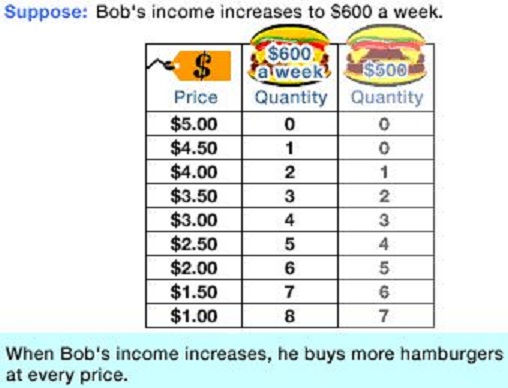
- on the graph, with the higher income the
y-intercept has increased and the demand curve has moves to the
right
- the slope is still the same so we
still have the same negative relationship, but now with
higher quantities
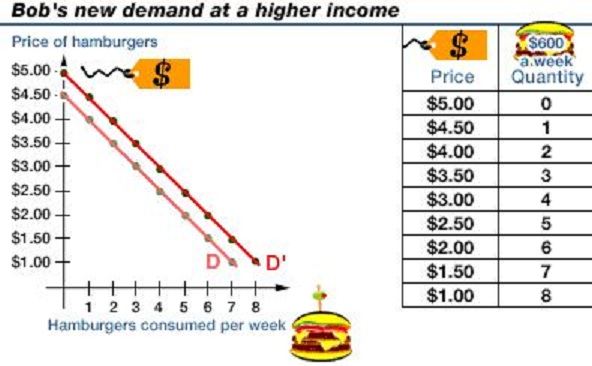
- formula for the new demand if Bob's
income increases: P = 5.00 -.50Q
- the curve has shifted to the
right
- Lowering income
- we can do the same thing for a lower
income causing the curve to shift to the left
- this will decrease the y-intercept (but
keep the slope the same)
- formula for the demand with a lower
income: P = 4.00 -.50Q
- the curve has shifted to the left and
the slope stays the same
- Summary
- a change in income will result in a
parallel shift of the demand curve
1.2.4 (7:28) Understanding
the Slope of a Linear Function - 1a
- Outline
- What does the slope of a demand curve
indicate?
- Units and Slope
- What does the slope of a demand curve
indicate?
- the sensitivity of Bob's demand for
hamburgers to changes in the price
- or, what happens to the number of
hamburgers that Bob buys each week when the price
changes?
- this will help us understand how
economists think about the slope of a line
-
- in our original example we saw that when
the price of hamburgers fell by $0.50 then Bob would buy one
more hamburger a week

- so if the price goes down from $2.00 to
$1.50
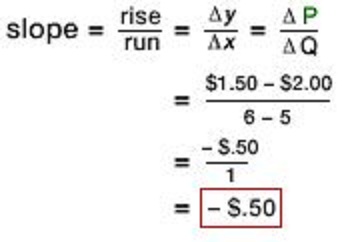
- What if the slope of the demand curve
changes?; What if Bob has a different relationship between
price and quantity?
- if price = $2.00 then he would buy 5
hamburgers and if price = $1.50 he would buy 10
hamburgers
- result: and new demand curve with a
different slope; a flatter slope; and smaller
slope
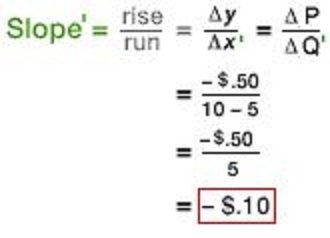
- now Bob is more sensitive to a change
in price; now, a $0.50 decrease in price causes Bob to buy a
lot more (5) hamburgers; or when the price decreases by just
a dime ($0.10) he will buy one more hamburger
- the slope of curves indicates the
sensitivity of one variable to changes in another
- Units and Slope
- Warning: the slopes of the curves
depends completely upon the unit in which the variables are
measured
- here we were measuring the price of
hamburgers in dollars ($4.00, $3.50, $3.00, etc)
- but the slopes would change if we
measured the prices in cents (400 cents, 350 cents, 300
cents, etc)
- so if we change the way we measure
the price, then the slopes will change
- the same thing happens if we change
the way that we measure burgers (boxes of burger, or half
burgers, etc)
- so if we want to measure the sensitivity
of one variable to changes in another we can't use slope since
slopes can change just because we change the units, even though
the sensitivity is the same
- therefore economists use something class
"elasticity" to measure sensitivity
- the price elasticity of demand
is the percentage change in the quantity demanded that results
from a percentage change in price
- since elasticity uses percentage
changes, is doesn't matter whether we measure the price of
hamburgers in dollars or in cents, the elasticity (sensitivity)
will be the same
OPTIONAL:
SIMPLE MATH, ALGEBRA AND GEOMETRY FOR ECONOMICS STUDENTS
How to Multiply and Divide Fractions in
Algebra for Dummies (YouTube fordummies 1:50) - 1a
http://www.youtube.com/watch?v=B7MtFQW7i_I
- 2/5 x 3/7
- 2/3 x 3/8
- 2/3 x 3/7
- 1/3 ÷ 4/5
Simple Equations (11:06) - 1a
http://www.khanacademy.org/math/algebra/solving-linear-equations-and-inequalities/v/simple-equations
- 7x = 14 (very elementary)
- 3x = 15 (6:00 is a good place to
start)
- 2y + 4y = 18
Solving One-Step Equations (1:54) - 1a
http://www.khanacademy.org/math/algebra/solving-linear-equations-and-inequalities/v/solving-one-step-equations
- a + 5 = 54; solve for a and check your
solution
Solving One-Step Equations 2 (2:23) - 1a
http://www.khanacademy.org/math/algebra/solving-linear-equations-and-inequalities/basic-equation-practice/v/solving-one-step-equations-2
- x/3 = 14; solve for x and check your
solution
Solving Ax + B = C (8:41) - 1a
http://www.khanacademy.org/math/algebra/solving-linear-equations-and-inequalities/basic-equation-practice/v/equations-2
- 3x + 5 = 17 (very elementary)
- 7x - 2 = -10 (starting at 5:20)
Area and Perimeter (12:20) - 1a
http://www.khanacademy.org/math/geometry/basic-geometry/v/area-and-perimeter
- area of a square
 (very elementary; he does make an adding error!)
(very elementary; he does make an adding error!)
- area of a rectangle (begins at 5:00)
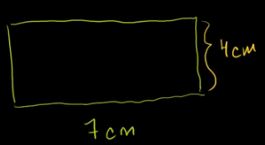
- area of a right triangle (begins at
6:44)
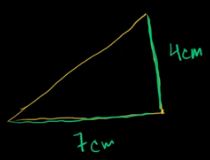
- area of a triangle (begins at 10:06)
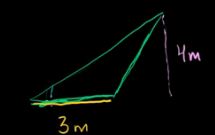
LESSON 1b - THE 5Es OF
ECONOMICS
LESSON 1c - SCARCITY AND BUDGET LINES
- WHAT IS ECONOMICS: SCARCITY, THE 5Es, AND
MAKING CHOICES
- BUDGET LINES
1.1.1 (6:35) Scarcity -
Defining Economics - 1c
- Outline:
- what is economics?
- opportunity costs
- the big picture: economic
models
- definition of economics: rational choice
under conditions of scarcity
- what is scarcity?
- ME: limited resources vs. unlimited human
wants
- what is rational choice? = self interest,
comparing costs and benefits to maximize satisfaction = calculated
self interest
- ME: Our textbook calls this "Benefit
Cost Analysis" or MB = MC
- ME: we will be using this a lot this
semester
- ME: whenever you get a chance, pay close
attention to "rational choice" or "Benefit Cost Analysis". You
will need to know it.
- calculated self interested people operating
under conditions of scarcity = economics
- opportunity cost
- no such thing as a free lunch
- we can make economic models about almost
anything
- ME: what I like about economics is it's
use of models
- ME: I think teaching students the
benefits of using models and how to use models is one of the
most important goals if this course
- ME: most models in economics involve the
use of graphs
1.1.2 (13:20) What
Economists Do - 1c
- Outline:
- scientific method
- ask questions
- produce models
- form hypotheses
- where to find
economists
- normative vs. positive
economics
- the STUDY of economics = social science =
uses the scientific method = asking a question = why?
- what to produce?
- how will it be produced?
- who is going to get what is
produced?
- building a scientific model = map = the
model (map) that you use depends on the question being asked
providing only the information needed to answer the
question
- hypotheses = predictions on how the world
works = can be tested with data
- building relationships between variables by
ignoring variables that do not matter to the questions being
investigated
- ME: models are SIMPLIFICATIONS of
reality
- ME add more: GENERALIZATION
- ABSTRACTION
- ask a question
- isolate related variables and build
model
- come up with hypotheses that you can test
with data
- ceteris paribus: holding all other
factors constant to help see relationships between just two
variables
- Positive economics vs normative
economics
- positive: what IS happening? what will
happen, predictions, and descriptions how world does
work
- normative: what SHOULD we do? judgments
What is good? how world should work
1.1.3 (11:21) Microeconomics
and Macroeconomics - 1c
- Outline:
- microeconomics vs.
macroeconomics
- players in the
economy
- nominal vs. real
variables
- microeconomics vs
macroeconomics
- individuals vs aggregate, biology analogy:
cell vs. whole organism
- macro: study of the economy as an organism,
study of the overall economy
- micro: how the cell works; individual parts
of the economy
- MICRO: the way a particular household
responds to changes in incentives
- ignores money, relative prices rather
than monetary prices
- MACRO: money is the life blood of the
macroeconomic organism
- money carries things through the
system,
- difference: individual decision making vs.
the whole organism
- money is more or less ignored in micro vs.
money is important in macro
- the four major players: households,
businesses, government, foreigners (net exports) and how they are
studied in micro vs. macro
- "real" values are measured in terms of
physical goods and services
- "nominal" values are measured in dollar
terms, money; $1.25 (nominal) vs a real cup of coffee
(real)
BUDGET
LINES
3.2.1
(9:36) Constructing a Consumer's Budget Constraint -
1c
- Outline
- Consumer dilemma: toys or
snacks?
- Plotting points on the budget
constraint
- Budget constraint = an equation for a
line
- Budget constraint & opportunity
cost
- ME: this is our first economic model, our
first graph!!!
- Consumer dilemma: toys or snacks?
- I want it all, but I have a limited
amount to spend
- what is feasible (possible) = the budget
constraint = what you can afford
- ME: we are not going to do the
indifference curves (or preferences) and we are not going to
derive the demand curve
- Plotting points on the budget
constraint
- vertical axis = quantity of
snacks
- horizontal axis = quantity of
toys
- The info we need to figure it out
- I only have $ 12 to spend; called
your income
- income = $12
- price of toys = $3.00
- price of snacks = $1.00
- What is the maximum number of $1 snacks
that you can buy with your $12? TWELVE
- What is the maximum number of $3 toys
that you can buy with your $12? FOUR
- The video lecture will
ask you a multiple choice question. ANSWER THE QUESTION by
selecting A, B, or C and more of the lecture will
follow
- budget constraint (or budget
line) shows all of the combinations of two goods that you
can afford to buy given your limited income and the prices of
the goods; it shows what is feasible or possible
-
- Budget constraint = an equation for a
line
- income = (Pt x Qt) + (Ps x Qs); M = Pt*T
+ Ps*S
- isolate the snack variable because it is
on the vertical axis
- S = M/Ps - (Pt/Ps*T)
- the number of snacks that you can afford
EQUALS the number of snacks that you can afford if you spent
your whole income on snacks MINUS the number of toys that you
buy times the relative price of toys to snacks
- Budget constraint & opportunity
cost
- the Pt/Ps term is the opportunity cost
of getting another toy = -3/1 = -3
- so the opportunity cost of getting
another toy is that you have to give up 3 snacks.
- THIS IS WHERE THE VIDEO LECTURE ENDS
The video lecture
will ask you a multiple choice question. BUT there is an error
in the video. Just end the video here
3.2.2 (5:02) Understanding a
Change in the Budget Constraint - 1c
- Outline:
- Intro
- What can change the budget constraint
(budget line)?
- Effect of a change in
income
- Effect of a change in
price
- Review: movements of the budget
line
- Intro
- the slope of the budget line is Pt/Ps which
is the number of snacks that you have to give up to get one more
toy = -3
- What can change the budget constraint
(budget line)?
- if your income changes it will change
your budget line
- if the prices of the products change it
will change your budget line
- Effect of a change in income -- What
happens to the budget line (what you can afford to buy) if:
- income is reduced
- if income (M) goes from $12 down to
$6 then you can afford to buy LESS
- and the budget line will shift
inward but it will keep the same slope because the relative
prices, Pt/Ps, has not changed
- income is increased
- the budget line will shift outward,
but
- keep the same slope because the
opportunity cost of toys measured in terms of snacks (Pt/Ps)
has not changed
- Effect of a change in price
- What happens if the price of toys
decreases from $3 to $1.50?
- If your budget is still $12 then you
will be able to buy more toys = 8 toys (8 x $1.50 =
$12)
- but you can still buy the same number
of snacks
- so the budget line rotates out
along the toy axis
- notice that if the price of toys
decreases your budget line has rotated outwards meaning that
you can buy more toys AND snacks
- Review: movements of the budget line
- if there is a change in income then the
budge line SHIFTS, but the slope stays he same
- if there is a change in price of one of
the goods then the budget line ROTATES and the slope
changes
LESSON 1d - PRODUCTION
POSSIBILITIES and BENEFIT COST ANYALYSIS
1.4.1 24:46) Understanding
the Concept of Production Possibilities Frontiers -
1d
- Outline:
- scarcity and
efficiency
- production possibilities
table
- production possibilities
curve
- calculating opportunity
costs
- production possibilities curve - PPC (also
called the production possibilities frontier - PPF) and
scarcity
- ME: This is our second model or
graph
- first: discuss efficiency: doing the best
with what you have = getting the most you can from what you
have
- efficient behavior is to produce the most
wheat with a given quantity of rice
- only two goods produced - what is the
optimal output of wheat and rice this economy can
produce
- need to know what resources and what
technology is available
- ME: our textbook lists 5 assumptions of the
production possibilities curve:
- fixed resources
- fixed technology
- productive efficiency
- full employment
- only two goods being
produced
- technique vs. technology
- technique = a particular combination of
inputs
- technology = all the possible
combination of inputs = a catalog of all the things an economy
knows how to do
- improved technology = more output with less
input
- production possibilities table : every
combination is an "efficient" combination that can be produced =
maximum amount that can be produced
- ME: Note how Professor Tomlinson is moving
the "best suited" resources first to the production of rice; this
allows a large increase of rice production with only a small loss
of wheat production
- "efficient combination of resources" means
that we are producing the maximum quantities possible
- the production possibilities curve (PPC) is
also called the production possibilities frontier
(PPF)
- first label the axes
- then calibrate the axes
- now plot the points that represent the
possible combinations of wheat and rice that can be
produced
- ME: any point on a graph represents two
numbers; don't get scared, all we are doing is looking at only TWO
NUMBERS for each point on the graph
- then connect the dots to draw the
graph
- NOTE: the shape of the PPC
- PPC is a collection of points representing
the maximum combinations of output an economy can produce given
that economy's technology and resource endowment
(amounts)
- What the PPC represents:
- points (quantities of wheat and rice)
outside of the curve are not attainable (ME: such quantities
are IMPOSSIBLE with the given technology and resources
THEREFORE WE MUST MAKE CHOICES)
- points within the PPC are possible but
are less than the maximum possible. If there is inefficiency or
unemployment then less than the maximum possible will be
produced and the economy will be at a point within their
PPC
- a point within the curve (i.e. less
output) is also what happens if there are UNEMPLOYED
resources
- ME: when Tomlinson is discussing
using wet land for wheat and dry land for rice he is talking
about PRODUCTIVE INEFFICIENCY - not using
resources where they are best suited (from the online 5Es
lecture). He calls this the "underemployment of resources".
I call this "productive inefficiency" (5Es)
- OPPORTUNITY COST = downward
sloping PPC; wheat is the opportunity cost of rice:
Why?
- CALCULATING THE OPPORTUNITY COST.
Know how to do this!
- opportunity cost = change in
wheat/change in rice
- opportunity cost is the slope of the
line connecting the two points
- Why does the opportunity cost (slope)
of producing rice increase as more rice is produced?
- i.e. why does the PPC get steeper as
we increase the quantity of rice?
- shape of PPC is CONCAVE (bowed
out)
- ME: our textbook calls this the "Law
of Increasing Costs"
- WHY?
- Because not all resources are
the same. Some are better for producing rice and others
are better suited to producing wheat
- this causes the opportunity costs
to increase as we produce more rice
- i.e. this causes the shape of the
PPC to be concave (bowed out)
- SUMMARY: 4 things we can see in the
PPC
- some combinations are impossible so
therefore there is scarcity AND we must then make
choices
- unemployed resources and productive
inefficiency causes less than the maximum level of
production
- there are opportunity costs
- the PPC is concave representing
increasing opportunity costs because not all resources are the
same, some are better suited to producing rice and others are
better suited to producing wheat
- ME: from our yellow pages - 1d
- The Production Possibilities Curve
can be used to illustrate several important economic
concepts:
- we must make choices
- choices have opportunity
costs
- the law of increasing
costs
- the effect of
unemployment
- the effect of productive
inefficiency
- the effect of economic
growth
- how present choices affect future
possibilities
- it does NOT show the optimum
product mix (allocative efficiency)
- Later we'll use the MB=MC
analysis to do this (see figure 1.3 [p. 13] of
your textbook)
1.4.2 (10:10) Understanding
How a Change in Technology or Resources Affects the PPC -
1d
- Outline:
- production possibilities
curve
- outward shift (ME: called "economic
growth")
- individual product
shift
- inward shift
- summary
- What happens if there is a change in
technology or amount of resources? PPC will shift out
- What is the difference between an movement
along an existing PPC and shifting the curve to a new
curve?
- If BETTER TECHNOLOGY for rice and wheat
production is discovered, the curve will shift outward
representing that MORE can be produced i.e the quantities on the
production possibilities table get larger
- What if we get MORE RESOURCES like more
labor? Answer: PPC shifts outward
- ME: our textbook calls this "economic
growth".; Definition: and increase in the ABILITY to produce
caused by getting more resources, getting better resources, or
getting better technology
- What if we ONLY get better technology for
wheat but not for rice? A "skewed" shift outward of the
PPC.
- What if there is a change in climate
hurting the production of wheat but helping the production of
rice? Again, a "skewed" shift outward of the PPC.
- What if there are FEWER RESOURCES? The PPC
will shift inwards
- ME: there is a big difference between
moving from a point on the curve to moving to a point inside the
curve AND the whole curve shifting inward
- moving from a point on the curve to to a
point inside the curve is caused by not using all available
resources (unemployment) or productive inefficiency. If this
happens we still CAN produce the same quantities as before, but
we are just not achieving our potential; our possible
production did not change
- the whole curve shifting inward is
caused by there being fewer resources than before (depletion)
and now the maximum that can be produced is less; out potential
has decreased
- QUESTION: Which combination of
wheat or rice is preferred? ME: Which is the allocatively
efficient quantity? ANSWER:"We have no idea." The PPC is not
designed to tell us what we want. It is designed to tell us what
is possible. We will have a different model in a later lesson to
tell us what we want - what quantities will maximize our
satisfaction (allocative efficiency)
- ME: when Tomlinson is discussing
"efficiency" he seems to be discussing only PRODUCTIVE EFFICIENCY.
Now would be a good time to re-read the 5Es lecture:
http://www.harpercollege.edu/mhealy/eco212i/lectures/ch1-18.htm
1.4.3 (21:58) Deriving the
Algebraic Equation for the Production Possibilities Frontier -
1d
- Outline
- unit labor
requirement
- production possibilities
schedule
- production possibilities
graph
- formula for the production
possibilities line
- significance of the
line
- Another view of the PPC, good
review
- ME: why is Bernie's PPC a straight line?
NOT CONCAVE
- ME: You do NOT have to know the
algebraic equation
- A straight line can be described with an
algebraic equation: y = mx + b
- y = vertical axis variable =
SW
- m = slope
- b = vertical intercept = 6
- x = horizontal axis variable =
SC
- SW = 2SC + 6 or y = 2x + 6
MAKING
CHOICES: THE ECONOMIC WAY OF THINKING -- BENEFIT-COST ANALYSIS (also
called Marginal Analysis or Cost-Benefit Analysis)
Thinking at the Margin (LearnLiberty 4:32) -
1d
http://www.youtube.com/watch?v=tMhdTn-5fu8
- ME: "marginal" means "extra" or
"additional"
- individuals make choices based on
comparisons at the margin
- when wanting to make the best choice we
compare the options
- "thinking at the margin" means we look at
the next option
- why are diamonds more expensive than
water?
- because when you compare the value of an
extra unit of water (the marginal unit) with the extra unit of
diamonds
- we make choices at the margin all the
time,
- also businesses make decisions at thre
margin, decisions like:
- should we hire an extra employee?
- we compare the extra cost of that
employee, called the marginal cost (MC)
- with the extra benefits that we will
get from that worker -- i.e. the marginal benefit
(MB)
Incentives and Marginal Analysis
(MrHurdleHistory 8:54) - 1d
http://www.youtube.com/watch?v=dN9KyDCur2Y
- to make the best decision:
- select all options where the MB > MC
(marginal benefits are greater then the marginal costs OR extra
benefits are greater than the extra costs)
- up to where the MB = MC
- but never where the MB <
MC
- the BEST CHOICE is always where MB
=MC
- changes in MB and MC: [ME: KNOW
THIS]
- if the MB increase, people will do
more
- if the MB decrease then people will do
less
- if the MC increase then people will do
less
- if the MC decrease then people will do
more
LESSON 2a - MARKET ECONOMIES
AND TRADE
- ECONOMIC SYSTEMS
- SPECIALIZATION AND GAINS FROM TRADE
ECONOMIC SYSTEMS
1.1.4 (10:50) An Overview of
Economic Systems - 2a
- Outline
- Three Economic
Questions
- Pure Laissez-faire economic
system
- Centrally-planned economic
system
- Mixed economic
systems
- Every economic system must answer three
questions
- What will be produced
- How will it be produced
- Who will get what is
produced
- ME: the textbook lists five fundamental
questions
- What goods and services will be
produced?
- How will the goods and services be
produced?
- Who will get the goods and
services?
- How will the system accommodate
change?
- How will the system promote
progress?
- Pure Laissez-faire economic system -
One EXTREME
- "Laissez-faire" is French for "leave us
alone" or "let us do"
- everyone makes their own
decisions
- prices arise in a market and these
prices provide incentives to guide resources
- the role of prices is very important in
coordinating the use of resources
- law of the jungle
- maximum individual freedom
- all people respond according to what
they perceive is best for them
- problems:
- end result might end up not being
best fit society as a whole
- examples of when the end result
may be bad: (1) standing up at a football game, (2)
litter, (3) when prices are not available to guide
decisions like for clean air
- monopolies may form
- Centrally Planned Economy - the
other EXTREME
- central idea: a wise central planner
make all the decisions of when recourses would be used and how
to generate wealth for society
- Problems - where does the central
planner get the information to make good decision and how do
they get each resource to do what is assigned
- via less freedom or monetary
incentives?
- central planner does not have all the
information needed
- how do you keep the central planner
from abusing their power and work for the best interest of
the society rather than do what is best for
themselves?
- Show which extreme view is
better?
- In the real world all economic systems are
MIXED SYSTEMS including parts of laissez faire and parts of
central planning
- US: mostly laissez-faire with some
central planning
- China: a lot of central planning and
some laissez-faire
- The role of the government in these mixed
systems then is to regulate the mix of these two extremes, some
allow more laissez-faire and some do more central
planning
- a spectrum or continuum of mixed economic
systems
Power of the Market
(LibertyPen 1:14) - 2a
http://www.youtube.com/watch?v=4FHxpoQqPTU
- Milton Friedman (July 31, 1912 November 16,
2006) was an American economist, statistician, and author who
taught at the University of Chicago for more than three decades.
He was a recipient of the Nobel Prize in Economics
- the invisible hand of capitalism -- what is
it? ME: KNOW THIS!
17.5.3 (12:16) Comparative Economic
Performance - 2a
- Outline
- The Bolshevik
Revolution
- Contributing factors to the collapse
of the Soviet Union
- Movement back to free-market
economy
- The Bolshevik Revolution
- Forced the movement from a
decentralized economy to a centrally planned economy
in Russia in the early 20th century
- they nationalized capital --
the government took over businesses
- goal was to increase the
standard of living
- With no motivational incentives
to produce high quality goods, production slowed
considerably
- in the 1950s and 60s the
economy of the Soviet union grew at a grate of
5%-6% -- about the same or faster than other
countries with market economies
- 1970s this rate slowed to
about 2-3%, 1980s 1-2%, 1990s recession
(decline)
- Why?
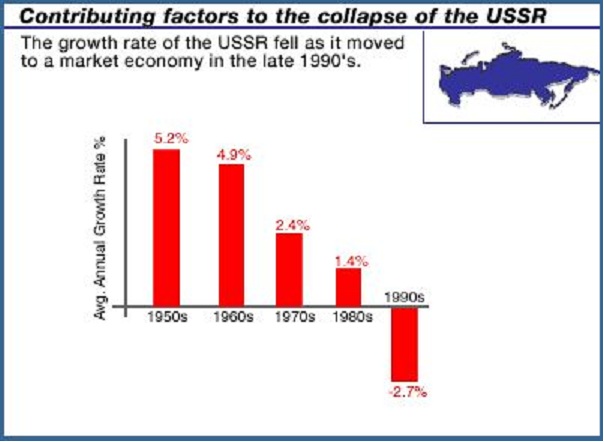
|
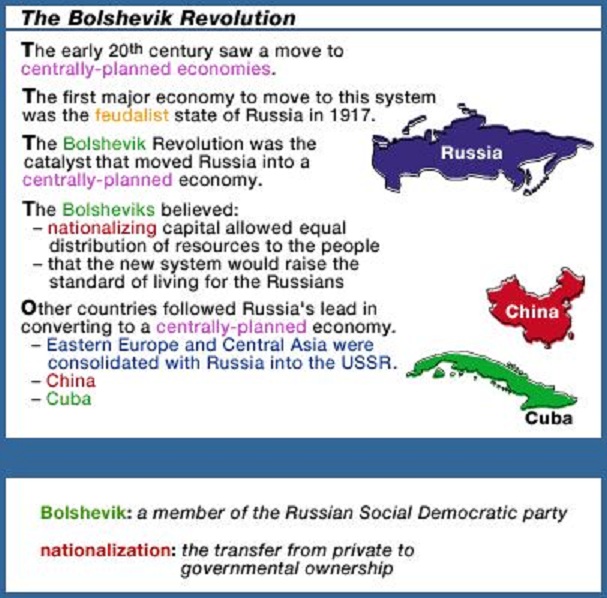
|
- Contributing factors to the collapse of the
Soviet Union
- government took too many
resources -- 15% of GDP used for national defense vs.
6% in the US
- lack of incentives for workers
;ME: the "incentive problem" from the
textbook
- misallocation of resources
caused shortages; ME: the coordination problem from
the textbook
- Soviet technology was a decade
behind because there was no profit motive to encourage
investment in new technology
- A two-class society
developed
- ME: see the textbook for
- the incentive
problem
- the coordination
problem
|
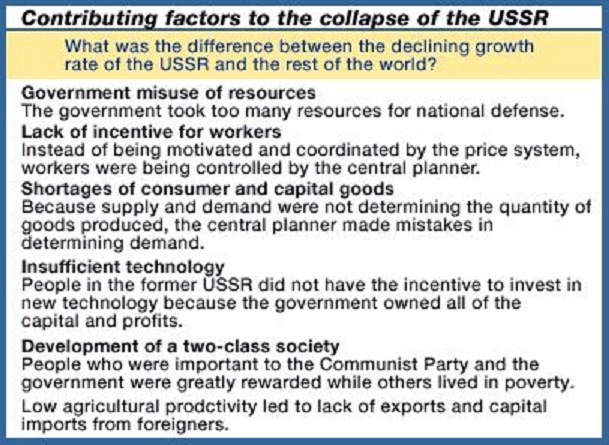
|
- Movement back to free-market
economy
- In the late 1980s, through
Mikhail Gorbachev's ideals of glasnost and
perestroika, the Soviet Union began its
transformation in response to the failed planned
economy
- Resources were
privatized
- ownership would serve as an
incentive to achieve efficiency
- Government printed rubles
(money) causing inflation
- prices of goods and services
were deregulated and allowed to be set by supply and
demand (ME: lessons 3a, 3b, and 3c)
- Russia did not have the
financial institutions that established free market
economies did; little protection of property
rights
- organized crime rose in the
early 1990s ; a mafia arose
- Economic growth
slowed
|
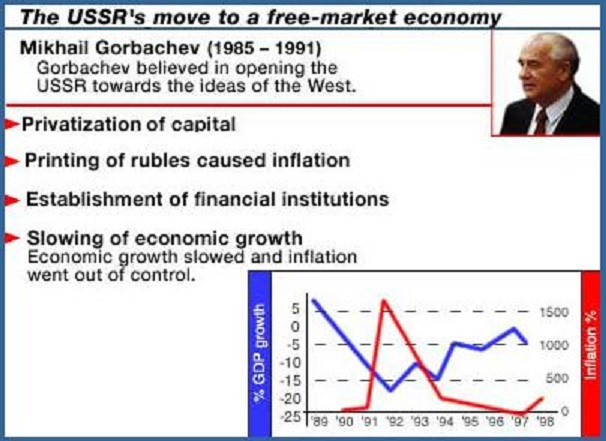
|
- Summary
- The Czech republic soon attained 5%
growth while Russia didn't
- Capitalism is a success and Communism is
a failure?
- too simplistic of a
conclusion
- we have some central planning in the
US - a mixed economy
- but the Russian experiment did fail
as compared to similar market economies
SPECIALIZATION AND GAINS FROM
TRADE
1.5.1 (22:40) Defining
Comparative Advantage with the Production Possibilities Curve -
2a
- Outline
- Anne's Production
Possibilities
- Comparing Production Possibilities
curves
- Specializing and
Trading
- Creating More Output
- Anne's Production Possibilities
- ME:
- The concept of comparative advantage
can be used to show how two (or two countries) with
different abilities (or resources) can cooperate (or trade)
to increase their wealth
- we will show how countries gain from
international trade
- we will be using straight line
production possibilities curves for two different people
(Bernie [previous lecture] and Anne) to show how
together they can do more than if they cooperate
(trade)
- Note that Anne can BOTH scrub and sweep
more than can Bernie; we say that Anne has an absolute
advantage in doing both tasks since she can do them with
fewer resources; i.e. Anne is better at doing both
- Anne's production possibilities schedule
shows the various maximum combinations of sweeping and
scrubbing maximum number of rooms that she can do in one
hour
- Comparing Production Possibilities curves:
finding the opportunity costs
- Calculate Anne's opportunity
costs of sweeping and scrubbing"
- 1 room swept = 1 room not
scrubbed
- 1 room scrubbed = 1 room not
swept
- Calculate Bernie's opportunity
costs
- 1 room swept = 1/2 room not
scrubbed
- 1 room scrubbed = 2 room not
swept
- a straight line PPC means that the
opportunity costs are constant; for a country it would mean
that we would assume a that all resources within that country
are the same; remember in a previous lecture we said that a PPC
is usually concave to the origin (bowed out) because not all
resources are the same. Some are better for producing one
product and others are better suited to producing something
else
- this causes the opportunity costs to
increase as we produce more of one product
- i.e. this causes the shape of the PPC
to be concave (bowed out)
- BUT when discussing comparative
advantage we usually assume that all resources within a country
are the same so that we get constant opportunity costs and a
straight line PPC: this makes our work easier
- Specializing and Trading
- Here are the opportunity costs
again:
- Anne's opportunity costs of
sweeping and scrubbing
- 1 room swept = 1 room not
scrubbed
- 1 room scrubbed = 1 room not
swept
- Bernie's opportunity costs
- 1 room swept = 1/2 room not
scrubbed
- 1 room scrubbed = 2 room not
swept
- What if they worked
independently:
- then they can only sweep and scrub a
number of rooms that is on their PPC
- lets ASSUME that Bernie sweeps 2
rooms and scrubs 2 rooms
- lets ASSUME that Anne sweeps 6 rooms
and scrubs 6 rooms
- they of course could clean different
combinations, but let's just use this as our given starting
point
- Creating More Output
- working independently, what are the
total number of rooms that are swept and scrubbed?
- scrubbing: Bernie 2 rooms + Anne 6
rooms = 8 rooms scrubbed
- sweeping: Bernie 2 rooms + Anne 6
rooms = 8 rooms swept
- remember this is one of the MAXIMUM
combinations possible if they work independently
- But what if they specialize according
to their comparative advantages? Then, how many rooms can be
scrubbed and swept?
- a person has a comparative
advantage at an activity if they can perform that activity
at a lower opportunity cost than anyone else; i.e. if they
give up less than other people when they do the
activity
- We will show that if Bernie and Anne
specialize according to their comparative advantages that they
can scrub and sweep MORE ROOMS THAN IF THEY WORKED
INDEPENDENTLY
- who has a comparative advantage in
scrubbing? -- that is, who has a lower op cost of
scrubbing OR who gives up sweeping fewer rooms when they
scrub
- ANNE: 1 room scrubbed = 1 room not
swept
- Bernie: 1 room scrubbed = 2 room
not swept
- Anne has a lower op cost of
scrubbing = 1room not swept; if she scrubs a room she
gives up fewer rooms not swept -- just 1) whereas If
Bernie scrubbed a room he would give up 2 rooms not
swept.
- so Anne has a comparative
advantage in scrubbing and she should specialize in
scrubbing
- who has a comparative advantage in
sweeping? -- that is who has a lower op cost of sweeping
OR who gives up scrubbing fewer rooms when they sweep
- ANNE: 1 room swept = 1 room not
scrubbed
- Bernie: 1 room swept = 1/2 room
not scrubbed
- Bernie has a lower op cost of
sweeping = 1/2 room not scrubbed; if he sweeps a room he
gives up fewer rooms not scrubbed -- just 1/2) whereas If
Anne swept a room she would give up 1 rooms not
scrubbed.
- so Bernie has a comparative
advantage in sweeping and he should specialize in
sweeping
- People, or countries, should
specialize in (do more of) those things in which they have a
comparative advantage; in which they give up the least. When
they do this MORE will be produced
- We will see how in the next
lecture
1.5.2
(6:46) Understanding Why Specialization Increases Total Output -
2a
- Outline
- Bernie and Anne
Continued
- Recognizing
specialization
- Conclusion
- Bernie and Anne Continued
- Bernie has a comparative advantage in
sweeping and he should specialize in sweeping
- Anne has a comparative advantage in
scrubbing and she should specialize in scrubbing
- So lets have Bernie ONLY SWEEPS and in
one hour he will be able to sweep 6 rooms (and scrubbing
0)
- And, let's have Anne do more scrubbing,
let's say she scrubs 9 rooms. leaving her time to sweep 3
rooms
- What happened to total number of rooms
scrubbed and swept?
- by specializing according to their
comparative advantages together they are now sweeping 9
rooms (6 by Bernie and 3 by Anne) and scrubbing 9 rooms (all
by Anne)
- REMEMBER: in the previous lecture we
said that working independently they could only sweep and scrub
8 rooms, BUT by specializing and trading they can now sweep and
scrub 9 rooms, in the same amount of time
- BEFORE (without
specialization):
- scrubbing: Bernie 2 rooms + Anne 6
rooms = 8 rooms scrubbed
- sweeping: Bernie 2 rooms + Anne 6
rooms = 8 rooms swept
- AFTER (with specialization):
- scrubbing: Bernie 0 rooms + Anne 9
rooms = 9 rooms scrubbed
- sweeping: Bernie 6 rooms + Anne 3
rooms = 9 rooms swept
- ME: with the same amount of resources
(one hour of work each), by specializing according to their
comparative advantages, MORE ROOMS were swept and scrubbed (one
more of each)! EVEN THOUGH Anne is better at doing
both.
- Recognizing specialization
- Conclusion
- the trader with the flatter PPC will
have a comparative advantage for providing the good or service
on the horizontal axis (assuming the graphs are calibrated the
same)
- if you have a comparative advantage in
one good then you have a comparative disadvantage for the other
good
- everyone has a comparative advantage in
something
- by specializing according to
comparative advantage everyone who is trading can
gain!
1.5.3 (25:35) Analyzing
International Trade Using Comparative Advantage - 2a
- Outline
- Constraints of Two
Countries
- Graphing Production
Possibilities
- Benefits of Trading
- Constraints of Two Countries
- Pakistan's unit labor requirement: the
amount of time it takes to perform a task
- 1 wheat takes 2 workers
- 1 rice takes 3 workers
- now we can calculate the opportunity
cost
- 1W = 2/3 R
- 1R = 3/2 W = 1 1/2 W
- if Pakistan has only 60 workers then
it can produce
- a maximum of 30 W
- OR a maximum of 20 R
- now we can draw the PPC for
Pakistan
- Malaysia with a different technology can
produce
- 1 W with 1 worker, and
- 1 R with 2 workers
- Malaysia has an absolute advantage in
producing both wheat and rice; i.e. they are better at
producing both
- now we can calculate the opportunity
costs in Malaysia
- 1 W= 1/2 R; every time they
produce a bushel of wheat it takes them 1 worker who
could have produced 1/2 bushel of rice
- 1 R = 2 W
- if Malaysia has only 60 workers then
it can produce
- a maximum of 60 W
- OR a maximum of 30 R
- now we can draw the PPC for
Malaysia
- Graphing Production Possibilities
- PPC is a straight line
- which means the opportunity cost is
constant; it means we are assuming all of the resources in
Pakistan are the same and all of the resources in Malaysia are
the same;
- if some resources in one country were
better at producing wheat and some were better at producing
rice then the PPC would be concave (bowed out) and we would
have increasing costs
- we could have also plotted the PPC using
the equation for a straight line
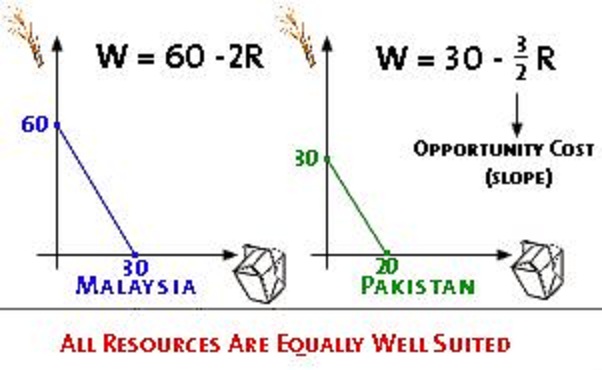
- opportunity costs again and now we can see
which country has a comparative advantage in which product:
- Benefits of Trading: Showing how both
countries can gain from specialization and trade
- you will be given an initial starting
point when countries are not trading; when they are
independent of each other; one of the points along their
PPC
- BEFORE (this will be given to
you):
- Malaysia: 20 R and 20
W
- Pakistan: 10 R and 15
W
- total production when acting
independently: 30 R and 35 W
- how can they gain if they specialize
according to their comparative advantage and trade?
- opportunity costs again and now we
can see which country has a comparative advantage in which
product:
- find comparative advantage:
- Pakistan because its op cost of
rice (3/2) is lower than the op cost of rice in Malaysia
(2 W); so Pakistan has a comparative advantage in rice
and it should produce more rice
- Malaysia has a comparative
advantage in wheat (2/3 is less than 2); so Malaysia
should produce more wheat
- AFTER - Gains from trade:
- IF Pakistan produces ONLY RICE it
can produce 20R
- if Malaysia produces 12 R it can
still produce 36 W
- totals with trade: 32R and 36
W
- total (from above) without
trade: 30 R and 35 W
- GAINS from trade: 2 more R and
1 more W have been produced with the same amount of
resources
- ME: our textbook discusses 100%
specialization meaning the Pakistan only produces rice and
Malaysia only produces wheat. Lets see how both countrys can
gain from trade:
- assume BEFORE they specialize:
- Pakistan produces15W and 10 R,
and
- Malaysia produces: 40 W and 10
R
- Total BEFORE specialization: 55W
and 20 R
- now if both countries only produce
the products in which they have a comparative advantage
(100% specialization)
- Pakistan produces 20R,
and
- Malaysia produces: 60W
- Total AFTER specialization: 60W
and 20 R
- Gains from specialization and
trade (compare BEFORE with AFTER): 5 more W are bing
produced from the same amount of resources if the
countries trade.
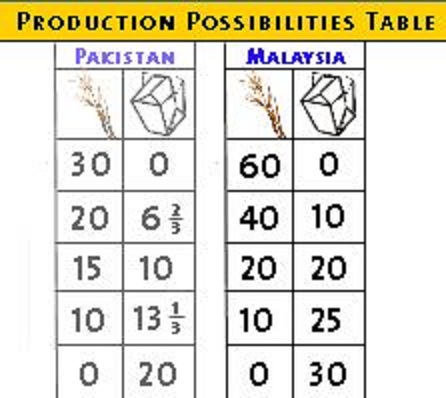
Supply and Demand (LESSONs 3a,
3b, and 3c)
LESSON 3a - DEMAND
2.1.1 (11:58) Understanding
the Determinants of Demand - 3a
- Outline:
- The determinants of
demand
- Building the demand
function
- The determinants of demand
- The determinants of
demand
- Building the demand
function
- The determinants of demand
- ME: In lesson 3a the authors list five
"non-price determinants" of demand, but in the video lecture
there are really only 4 non-price determinants of demand. Our
textbook adds: THE NUMBER OF POTENTIAL CONSUMERS that is not in
the video lecture.
- Textbook's non-price determinants of
demand: Pe, Pog, I, Npot, T
- Pe = expected price
- Pog = price of other goods
including the price of complements and the price of
substitutes
- I = income
- Npot = the number of potential
consumers
- T = tastes and
preferences
Video lecture's non-price determinants
of demand: Pc, Ps, M, Ta, Ex
- Pc = price of complementary goods
(Pog in the textbook)
- Ps = price of substitute goods
(also Pog in the textbook)
- M = income (I in the
textbook)
- Ta = tastes and preferences (T in
the textbook)
- Ex = expected price (Pe in the
textbook)
- we will be building a model of the
market
- the market is a place where
buyers and sellers trade some good or service determining
the price of the product and the quantity sold; interaction
between buyers and sellers
- demand is the quantity of a
good or service that households want and are able to
purchase in a given time period
- ME: our textbook defines demand as
a schedule that shows the various
quantities of a good or services that consumers are
willing and able to buy at various prices in a
given time period, ceteris paribus
- supply is the quantity of a
good or service that firms want ands are able to sell in a
given time period
- ME: our textbook defines supply as
a schedule that shows the various
quantities of a good or services that businesses are
willing and able to sell at various prices in a
given time period, ceteris paribus
- equilibrium is the market
condition in which the interaction of buyers and sellers
finds a particular price and quantity to be traded and from
which there is no incentive to move
- ME: our textbook defines market
equilibrium as the price where the quantity demanded
equals the quantity supplied
- demand describes the behavior of
households
- what are the factors (determinants) that
influence how much of a product (bread) consumers will
buy?
- the price of bread
- the price of complementary goods
(cheese or bologna)
- the price of substitute goods
(bagels)
- income
- tastes and preferences
- expectations of what might happen to
the price of bread in the future
- ceteris paribus
assumption: all other factors are held constant
- the price of bread
- Law of Demand: as the price of a good
or service increases, the quantity purchased generally
decreases, ceteris paribus; there is an inverse
relationship between the price of bread and the quantity
demanded
- Why?
- income effect: there is
a decrease in purchasing power when the price of bread
increases
- substitution effect:
when the price of bread increases people will
substitute other products in place of bread and buy
less bread
- ME: our textbook adds a third
explanation for the law of demand: diminishing
marginal utility -- as we consume more bread we
get less extra satisfaction from each additional piece
(i.e. we start to get sick of it) and therefore we
will not buy more unless the price is lower since we
are getting less satisfaction
- the price of complementary goods (cheese
or bologna)
- complementary goods are two goods for
which:
- a decrease in the price of one
leads to an increase in the demand for the other,
or
- an increase in the price of one
leads to a decrease in demand for the other
- they are goods that are used together
like butter or cheese or bologna that are used along with
bread
- so if the price of peanut butter goes
up a person will probably make fewer peanut butter
sandwiches and therefor the demand for bread will go
down
- the price of substitute goods
(bagels)
- substitute goods are two goods for
which
- an increase in the price of one
good leads to an increase in the demand for the other,
or
- a decrease in the price of one
leads to a decrease in demand for the other
- so if the price of bagels goes up
some people will switch to bread increasing the demand for
bread
- or if the price of bagels falls some
people will buy more bagels instead of bread which will
decrease the demand for bread
- ME: Tomlinson does make a few errors
in how he uses the terms "demand" and "quantity demanded",
but he will discuss and compare these concepts in a later
lecture
- income
- normal goods are goods where if your
income increases then the demand for that good will
increase
- if you have more money you will
buy more normal goods
- an inferior good is one where if your
income increases demand for the good will decrease
- if you have more money you will
buy fewer inferior goods
- examples: public transportation,
potted meat, beans,
- tastes and preferences
- if people decide that they now like
bread better than they did before then the demand for bread
will increase
- ME: the tastes and preferences
determinant is often used for everything else that may
influence the demand for a good or service
- expectations of what might happen to the
price of bread in the future
- if you think that the price will go
up in the future then the demand for bread will go up
now
- Building the demand function
- a mathematical expression that shows how
the quantity of bread that household will purchases is a
function of these variables
- Qd = D(Px, Pc, Ps, M, Ta,
Ex)
- ME: if we used the determinants and
abbreviations from the textbook then the demand function will
look like this: Qd=D(Pe, Pog, I, Npot, T) or P, P, I, N,
T
- NEXT: we will focus our attention on the
PRICE of the product itself and assume that all of the other
variables are held constant, or do not change, this way we will
construct the demand curve
- ME: For MY explanation of the demand and
supply determinants see: http://www.harpercollege.edu/mhealy/eco212i/lectures/ch3-18.htm
2.1.2
(11:54) Understanding the Basics of Demand - 3a
- Outline:
- The demand function
- The demand curve
- The law of demand
- Rationales behind the law of
demand
- The demand function
- a mathematical relationship that
predicts the quantity of a good demanded as a function of each
of the factors that influence consumer behavior
- Qd = D(Px, Pc, Ps, M, Ta,
Ex)
- ME: if we used the determinants and
abbreviations from the textbook then the demand function will
look like this: Qd=D(Pe, Pog, I, Npot, T) or P, P, I, N,
T
- we will focus our attention on the PRICE
of the product itself, ceteris paribus (assuming that
all of the other variables are held constant, or do not change)
this way we will construct the demand curve
- The demand curve
- the graphical relationship between the
price of a good and the quantity demanded, ceteris
paribus
- the demand schedule:
- a set of data showing the
relationship between price and quantity demanded, ceteris
paribus
- for each possible price of bread
there is a quantity that households will buy in a week,
ceteris paribus
- always label the axes when you draw a
graph in economics
- price on the vertical axis and
quantity purchased per week on the horizontal
axis
- plot the data from the demand
schedule
- note that there are many more prices and
many more quantities that those that we have on our demand
schedule so therefore we can connect the dots on our graph with
a smooth line which is the demand curve
- The law of demand
- the demand curve is downward sloping
which shows the law of demand
- there is an inverse relationship between
price and quantity demanded
- as the price of a good increases,
consumers are willing and able to buy less of it
- as the price of a good decreases,
consumers are willing and able to buy more of it
- note that there are a few exceptions,
but in general the law of demand
- Rationales behind the law of demand -- they
explain why the law of demand is true and why the demand curve is
downward sloping
- substitution effect: when the
price of bread increases people will substitute other products
in place of bread and buy less bread
- income effect: there is a
decrease in purchasing power when the price of bread
increases
- ME: our textbook adds a third
explanation for the law of demand: diminishing marginal
utility -- as we consume more bread we get less extra
satisfaction from each additional piece (i.e. we start to get
sick of it) and therefore we will not buy more unless the price
is lower since we are getting less satisfaction
2.1.3
(8:13) Analyzing Shifts in the Demand Curve - 3a
- Shifting the demand curve
- Assuming bread is a normal good, if
there is an increase in household income, what will happen to
the demand for bread?
- what will happens to the quantity
demanded at each possible price?
- note: we are keeping the other
non-price determinants of demand constant (ceteris
paribus)
- we get a NEW demand schedule so there
has been an increase in demand
- there will be a larger quantity of bread
"at every price"
- on the graph it looks like the demand
has shifted to the LEFT
- ME: note the direction of the
arrows. The demand shifts to the left (horizontally), it
does not shift up and to the right.
- A "Change in Quantity Demanded"
vs."Change in Demand"
- this is very important
- they are not the same
thing
- a change in quantity demanded
is caused by a change in the price and it is a movement
along a single demand curve
- a change in demand is caused by a
change in one of the non-price determinants of demand (not
price) and it results in a whole new demand curve
either to the right (increase in demand) or to the left
(decrease in demand) of the original demand curve.
- we have a new demand
schedule
- we have a new demand
curve
- therefore we have a change in
demand
- ME: You need to know the difference between
a "change in quantity demanded" and a "change in
demand". THEY ARE NOT THE SAME THING!
- I often ask students in my face-to-face
courses "if the price of pizza increases, what happens to the
demand for pizza?" The correct answer is NOTHING HAPPENS
TO THE DEMAND FOR PIZZA IF THE PRICE OF PIZZA GOES
UP.
- If the price of a product changes then
there is a "change in quantity demanded". On the graph
you would move from one point to another point along the SAME
DEMAND CURVE. The demand curve did not change, just the
quantity demanded changed
- In this video lecture we we discussed a
"change in demand" itself, i.e. creating a whole new
demand schedule and demand curve. When there is a change in
demand you get a new demand curve, or the demand curve will
shift to to a new position. This is NOT caused by a change in
the price of a product, but it IS caused by a change in the
"non-price determinants of demand" (Pe, Pog, I, Npot, T) that
we held constant when we developed the demand
concept.
2.1.4
(10:43) Changing Other Demand Variables - 3a
- Outline:
- Factors that influence consumer
demand
- Variables that shift the demand
curve
- Factors that influence consumer
demand
- a change in the quantity demanded
- P
 causes Qd
causes Qd
- P
 causes Qd
causes Qd
- If the price of a product changes
then there is a "change in quantity
demanded"
- the graph does not shift (there has
been no change in demand)
- a change in demand
- a change in one of the non-price
determinants of demand that previously were held constant
will cause a change in demand: a whole new demand
curve
- Variables that shift the demand
curve
- Video lecture's non-price determinants
of demand: Pc, Ps, M, Ta, Ex
- Pc = price of complementary goods
(Pog in the textbook)
- Ps = price of substitute goods (also
Pog in the textbook)
- M = income (I in the
textbook)
- Ta = tastes and preferences (T in the
textbook)
- Ex = expected price (Pe in the
textbook)
- Textbook's non-price determinants of
demand: Pe, Pog, I, Npot, T
- Pe = expected price
- Pog = price of other goods including
the price of complements and the price of
substitutes
- I = income
- Npot = the number of potential
consumers
- T = tastes and
preferences
- change in the price of other goods --
substitutes
- if there is an increase in the price
of bagels, this will cause an increase in demand for bread
(shift to the right)
- if there is a decrease in price of a
substitute good (bagels), there will be a decrease in demand
for the original product (bread)
- change in the price of other goods --
complementary goods
- if there is an increase in the price
of cheese, this will cause a decrease in demand for bread
(shift to the left)
- if there is a decrease in price of a
substitute good (cheese income), there will be an increase
in demand for the original product (bread)
- change in incomes and normal
goods
-
- definition: a normal good is one
where demand increase if income increase
- if incomes increase the demand for
normal goods will increase (shift to the right)
- if incomes decrease the demand for
normal goods will decreases
- change in incomes and inferior
goods
- definition: an inferior good is one
where demand will decrease if incomes increase
- Examples: beans, used clothing,
potatoes, public transportation, rice, ramen
noodles
- ME: note: a normal good for someone
might be a normal good for someone else
- ME: finally -- "inferior" does not
mean "lower quality"; all it means is we will buy less if
our incomes increase and more if our incomes
decrease
- if incomes increase the demand for
inferior goods will decrease
- if incomes decrease the demand for
inferior goods will increase
- ME: change in tastes and
preferences
- if preferences change in favor of a
product then demand will go up (shift to the
right)
- if preferences turn away form a
product then demand will go down (shift to the
left)
- change in expected price
- if you expect the price to go up in
the future then demand today will go up (shift to the
right)
- if you expect the price to down in
the future than demand today will go down (shift to the
left)
- ME: change in the number of potential
consumers (see the textbook)
- if the number of potential consumers
increases then demand for the product will increase (shift
to the right)
- if the number of potential consumers
decreases the the demand for the product will decrease
(shift to the left)
- Summary -- KNOW THIS !!!
2.1.5
(9:16) Deriving a Market Demand Curve - 3a
- Outline:
- Recall the Demand
Function
- The Market Demand
Curve
- Recall the Demand Function
- we have been discussing an individual
household's demand for bread
- now we will look at demand for bread in
the whole market where there are many households each with
different individual demand curves
- The Market Demand Curve
- let's assume that there are only two
people in the market: Bob and Ann
- in order to find the market demand we
add together the individual demand schedules; that is at
each price we add the quantities of all the individuals in
the market
- graphically the market demand is
the horizontal summation of all individual demand curves in the
market
- quantity is on the horizontal axis so
when we add the quantities of all individuals the result is the
market demand is the horizontal summation of all individual
demand curves in the market
- for any price we add the quantity
(horizontal distance to the demand curve) of all people in the
market to get the market demand curve
- anything that shifts the individual
demand curves will shift the market demand curve; the non-price
determinants of demand (Pe, Pog, I, Npot, T) will shift the
market demand curve
LESSON
3b - SUPPLY
2.2.1
(6:00) Understanding the Determinants of Supply - 3b
- Outline:
- The role of profits
- The determinants of supply
- Factors influencing supply through
impact on revenue: Price
- Factors influencing supply through
impact on costs:Pe, Pres, Pog, Tech, Taxes,
Nprod
- The supply function
- The role of profits
- profit = total revenue - total
cost
- when profits get larges sellers will be
willing to sell more; when profits get smaller sellers will
respond by offering less for sale
- The Determinants of supply
- Factors influencing supply through
impact on revenue: Price
- total revenue = price x quantity; TR
= P x Q
- low prices lead to low revenues,
therefore less is offered for sale by sellers
- high prices lead to high revenues and
therefore more is offered for sale by sellers
- Factors influencing supply through
impact on costs: Pe, Pres, Pog, Tech, Taxes, Nprod
- ME: our textbook discusses six
non-price determinants of supply, the video lecture only
discusses four of them
- Pe = expected price
- Pog = price of other goods
(textbook only) -- NOTE: an easier version of this
determinant is: price of other goods also produced by
the firm
- Pres = price of resources used to
produce the product
- Technology
- Taxes and Subsidies
- Nprod = number of producers
(textbook only)
- Pres = price of resources used to
produce the product
- price of the inputs (resources)
used to produce the product (bread)
- if prices of resources are low
then costs of production are low and therefore profits
are high AND businesses will offer more for
sale
- if the prices of resources rise
AND businesses will offer less for
sale
- Technology
- technology = what you know how to
do
- technology = how much output you
can get with a given quantity of inputs
- if technology improves THEN more
can be made with the same number of inputs THEN costs of
production are lower THEN businesses will offer
more for sale
- if technology worsens THEN less
can be made with the same number of inputs THEN costs of
production are higher THEN businesses will offer
less for sale
- why would technology worsen? it
is not likely but maybe government regulations require
a certain, less productive, technology
- Taxes and Subsidies
- if government taxes businesses it
will increase the costs of production and lose profits,
therefore businesses will offer less for
sale
- if the government subsidizes a
business, (i.e. gives it money for producing) then the
costs of production will go down and this will increase
profits and businesses will produce
more
- Pe = expected price
- if businesses expect the
price of their product will be higher in the future then
they will wait and produce less today
- if businesses expect the price of
their product to go down in the future they will try to
sell more now
- ME: Pog = price of other goods also
produced by the firm (textbook only)
- if the price of another good
also produced by the same seller goes up, businesses will
produce more of that good and less of the original
good
- if the price of another good
also produced by the same seller goes down, businesses
will produce less of that good and more of the
original good
- ME: Nprod = number of producers
(textbook only)
- if the number of sellers (or
producers) increases then businesses will be able and
willing to produce more
- if the number of producers goes
down, then businesses will produce
less
- The supply function
- the quantity of a product that
businesses are willing to sell will depend on: the price, price
of resources, technology, taxes and subsidies, expected price,
price of other goods, and the number of producers
- the supply function is a mathematical
relationship that predicts the quantity of a good supplied as a
function of each of the factors that influence supplier
behavior
- Qs = S(P, Pr, T, G, Ex Pog,
Nprod)
- ME: Qs = S(P, Pe, Pog, Pres, Tech, Tax,
Nprod)
2.2.2
(9:49) Deriving a Supply Curve - 3b
- Outline:
- The supply function
- The supply curve
- The law of supply
- Rationale behind the law of
supply
- The supply function
- Qs = S(P, Pi, T, G, Ex Pog,
Nprod)
- ME: Qs = S(P, Pe, Pog, Pres, Tech, Tax,
Nprod)
- in this video lecture will look at the
relationship between the price of a good and the quantity
supplied HOLDING CONSTANT all of the other factors
(determinants); how does the price of a product affect the
quantity supplied, ceteris paribus?
- The supply curve
- the supply schedule is a
set of data (table) showing the relationship between
price and the quantity supplied, ceteris
paribus;
- low prices lead to low
revenues, therefore less is offered for sale by
sellers
- high prices lead to high
revenues and therefore more is offered for sale by
sellers
- convert the supply schedule
into a supply graph
- always label the axes
- quantity on horizontal
axis and price on the vertical axis
- plot the data and connect
the dots
- ME: the study guide has
problems where YOU can do the actual graphing;
if graphs confuse or worry you then you should
do these problems
- the supply curve shows
the graphical relationship between the price of a good
and the quantity supplied, ceteris
paribus
|
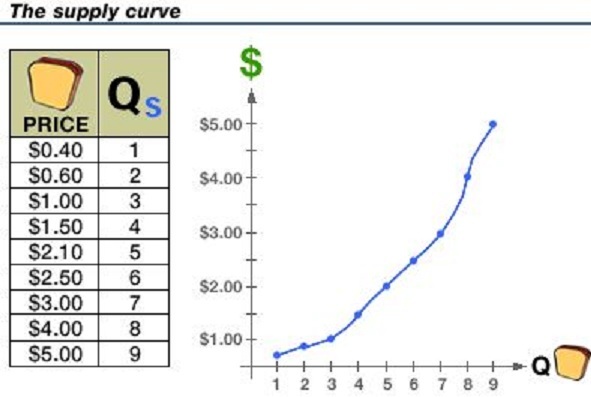
|
- The law of supply
- supply curves slope upward this
indicates a direct relationship between price and quantity
supplied
- the law of supply states that as
the price of a good or service increases, the quantity offered
for sale generally increases
- Rationale behind the law of supply
- ME: we will always explain the shape of
the graphs that we draw; we have already done this with the
production possibilities curve and with the demand curve;
make sure you understand the shapes of all the graphs in
this course.
- the law of increasing opportunity
costs helps explain the law of supply
- opportunity cost is the best
alternative that is given up; when a choice is
made
- the more bread that a baker offers
for sale, the higher the cost of producing each additional
loaf
- Why?
- the supply curves slopes upwards because
the opportunity costs rise as the business produces more and
more, so they will need a higher price or they will decide to
do something else
- also, we will see in a later video
lecture that the supply curve slopes upwards because the
marginal costs (the extra costs of producing one more,
increase
- ME: the textbook offers these
explanations for the law of supply:
- higher prices mean higher revenue for
the producer which is an incentive for he producer to
produce more
- as quantity increases the added cost
of producing one more unit of output (called the marginal
cost) increases because the factory will start to get
crowded
- finally, I like to add the law of
increasing cost that we used to explain the shape of he
production possibilities curve, since all resources are not
eh same as we increase production of a good we will have to
use less suitable resources (like less qualified workers)
which ill increase coses. so, businesses will not produce
more at a higher cost unless they can get a higher price to
cover those higher costs
2.2.3
(6:52) Understanding a change in Supply versus a Change in Quantity
Supplied - 3b
- Outline:
- Reviewing supply
- Supply and changes in the input
prices
- Graphing a change in
supply
- Change in quantity supplied vs.
change in supply
- Reviewing supply
- when we drew the supply curve we saw how
the quantity produced changed as we changed the price,
ceteris paribus
- ceteris paribus means that we
held constant everything else; only the price and quantity
changed
- determinants that were held
constant"
- Pi, T, G, Ex
- ME: Pe, Pog, Pres, Tech, Tax,
Nprod
- but what happens if these other factors
(ME: our textbook calls these the "non-price determinants of
supply") change?
- in this lessen we will only look at a
change in input (resource) prices, then int he next video
lecture will will look at the other factors (determinants) of
supply
- Supply and changes in the input prices
(price of resources)
- what happens if the price of
resources used to produce the good (inputs)
increase?
- profit will go
down
- and businesses will produce
less
- on the supply schedule we will
see a smaller quantity supplied AT EVERY PRICE;
- so on the supply schedule we
will see lower quantities supplied; at each price
the quantity supplied is lower; there is a new
supply schedule
- Graphing a change in supply
- so if the price of inputs goes
up, this will cause the supply curve to shift (move)
to the left
- so on the supply curve there
is a new supply curve further to the the left; the
supply has DECREASES (shifted to the
left)
|
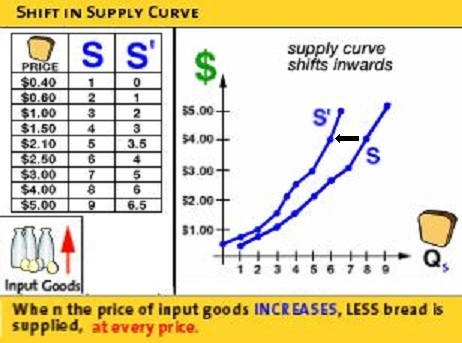
|
- Change in quantity supplied vs. change in
supply
- A change in the price of bread will
cause a change in quantity supplied which is a movement
along a single supply curve
- if one of the non-price determinants of
supply change then we get a whole new supply curve and we call
this a change in supply
- an increase in supply means
the supply curve shifts to the left
- a decrease in supply means the
supply curve shifts to the right
2.2.4
(8:47) Analyzing Changes in Other Supply Variables -
3b
- Outline:
- Factors that influence producer's
behavior
- Changes in the price of the
product
- Changes in variables held constant
when drawing the supply curve
- VIDEO: Pi, T, G,
Ex
- ME: Pe (Ex), Pog, Pres (Pi), Tech
(T), Taxes (G), Nprod
- Factors that influence producer's
behavior
- VIDEO: Qs = S(P, Pi, T, G, Ex
)
- ME: Qs = S(P, Pe, Pog, Pres, Tech, Tax,
Nprod)
- Changes in the price of the product
- if the price of changes then there is a
movement ALONG the supply curve because price is already on the
vertical axis
- we call this a change in the quantity
supplied
- Changes in variables held constant when
drawing the supply curve
- VIDEO: Pi, T, G, Ex
- ME: Pe (Ex), Pog, Pres (Pi), Tech (T),
Taxes (G), Nprod
- if there is a change in one of these
variables them the supply schedule changes and we get a whole
new supply curve
- we call this a change in
supply
 Pi
(change in the price of resources or inputs; Pres)
Pi
(change in the price of resources or inputs; Pres)
- if the price of resources
increases then costs increase and supply
decreases -- shifts to the left
- if the price of resources
decreases then costs decrease and supply
increases -- shifts to the right
- NOTE: a shifting of the demand curve
means the the quantity changes AT EACH POSSIBLE PRICE
- an increase in supply means
the quantity supplied increases at each possible price
and the supply curves shifts to the right
- a decrease in supply means
that the quantity supplied at each possible price
decreases and the supply curve shifts to the
left
(" "means "change in")
"means "change in")
 T
(change in technology)
T
(change in technology)
- if the technology improves
then productivity increases and costs of producing the
product will decrease and supply increases -- shifts
to the right
- if the technology gets worse
then productivity decreases and costs of producing the
product will increase and supply decreases -- shifts
to the left
 G
(changes in taxes and subsidies)
G
(changes in taxes and subsidies)
- if taxes increase then costs
of production increase and supply decreases -- shifts
to the left
- if taxes decreases then costs
of production decrease and supply increases -- shifts
to the right
- if subsidies increase then
costs of production decrease and supply increases --
shifts to the right
- if subsidies decrease then
costs of production increase and supply decreases --
shifts to the left
 Ex
(change in expected price; Pe)
Ex
(change in expected price; Pe)
- if sellers expect the price to
increase in the future then supply today will
decrease -- shift to the left
- if sellers expect the price to
decrease in the future then supply today will
increase -- shift to the right
- ME:
 Pog
(change in the price of other goods also produced by the
firm)
Pog
(change in the price of other goods also produced by the
firm)
- if a producer produces to different
products, let's say corn and soybeans, then if the price
of corn increases then producers will produce more corn
and the supply of soybeans will decrease -- shift to
the left; why plant soybeans if they can get a higher price
for their corn?
- if a producer produces to different
products, let's say corn and soybeans, then if the price
of corn decreases then producers will produce less corn
and the supply of soybeans will increase -- shift to
the right; they will be willing to sell more soybeans at
each possible price since profits from corn are
lower
- ME:
 Nprod
(change in the number of producers)
Nprod
(change in the number of producers)
- if the number of producers increases
then supply increases -- shifts to the right
- if the number of producers decreases
then supply decreases -- shifts to the left
2.2.5
(7:16) Deriving a Market Supply Curve from Individual Supply Curves -
3b
- Outline:
- Recall the supply
function
- The market supply
curve
- Recall the supply function
- VIDEO: Qs = S(P, Pi, T, G, Ex
)
- ME: Qs = S(P, Pe, Pog, Pres, Tech, Tax,
Nprod)
- The market supply curve
- market supply is the horizontal
summation of all of the individual supply curves in the
market
- for the market supply schedule we
add up the quantities at each price for ALL PRODUCERS; prices
stay the same and the quantities are added together
- therefore the market supply curve
will be further to the right as we add more
producers
- since the quantity is on the horizontal
axis we call this horizontal summation; prices stay the
same and the quantities are added together
- What will shift the market supply
curve?
- answer: anything that shifts the
individual supply curves
- VIDEO: Pi, T, G, Ex
- ME: Qs = Pe, Pog, Pres, Tech, Tax,
Nprod
- ME:
- REMEMBER: a change in the price of
the product itself will NOT shift (change) the supply
curve
- if the price of corn increases what
will happen to the supply of corn? Answer:
NOTHING
LESSON 3c - MARKET EQUILIBRIUM and EFFICIENCY
- PUTTING SUPPLY AND DEMAND TOGETHER
- MARKETS AND EFFICIENCY
2.3.1
(11:04) Determining a Competitive Equilibrium - 3c
- Outline:
- Definition of competitive
equilibrium
- Excess demand
- The bidding mechanism
- Excess supply
- A competitive
equilibrium
- Definition of competitive
equilibrium
- we will be putting what we have learned
about demand and supply together to create a model that will
help us to predict how factors in the environment will affect
the price of a product
- why are prices what they are and what
makes price change?
- competitive equilibrium:
- assumptions:
- there are many buyers and sellers
in the market
- who have no influence over the
price; i.e. they are price takers
- competitive equilibrium occurs
at the price where the quantity supplied equals the quantity
demanded
- equilibrium means that we have
a situation in which there is no tendency to change; a
situation in which neither consumers or firms have any
incentive to change their behavior
- there will be only one price in which
there is no pressure for something to change and that is the
price where the quantity demanded (Qd) equals the quantity
supplied (Qs); Qd=Qs
- graphically: the equilibrium will be
the price where the demand and supply curve cross; this is
the price where Qd=Qs
- Excess demand
- if the price is below the
equilibrium then the Qd > Qs and there will be excess
demand
- Excess demand is the difference
between the Qd and the Qs when consumers demand a greater
quantity than the suppliers are willing and able to supply;
i.e. when the price is below the equilibrium price
- if there is excess demand then there
will be a shortage
- The bidding mechanism
- if the price is below the
equilibrium then the excess demand this will cause the
price to go up so this is not the equilibrium
- this is called the "bidding
mechanism"; this is the process by which unsatisfied buyers
try to change the price of a good in order to guarantee that
they are able to obtain it; unsatisfied buyers will be willing
to pay a higher price to get the product
- Tomlinson uses the term "reservation
price"
- the bidding mechanism will continue to
drive the price up until the Qs=Qd and there is no more excess
demand
- Excess supply
- if the price is above the equilibrium
price then the Qd < Qs and there will be excess
supply, or a surplus
- excess supply (or a surplus) is the
difference between the quantity supplied and quantity demanded
when producers supply a greater quantity than consumers are
willing to buy; i.e. if the price is too high
- if there is an excess supply the bidding
mechanism will cause the price to fall as sellers try to sell
off their surplus
- as the price goes down the quantity
demanded will increase and the quantity supplied will decrease;
this means we will move down along the demand and supply curves
until we reach the price where Qd = Qs or where the curves
cross
- A competitive equilibrium
- occurs at the price where the quantity
demanded by buyers and the quantity supplied by producers are
equal
- now there is no excess demand and no
excess supply; there is no further tendency to change;
equilibrium has been reached
- on the graph the equilibrium will occur
where the supply curve and the demand curve intersect
(cross)
2.3.2
(7:02) Defining Comparative Statics - 3c
- Outline:
- Competitive
Equilibrium
- Three steps to finding a new
equilibrium when a non-price determinant changes
- identify which side of the market
is affected? (will it change demand or
supply?)
- how does the change affect the
curve? (will demand or supply increase [shift right]
or decrease [shift left]?)
- how does the equilibrium change?
(use the graph to see what happened to the equilibrium price
and quantity)
- ME: Our textbook does not use the term
"comparative statics", but instead uses the term "equilibrium"
which is also used in the video lectures
- Competitive Equilibrium
- equilibrium occurs at the price where
the Qs = Qd
- equilibrium will be at the price and
quantity where the supply and demand curves cross
- Three steps to finding a new equilibrium
when a non-price determinant changes
- we can use our model (graph) to predict,
or explain, how something in the environment (real world)
affects the equilibrium price and quantity of a
product
- anytime that there is a change in one of
the non-price determinants of demand or supply then there will
be a change int he equilibrium price and quantity
- Tomlinson says that there are three
steps:
- identify which side of the market is
affected? (will it change demand or supply?)
- how does the change affect the curve?
(will demand or supply increase [shift right] or
decrease [shift left]?)
- how does the equilibrium change? (use
the graph to see what happened to the equilibrium price and
quantity)
- ME: Four steps
- first determine which non-price
determinant has changed
- there are five non-price
determinants of demand: Pe, Pog, I, Npot, T (P, P, I, N,
T)
- there are six non-price
determinants of supply: Pe, Pog, Pres, Tech, Tax, Nprod
(P, P, P, T, T, N)
- if one of these 11 determinants
change then we will get a change in the price and
quantity of the product
- identify which side of the market is
affected? (will it change demand or supply?;
- did a non-price determinant of
demand change? or
- did a non price determinant of
supply change?
- will demand or supply increase
[shift right] or decrease [shift
left]?
- how does the equilibrium
change?
- GRAPH IT!
- then use the graph to see what
happened to the equilibrium price and
quantity)
- do not try to guess; draw
the graphs and shift a curve and then you can see what
happens to the equilibrium price and quantity
- example:
- what would happen to the price of
bread and the quantity sold if the price of bagels, a
substitute good, increases; price of bagels goes up so what
happens to the market for bread?
- 4 steps:
- first determine which non-price
determinant has changed
- demand: Pe, Pog, I, Npot,
T
- supply: Pe, Pog, Pres, Tech, Tax,
Nprod
- the non-price determinant that has
changed is: POG - substitute
- will it change demand or
supply?
- since price of substitutes is a
determinant of demand, then the demand curve will
shift
- how does the change affect the
curve?
- we have learned that if the
Pog-sub goes up this will increase demand for our
product
- price of bagels increasing will
cause the demand for bread to increase
- how does the equilibrium
change?
- GRAPH IT!
- shift the demand to the
right
- at the original price and with the
new demand curve we can see that there will now be excess
demand (Qd>Qs); this will create and excess demand and
the bidding mechanism will bid the price up
- from the graph we can see that
if the price of bagels increases this will
cause the price of bread to increase AND
people will buy more bread
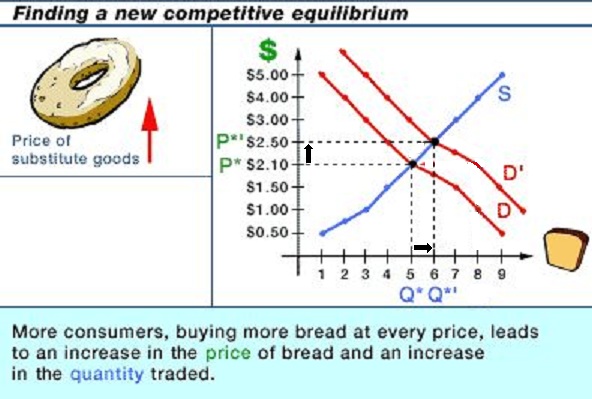
2.3.3 (13:04) Classifying
Comparative Statics (should be 3.4-2, but the link works) -
3c
- Outline:
- Comparative statics
- The demand curve shifts outward
(increase in demand)
- The demand curve shifts inwards
(decrease in demand)
- The supply curve shifts outwards
(increase in supply)
- The supply curve shifts inwards
(decrease in supply)
- ME: Our textbook does not use the term
"comparative statics", but it does discuss how the non-price
determinants of demand and supply affect the equilibrium price and
quantity and that is what the video lecture does here
- Comparative statics
- comparative statics is comparing one
state (condition) of a competitive equilibrium to another when
one of the variables affecting demand or supply
changes
- ME: NOTE --
- Goal: to see what happens to the
price of a good and the quantity traded (sold) when we
change one of the variables that we usually hold constant
when drawing the supply and demand curves
- there are only four
possibilities:
- The demand curve shifts outward
(increase in demand)
- The demand curve shifts inwards
(decrease in demand)
- The supply curve shifts outwards
(increase in supply)
- The supply curve shifts inwards
(decrease in supply)
- ME: but more than one variable could
change at the same time including one or more of demand and one
or more of supply; our textbook has example of
these
- The demand curve shifts outward (increase
in demand)
- demand shifts to the right causing
the price to increase and the quantity to
increase
- results in a shortage of the good at the
original price
- the price and quantity sold will
increase
- what could cause an increase in
demand?
- The correct change in the textbook's
non-price determinants of demand:
- Pe = expected price
- Pog = price of other goods
including the price of complements and the price of
substitutes
- I = income
- Npot = the number of potential
consumers
- T = tastes and
preferences
- KNOW THESE!!
- The demand curve shifts inwards (decrease
in demand)
- demand shifts to the left causing the
price to decrease and the quantity to decrease
- What would cause a decrease in
demand?
- The supply curve shifts outwards (increase
in supply)
- supply shifts to the right causing
the price to decrease and the quantity to
increase
- This would cause a surplus and the price
will begin to drop
- What would cause an increase in
supply?
- The correct change in the textbooks
non-price determinants of supply
- a change in the expected price
(Pe,)
- a change in the price of another good
also produced by the firm (Pog)
- a change in the price of resources
(Pres)
- a change in technology
(Tech,)
- a change in taxes or
subsidies
- a change in the number of producers
(Nprod)
- KNOW THESE!
- The supply curve shifts inwards (decrease
in supply)
- supply shifts to the left causing the
price to increase and the quantity to decrease
- What would cause a decrease in
supply?
- KNOW THESE!
3c - MARKETS
AND EFFICIENCY
Consumer
and Producer Surplus in the Linear Demand and Supply Model (10:01) -
3c
Free at: http://www.econclassroom.com/?p=2599
- Me:
- in lesson 1b we learned of the 5 ways to
reduce scarcity (the 5Es)
- in lesson 1d we also learned that
benefit cost analysis (marginal analysis) can be used to make
good decisions
- in lesson 2a we learned that market
economies tend to do well at reducing scarcity because they
tend to achieve allocative and productive
efficiency
- In lesson 3c we learned that in
competitive market economies prices are determined by demand
and supply
- Here we will put it all together to see
why market economies achieve allocative efficiency
- we will use two models to show why
competitive market economies achieve allocative
efficiency
- benefit cost analysis (marginal
analysis)
- consumer and producer
surplus
- consumer surplus is the extra
benefit enjoyed by the consumers in a market who pay less for
a product than they were willing and able to pay for it
- the demand curve also represents the
marginal benefit of all the consumers in this market:
D=MB
- ME: our textbook uses the term Marginal
Social Benefit (MSB) to measure the MB
- remember the demand curve is downward
sloping because of diminishing marginal utility (MU =
MB)
- ME: the price the consumers are willing
to pay for a product represents the benefits that they expect
to get from it. If you get a lot of benefit from something
(like skiing in Colorado) you would be willing to pay a higher
price than you would for something that gives you less benefits
(like skiing in Wisconsin)
- the area below the demand curve, but
above the equilibrium price, represents the total extra
benefit of all the consumers in a market, called consumer
surplus
- calculate the area of the consumer
surplus triangle to get the numerical measure of consumer
surplus
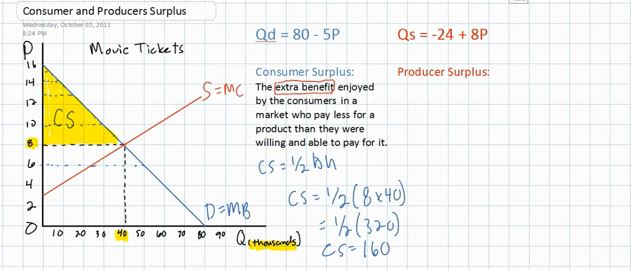
- producer surplus is the extra
benefit enjoyed by the producers in a market who sell their
product for more than they are willing and able to sell if
for
- the supply curve also represents the
marginal costs of all of the producers in the market: S =
MC
- ME: our textbook uses the term Marginal
Social Cost (MSC) to measure all of the MC of
production
- remember the points on the supply curve
shows the various prices that firms are willing and able to
offer their product for sale
- you can see that there are points on the
supply curve that are below the equilibrium price.
- the difference between what a firm is
willing to sell and product for (the supply curve) and what
they can sell it for (the equilibrium price) is the consumer
surplus
- the area above the supply curve, but
below the equilibrium price, represents the total extra
benefit of all the sellers in a market, called producer
surplus
- calculate the area of the producer
surplus triangle to get the numerical measure of consumer
surplus
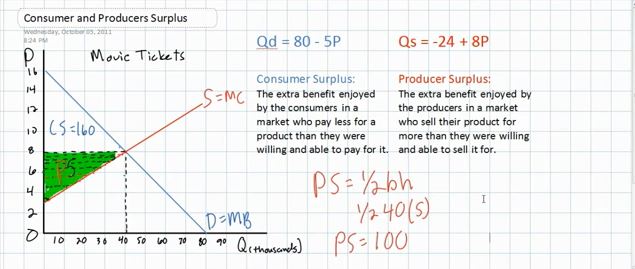
- allocative efficiency
- we can see that at the equilibrium price
in a competitive market the total surplus (benefits) is
maximized; that is, the total of consumer surplus and producer
surplus is as large as possible
- what if the price is NOT at the
equilibrium?
- if the price is greater than the
equilibrium then producers would want to sell more BUT
consumers will buy less, and the total surplus to society
will be less
- we can show the loss of satisfaction
to society on the graph (purple triangle)
- ME:
- this is called the dead weight
loss
- this is not allocatively
efficient; society is not maximizing its
satisfaction
- also you can see that at the
higher price and lower quantity the MB > MC (or MSB
> MSC); we learned in lesson 1d that if the MB > MC
then we want more; we gain more than it costs us so our
satisfaction will increase
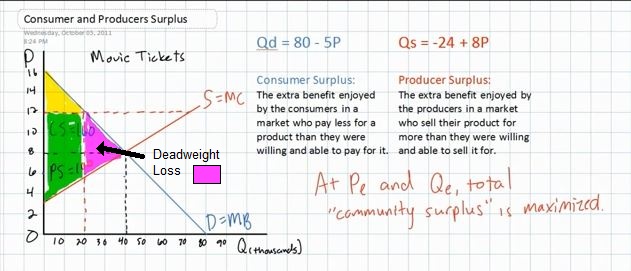
Supply,
Demand, and Economic Efficiency - 3c
Read: http://www.harpercollege.edu/mhealy/eco211/lectures/s%26d/sdeff.htm
Efficiency
and Equilibrium in Competitive Markets (11:48) - 3c
Free at: http://www.econclassroom.com/?p=2611
assumes knowledge of consumer and producer surplus, also uses benefit
cost analysis
- Efficiency exists in a society when
no individual in society can be made better off without making
someone else worse off
- Allocative efficiency occurs when the MB =
MC (MSB = MSC)
- the demand curve is downward sloping
indicating that society is getting less extra satisfaction (MB)
from consuming more
- the supply curve is upward sloping since
the MC of producing more goes up as resources become more scarce
(ME: AND as we need to use less suited resources to produce our
product)
- Allocative efficiency occurs at the
equilibrium price and quantity because the total of consumer and
producer surplus is maximized at the equilibrium; ME: this is also
where the MB = MC (MSB = MSC)
- what if the quantity is less than the
equilibrium quantity?
- we get allocative inefficiency
because the MSB > MSC
- we say that we have an
underallocation of resources; too few resources are
being used to produce the product; we are getting a lot of
benefits (MB is high) and the costs to society is low (MC
is low)
- this means we want more or we would be
happier if we had more
- there is also a loss of total surplus to
society; even though producer surplus may increase, consumer
surplus decreases a lot and there is a loss to society, called
the dead weight loss (or welfare loss; "welfare" means
satisfaction)
- society is less satisfied and we have
allocative inefficiency
- what if the quantity was greater than the
equilibrium quantity?
- we get allocative inefficiency
because the MSB < MSC
- we say that we have an overallocation
of resources; too many resources are being used to produce
the product; we are getting few benefits (MB is low) and
the costs to society is high (MC is high)
- this means we want more or we would be
happier if we had less of this product (and more of something
else that makes us happier)
- there is also a loss of total surplus to
society; the dead weight loss (or welfare
loss)
- in order to get producers to produce
more they would need a higher price
- this would decrease consumer surplus and
even though producer surplus would go up a little th3ere is a
net loss to society, the dead weight loss
- in a market economy society's satisfaction
is maximized at the equilibrium price and quantity
- ME:
- of course the equilibrium price ans
quantity is WHAT WE GET, because it is here that producers will
make the biggest profit
- the allocatively efficiency quantity is
WHAT SOCIETY WANTS because they maximize their
satisfaction
- in a competitive market economy (with no
externalities -- lessons 5a and 5b) WHAT WE GET = WHAT WE WANT
and we achieve allocative efficiency
- This is the "invisible hand" of
capitalism that Friedman discussed in the previous video in
lesson 2a [Power
of the Market (YouTube LibertyPen
1:14)]
- ME: our textbook shows the dead weight loss
that results from overproduction a little differently than does
the video (see page 98 and the figure below)
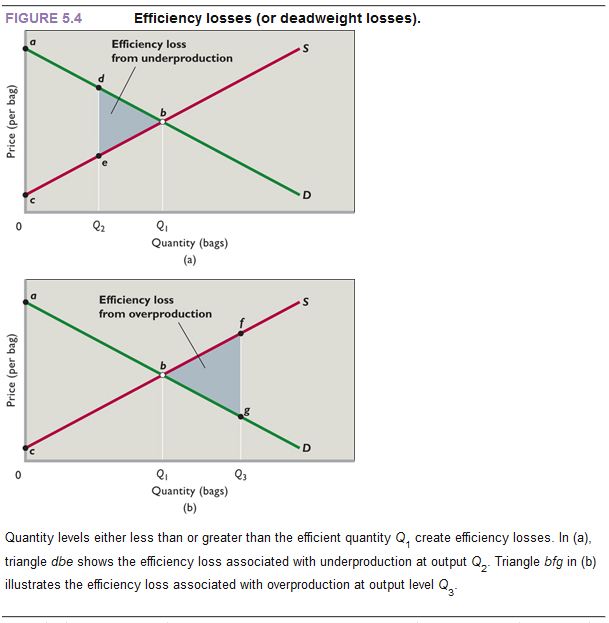
Market Failures and
Externalities (LESSONs 5a and 5b)
LESSON 5a - GOVERNMENT
INTERFERENCE IN MARKETS and NEGATIVE EXTERNALITIES
- GOVERNMENT INTERFERENCE IN MARKETS: Price
Ceilings and Floors
- MARKET FAILURE:NEGATIVE
EXTERNALITIES
GOVERNMENT INTERFERENCE IN MARKETS: Price
Ceilings and Floors
2.5.1 (9:38) Understanding
How Price Controls Damage Markets (Price Ceilings) -
5a
- Outline:
- Price controls in rental
housing
- Reduction in supply (error -- they
really mean a reduction in the QUANTITY
SUPPLIED)
- Non-price competition
- Deadweight loss and
rent-seeking
- Price controls for concert
tickets
- Price controls in rental housing
- why put on a price control below the
equilibrium price? -- to help the poor
- graph
- effects
- cheating and they avoid the rent
controls
- a shortage caused by the
reduction in the quantity supplied and and increase in the
quantity demanded
- dead weight loss for society;
allocative inefficiency
- rent seeking = non-price
competition
- Reduction in QUANTITY SUPPLIED (slight
error on the video)
- fewer apartments will be available at
the low government-set price
- Deadweight loss and rent-seeking
- the Qd > Qs and we have a shortage
(excess demand)
- usually the bidding mechanism will cause
the price to go up
- but the price cannot legally be raisedc
above the ceiling price
- The video lecture will
ask you a multiple choice question. ANSWER THE QUESTION by
selecting A, B, or C and more of the lecture will
follow
- non-price competition
- people who want an apartment will
need to do all kinds of other things to compete for the few
apartments available which will cost the apartment seekers
more
- using more resources but not giving
society any additional value
- both consumer and producer surplus
are decreased and society losses the deadweight loss AND the
rent seeking activities
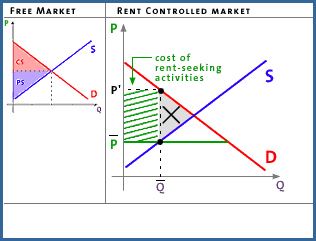
- Price controls for concert tickets
- shortage of tickets
- loss to society:
- standing in line
- scalpers
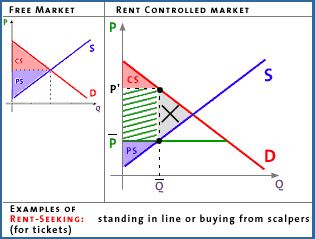
- putting on price controls does not help
the poor
- the rich can afford to buy from
scalpers
- price controls rarely achieve their
goal
2.5.2
(14:47) Understanding the Problem of Minimum Wages in Labor Markets
(Price Floor) - 5a
- Outline:
- Unintended
consequences
- The supply and demand
curves
- Substitution effect and income
effect
- Minimum wage with supply and
demand
- Unintended consequences
- Goal: to raise the income of unskilled
workers
- but does it actually harm low wage
workers?
- The supply and demand curves
- price = hourly wage
- quantity is the quantity of labor
supplied by workers or demanded by employers
- Substitution effect and income
effect
- when the wage rate declines more labor
is hired (demand is downward sloping)
- as labor gets less expensive the
costs of production go down and businesses will produce more
which requires more labor
- as labor gets less expensive
employers will substitute more labor in place of some other
input, and employ more labor
- when the wage rate increases more labor
is supplied (supply is upward sloping)
- controversial:
- substitution effect: work
or pleasure? -- as the wage rate increases the
opportunity cost of leisure increases and workers will
substitute work for leisure
- income effect: work or
leisure? -- the effect on worker behavior when incomes
rise
- is wages increase workers may
work less since now workers can afford to pay bills by
working fewer hours and then take more
leisure
- what would you do if your wage was
doubled? -- work more or work less?
- we'll assume that the substitution
effect is stronger and the supply of labor curve is upward
sloping
- Minimum wage with supply and demand
- in a free market the equilibrium wage
rate will occur where Qs = Qd; where the curves
cross
- what happens if the government sets a
minimum wage rate that is higher then the equilibrium?
- this is a price floor; the
wage cannot go below the minimum
- effects:
- the quantity supplied of labor
will increase because wages are higher and more
people will want to work
- the quantity demanded of labor
is reduced because a higher rage increases the costs
of production and businesses will produce less and need
fewer workers and the higher wage will encourage
businesses to substitute other resources in place of
labor and therefore fewer workers will be
hired
- Unintended consequence:
- Qs > Qd and there is an
excess supply of labor; this is unemployment;
the higher minimum wage causes unemployment
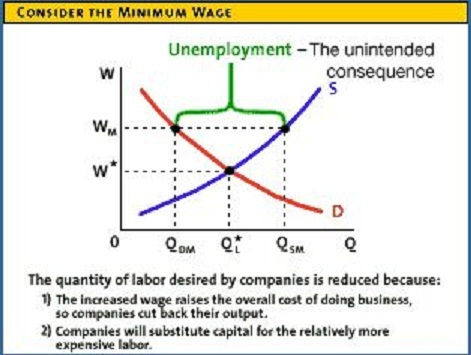
- since some workers are willing
to work for less than the minimum wage employers will
be able to pass some of the costs onto the
workers
- dead weight loss for
society; there are jobs where the MB to society is
greater then the MC but because of the minimum wage
they will not be filled
- Note: if the minimum wage is set
below the equilibrium then it will have no effect
because the market forces will bid the wage up to the
equilibrium; wages can be higher than the minimum wage but
not lower
- ME: the video shows that an effective
minimum wage will cause unemployment of unskilled workers,
but it doesn't ask HOW MUCH unemployment and HOW MUCH more
will low-wage workers earn? Do minimum wage laws help the
poor or hurt the poor?
- unemployment hurts the
poor,
- but if only a little unemployment
is created and the vast majority of workers earn higher
incomes then overall, the wage income of the poor will
increase. We will discuss this in the lesson on
elasticity.
Determining
the Effects of Price Ceilings and Price Floors - 5a
http://www.econclassroom.com/?cat=13
- Price Floor is a minimum price for a
good established by the government at a level above the free
market equilibrium price (butter in Europe)
- the goal of a price floor is to raise
the price to help the producers
- therefore the Qs will increase (move
along the supply curve)
- and, the Qd will decrease (move along
the demand curve)
- result: a surplus will be
created
- efficiency effects:
- consumers will buy less at the higher
price and the amount of consumer surplus will
decrease
- since the quantity sold decreases,
the producer surplus does not increase by as much as
we might expect
- net effect of the price floor:
- dead weight loss of
satisfaction (or welfare) to society
- allocative inefficiency:
ether will be an overallocation of resources but
the quantity demanded by consumers will be
lower
- this creates a surplus
- ME: Note: if the price floor is set
below the equilibrium then it will have no effect because
the market forces will bid the price up to the equilibrium;
prices can be higher than the price floor but not lower
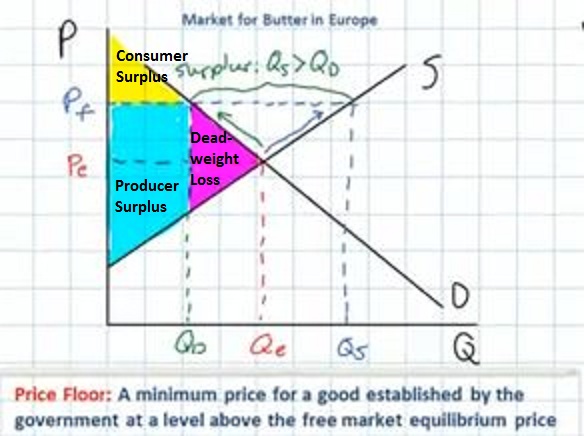
- Price Ceiling is a maximum price for
a good established by the government at a level below the free
market equilibrium price (gasoline [petrol] in
China)
- the goal of a price ceiling is to reduce
the price to help the consumer
- therefore the Qd will increase (move
along the demand curve)
- and, the quantity supplied will decrease
(move along the supply curve)
- resulting is a shortage since the
Qd > Qs
- efficiency effects:
- the actual quantity available will be
less
- this will increase consumer
surplus, but not by as much as we might expect due to
the lower quantity available
- producer surplus is less due to the
lower price
- there is a dead weight loss of
satisfaction for society
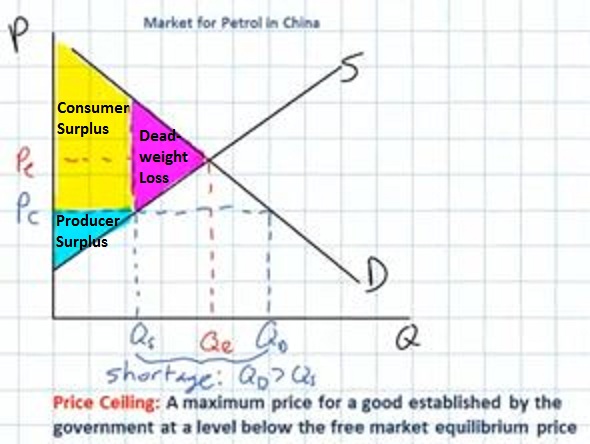
- ME: Note: if the price ceiling is set
above the equilibrium then it will have no effect because
the market forces will only bid the wage up to the equilibrium;
prices can be lower than the price ceiling but not
higher
- Summary:
- a price floor reallocates welfare
(satisfaction) from producers to consumers but overall causes a
net loss of satisfaction, i.e. allocative inefficiency, since
there is a surplus; an overallocation of resources
- a price ceiling reallocates welfare
(satisfaction) from consumers to producers but overall causes a
net loss of satisfaction, i.e. allocative inefficiency, since
there is a shortage; an underallocation of
resources
MARKET
FAILURE: EXTERNALITIES
Negative
Externalities
8.4.1
(5:46) Defining Externalities - Negative Externalities -
5a
- Outline:
- Definition of
Externalities
- External Costs (also called Negative
Externalities or Spillover costs)
- External Benefits (also called
Positive Externalities or Spillover Benefits)
- The Problem with
Externalities
- if there are positive externalities -
Definition of Externalities
- ME: in a previous lesson we learned that
a competitive market economy achieves allocative efficiency.
Adam Smith called this the "invisible hand" of capitalism. We
said "what we get = what we want". A market failure
occurs when the market does not achieve allocative
efficiency
- an externality is a cost or a
benefit that can be passed on to others
- External Costs (also called Negative
Externalities or Spillover costs)
- an external cost (or negative
externality or spillover cost) is a cost of a transaction that
is borne by someone who is not a party to that transaction; not
the buyer and not the seller, but someone else must pay part of
the cost of the transaction
- examples: pollution created by the
production of a product; second hand smoke from cigarettes;
painting your house an ugly color makes your neighbors
"
- External Benefits (also called
Positive Externalities or Spillover Benefits)
- an external benefit (or positive
externality or spillover benefit) is a benefit of a transaction
that is received by someone who is not a party to that
transaction; not the the buyer and not the seller, but someone
else benefits without paying
- examples: you get a flu shot and others
around you are protected from getting the flu from you, they
benefit from you getting the shot
- The Problem with Externalities
- Market failure occurs --
the free market does not produce the quantity that maximizes
society's satisfaction = allocative
inefficiency
- we saw in previous lectures that usually
supply and demand in a market economy has the result of
producing the allocatively efficient quantity; what we get =
what we want
- a private business will look at the
marginal benefits and the marginal costs of producing more and
will produce as long as the MB > MC, BUT when there are
negative externalities the costs to the firm are less
than the total costs to society since they can avoid some costs
by passing them on to others. the result is too much will be
produced = an overallocation of resources
- if there are positive
externalities consumers look at the MB and MC. BUT they do
not include all of the benefits since some of the benefits have
spilled over onto some one else. The result is the consumers
see lower benefits that society does and too few will be
consumed = an underallocation of resources
Internalizing
an Externality
8.4.2
(11:58) Explaining How to Internalize External Costs (Negative
Externalities) - 5a
- Outline:
- How negative externalities cause
market failure
- How to correct for that market
failure
- How negative externalities cause market
failure
- assume you have a company that causes a
pollution when it produces its product (boxes)
- then the private costs to the firm
are less than the true social costs of
production
- how do we calculate these external
cost?
- measure the costs of how much it
would cost to prevent the pollution
- or how much it would cost to clean
up the pollution
- or how much you would have to pay
the people who suffer from the pollution to accept
it
- economists will measure these
external costs by choosing the least expensive
measure
- result:
- from the viewpoint of society all
quantities should be produced as long as the MB are
greater than the marginal social costs (the private costs
plus the external costs
- from viewpoint of the producer
they will continue to produce as long as the MB are
greater then just the private costs
- the result will be that the
producer will produce MORE THAN the optimal quantity for
society. We call this an overallocation of resources. the
market failed to achieve allocative
efficiency.
- How to correct for that market
failure
- the principle of the second best: the
best method to be used in a market failure is the one that most
precisely corrected for the original problem
- although it would be best if there were
no negative externalities then businesses would produce the
allocatively efficient quantity and society's satisfaction is
maximized,
- but if there are negative externalities
then the second best solution or society is to find a method
that best approximates the efficient outcome
- we call this "internalizing the
externality": make the producer pay the external costs;
then the total private costs will be the same as society's
costs
- How?
- by putting a tax on the seller for
each one that they produce that is equal to the size of the
external costs
- since this will raise the producer's
costs, they will produce less
8.5.1
(12:21) Finding a Market Solution to External Costs -
5a
- Outline:
- Supply and demand
diagrams
- Correcting the
externalities
- Applying the principle of the second
best
- Re-creating a missing
market
- Quick review
- Supply and demand diagrams
- if the demand represents marginal social
benefits (MSB) and the supply equals marginal social costs
(MSC) then the equilibrium quantity that we get (where Qs = Qd)
will be the same as the allocatively efficient quantity that we
want (where MSB = MSC); i.e.when there are no externalities,
markets achieve allocative efficiency
- ME: when Tomlinson talks about
maximizing economic value I use the term achieve
allocative efficiency (which is producing the
quantity that maximizes society's satisfaction
[value])
- but what happens if there are negative
externalities, or external costs, that the firm does not have
to pay?
- if there are negative externalities
than the private costs to the firm are not the same as the
costs to society
- Tomlinson uses the term "reservation
price" which is the highest price a buyer is willing to pay
for a good or service. This reservation price is a measure
of the marginal benefits that the buyer receives
- the supply curve for the business
will be to the left (below) the costs to society (MSC)
because since the firm avoids paying hate external costs
their costs are lower and when costs go down we know that
supply goes up (shifts to the right)
- the vertical distance between the MSC
curve and the supply curve is the value of he external
costs
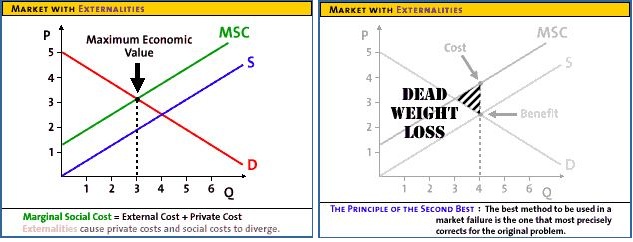
- quantity 3 is the allocatively
efficient quantity; what we want
- quantity 4 is the profit maximizing
quantity; what we get
- if there are negative externalities
then too much will be produced (overallocation of resources)
resulting in a loss of satisfaction to society = dead weight
loss = allocative inefficiency
- Correcting the externalities
- to make the producer internalize the
externality we could tax them. a tax on the product will
decrease the supply and cause the profit maximizing quantity to
decrease.
- if the tax is equal to the value of the
external cost then the producer's supply curve will become
equal to the MSC curve and allocative efficiency will be
achieved
- Applying the principle of the second
best
- find out what the problem is then find a
policy that will precisely as possible offset the original
problem
- like a tax on boxes if the production of
boxes cause pollution
- Re-creating a missing market: a tax on
pollution
- but boxes are not the problem, pollution
is the problem
- so we could get a similar outcome if we
could tax producers for the pollution; this would also increase
their costs and they will produce less -- and pollute
less
- but they could also try to find a way to
pollute less so that they will not have to pay as much
pollution tax, This is good for society AND it would not occur
if we taxed the boxes
- how do you calculate a pollution
tax?
- you could do scientific studies to
estimate the social costs of the pollution
- OR you can set up a market for pollution
permits
- the buying and selling of these
pollution permits will result in a market price for
them
- to avoid paying for pollution permits
firms will try to reduce pollution
- or environmental groups may buy some
of he permits and not use them to reduce pollution even
more
- problem with an externality is that
there is a missing market like a market for
pollution
- Quick review
Introduction
to Market Failure and Negative Externalities of Production
(econclassroom.com 14:45) - 5a
http://www.econclassroom.com/?p=2850
- A Market Failure exists
whenever the free market equilibrium quantity of output is greater
or less than the socially optimal (also called
"allocatively efficient") level of output. the free market will
produce either too much or too little.
- failed to achieve the socially optimal, or
allocatively efficient, level of output.
- but what is the allocatively efficient
level of output
- graph:
- supply represent the marginal costs of
production
- demand represents the marginal benefits
that consumers receive (ME: if there are no positive
externalities then d=MSB [marginal social
benefit]
- Negative externalities (also called
spillover costs and external costs)
- exist whenever the production of a good
creases spillover costs for society that are not born by the
producer of the good;
- MPC (marginal private cost) are
the costs paid by the producer of the product
- MSC (marginal social cost) are
all the costs to society including the MPC plus any external
costs (negative externalities)
- MPB (marginal private benefits)
are the benefits received by the buyers of the
product
- MSB (marginal social benefits are
all of the benefits to society from the production and
consumption of a product including the MPB plus any external
benefits (positive externalities)
- graph: when there are negative
externalities then the firm AVOIDS some costs so the costs to
the firm are lower; therefore the MSC are greater than the
MPC
- examples: if the production of a good
creates pollution that the firm does not need to clean up;
health costs that the firm can avoid paying
- the point is the MSC >
MPC
- the socially optimum quantity (or
the allocatively efficient quantity) occurs where MSC =
MSB; the is WHAT WE WANT
- the equilibrium quantity (the
profit maximizing quantity) occurs where Qd = Qs; this
is WHAT WE GET
- you can see on the graph that when there
are negative externalities the producers will produce too much,
the profit maximizing quantity that we get is greater than the
allocatively efficient quantity that we want; we say that there
is an overallocation of resources
- ether is a dead weight loss to
society; less satisfaction for society; if less was produced
then society would be better off (have more
satisfaction)
- what can the government do to increase
society's satisfaction?
- usually when the government gets
involved in the market id causes inefficiency (less
satisfaction)
- but when there are negative
externalities the market itself is inefficient (too much is
being produced) and the government might be able to make it
more efficient
- an excise tax is a per unit
tax on the production of a good; we should know that a
tax is a non-price determinant of supply and when the tax
goes up, costs go up and supply goes down
- if the government can set the tax
exactly equal to the size of he per unit external costs
then the supply curve will move back to the MSC
curve.
- then, with the tax, the profit
maximizing quantity that we get (where Qd = Qs) will be
the same as the allocatively efficient quantity (where
MSB = MSC) that we want
- consumer surplus, producer
surplus, and tax revenue
- a tax on the production of goods
that creates negative externalities is a corrective tax
that increases society's welfare (satisfaction gained =
purple triangle;) allocative efficiency is
increased
Coase
Theorem
8.5.2
(12:45) Finding a Negotiated Settlement to an External Cost -
5a
- Outline:
- Government action vs.
bargaining
- 2 companies operating
independently
- 2 companies
cooperating
- Definition of the Coase
Theorem
- Government action vs. bargaining
- Review: when there are negative
externalities the government can correct for the overallocation
of resources by taxing the production or regulating the
producers
- here we explore the Coase Theorem that
says that under certain circumstances bargaining can solve the
problems created by negative externalities without the
government
- Example:
- boxes have a price of 50 cents which
represents the marginal social benefit (MSB)
- box producer pollutes lake and saves
25 cents per box
- beers have a price of $1 which
represents the marginal social benefit (MSB)
- beer brewer uses water from the lake
for free, but if the lake is polluted by the box maker then
it costs the brewer 50 cents to clean the water before
making the beer
- 2 companies operating independently -- if
the box maker and beer brewer are acting independently
- then the box maker will pollute the lake
to make greater profits (profits = 50 cents)
- the beer brewer will then have to spend
50 cents per beer to clean the water and profits will be 50
cents
- total profit = 50 cents + 50 cents =
$1.00
- 2 companies cooperating
- What if they cooperate (work together)?
could they find a solution that benefits them both?
- Since it costs the box maker only 25
cents not to pollute, but it costs the beer brewer 50 cents to
clean the polluted water before brewing the beer
- What if the beer brewer offers to pay
the box maker the 25 cents that it would cost not to pollute in
the first place?
- then the beer brewer is earning a
bigger profit of 75 cents ($1 price minus 25 cents to pay
the boxmaker not to pollute
- and the beer brewer could then use
some of that extra profit to encourage the box maker to go
along with the deal.
- the box maker says that as long as the
brewer is paying me the 25 cents that it costs to clean up my
pollution PLUS a little extra, then they gain from
cooperating
- RESULT: they both come out ahead since
the total profits are higher -- total profit = 50 cents for
the box maker plus 75 cents for the brewer =
$125
- it doesn't matter who owns the lake. The
total economic value will remain the same and the lake will not
be polluted only the distribution of the total economic value
is affected by ownership of the lake
- Definition of the Coase
Theorem
- when two parties can get together with
negligible cost, then the result of that bargain will be one
that maximizes economic value of the situation
- also, then property ownership will not
affect the outcome of that decision
- only the distribution of the economic
value will be affected by property ownership
8.5.3
(7:02) Applying the Coase Theorem - 5a
- Outline:
- Example of the Coase
Theorem
- Example of additional
parties
- When is government action
necessary?
- Review of the Coase
Theorem
- Example of the Coase Theorem
- benefit of a box (price) =
$.50
- benefit of a beer = $1.00
- cost of cleaning up the pollution for
the brewer = $.25 (lower than previous lecture)
- cost of preventing pollution to the box
maker = $.50
- note: the cost to prevent pollution
> the cost to the brewer to clean it up
- when the lake is polluted the total
profit = $.50 + $.75 = $1.25
- if they try to negotiate:
- brewer is only willing to offer up to
$.25 to the box maker to have then not pollute
- but the box maker saves $.50 by
polluting
- so they will be unable to reach an
agreement
- total profit if the box maker pollutes =
$.50 + $.75 = $1.25
- total profit if the box maker does not
pollute: $0 + $1.00 = $1.00
- result: more total profit if the lake is
polluted
- so the Coase theorem still produces the
result that maximizes total value (satisfaction) for
society
- Example of additional parties
- but what if other people (like swimmers)
are also affected by the pollution from the box
maker
- a polluted lake will take satisfaction
(value) from the swimmers
- could they negotiate with the box maker
not too pollute??
- they could, but
- if there are so many swimmers it
might make it too difficult; the transaction costs would be
too high
- so they probably would not
negotiate
- result: when there are too many parties
involved making hate transaction costs of private negotiations
too high, there will be no negotiations and the market will
fail to maximize society's satisfaction; allocative efficiency
will not be achieved
- When is government action necessary?
- when there are too many parties involved
making hate transaction costs of private negotiations too high
a market failure results and we will need government to correct
for the market failure
- government can force the box maker to
clean up the pollution to increase society's
satisfaction
- Review of the Coase Theorem
- when two parties can get together, with
negligible cost, then the result of private bargaining will be
one that maximizes economic value for society
- also, the property ownership will not
affect the outcome of the negotiations; only the distribution
of the economic value will be affected by property
ownership
- however, if the transaction costs are
high, like if there are many affected parties, then it may be
better for society to have the government help manage the
externality
LESSON
5b - POSITIVE EXTERNALITIES and PUBLIC GOODS
- MARKET FAILURE: POSITIVE
EXTERNALITIES
- MARKET FAILURE: PUBLIC GOODS
8.4.3
(5:34) Explaining How to Internalize External Benefits (Positive
Externalities) - 5b
- Outline:
- External benefit and a market
failure
- Subsidy correcting a market
failure
- The principle of the second
best
- External benefits and a market
failure
- Get a flu shot? -- yes, as long as the
MB>MC
- but the benefits of the flu shot to
the individual do not include the external benefits that the
shot has on society; so the benefits to the individual are
less that the total benefits and since the benefits are less
there will be fewer flu shots than the quantity that is best
for society
- there will be quantities where the
marginal benefits to society are greater than the marginal
costs, and society would gain if the person got the shot BUT
since the individual only looks at their private benefits
which could be less that the marginal costs and if MB<MC
we will choose not to do that thing
- Result:
- there will be too few flu shots
from society's viewpoint
- what we get < what we
want
- dead weight loss to
society
- External benefit and a market
failure
- so what can be done?
- goal is to increase the quantity (have
more people get flu shots)
- Subsidy correcting a market failure
- a subsidy to the consumer will allow
them to internalize the external benefit
- give them money for getting a shot which
will increase their private benefits and more people will get
shots
- if the subsidy make the private benefits
equal to the social benefits then the quantity of shots
received will equal the allocatively efficient
quantity
- The principle of the second
best
Market
Failure: Positive Externalities of Consumption (econclassroom.com
10:61) - 5b
http://www.econclassroom.com/?p=2871
- A positive externality occurs when
the consumption of a good or service creates benefits for society
beyond those enjoyed by the individual consumer
- when there is a positive externalities the
MSB (all the benefits that society, including the consumer, gets
from that product) are greater than the marginal private benefits
(just the benefits that the consumer gets.
- graph -- market failure:
- MPC (marginal private cost) are
the costs paid by the producer of the product
- MSC (marginal social cost) are
all the costs to society including the MPC plus any external
costs (negative externalities)
- MPB (marginal private benefits)
are the benefits received by the buyers of the
product
- MSB (marginal social benefits are
all of the benefits to society from the production and
consumption of a product including the MPB plus any external
benefits (positive externalities)
- condoms have positive
externalities:
- lower expenditures on public health
due to the reduced chance of STDs and fewer unwanted
pregnancies
- lower population growth
rate
- lower HIV infection rate leading to a
more productive workforce and more economic
growth
- first we will assume that there are no
external costs (negative externalities) therefore the MSC = MPC
(marginal private costs or Supply)
- but the D=MPB which just measures the
benefits going to the people who use condoms
- the MSB curve includes the marginal
private benefits (people who use condoms are part of society)
plus the external benefits that spillover onto the rest of
society (reduced spread of STDs); so the MSB are greater than
the MPB and the graph is further to the right
- market failure :
- the equilibrium quantity (or profit
maximizing quantity) where Qs = Qd will be less than the
allocatively efficient quantity that maximizes society's
satisfaction (the quantity where MSB = MSC)
- too few will be bought; there will be
an underallocation of resources to condom production
- private individuals only look at
there own private benefits and maximize their personal
satisfaction by buying the equilibrium
quantity
- but society's benefits (MSB) are
greater because they include the private benefits of the
individual buying the condom PLUS the external benefits
discussed above; so the socially optimum quantity (ME:
which I like to call the allocatively efficient quantity)
is greater
- graph -- what can be done to correct the
market failure?
- goal:
- to get more condoms
- to achieve allocative
efficiency
- to maximize society's
satisfaction
- what could be done?
- positive advertising to increase
demand (MPB or private demand) then more people will buy
condoms
- subsidize the sale of condoms
will increase the SUPPLY of condoms (subsidy is a
non-price determinant of supply) which will lower the price
and increase the quantity demanded
MARKET
FAILURE: PUBLIC GOODS
8.2.1
(13:32) Defining Public Goods - 5b
- Outline:
- What are public
goods?
- Problems with public
goods
- How can we correct for this market
failure?
- What are public goods?
- we have said that if the market doesn't
fail then the market mechanism will result in a value
(satisfaction) maximizing solution for society; the best
amounts will be produced; we will get allocative
efficiency
- if there are market failures then the
market does not achieve allocative efficiency; does not
maximize society's satisfaction (value)
- market failures include:
- negative externalities
- positive externalities
- public goods
- definitions:
- public goods are goods that
when once they are provided, people cannot be excluded from
getting them; with public goods you can get them even if you
do not pay for them
- with private goods (also
called exclusive goods) you don't get them unless you
pay for them
- exclusive goods are goods
that each consumer must pay for to receive benefits (i.e.
to get it)
- a rival good is one that when
it is consumed by one person it reduces the benefits of
consumption for another person, e.i. another person cannot
also consume it
- Problems with public goods
- the free rider problem
- the tragedy of the commons
- Examples:
- private goods (exclusive goods
meaning that there is no economically feasible way to
exclude non-payers from getting the good.)
- exclusive and rival:
hamburger
- exclusive and non-rival:
music download (assuming that you pay for your
music)
- RESULT: the market will allocate
resources efficiency and society's satisfaction will be
maximized
- public goods (non-exclusive)
- non-exclusive and rival: a
freeway or a park
- I can use it even if I do not
pay for it
- but when I use it there is less
room on the freeway or in the park for other
people
- this is called the
tragedy of the commons: the tendency of
people to overuse a public good because they do not
have to pay for its use
- one solution to the tragedy of
the commons is to create a market for these goods; we
know that it IS possible to prevent non-payers from
using a highway or a park; we call such roads
"tollways" and many states charge for using state
parks, this will; this can prevent their overuse; then
these goods have become private goods
- non-exclusive and
non-rival: public television, streetlights, national
defense, roads, lighthouse
- I can watch it even if I do not
donate during the pledge drives and once a streetlight
is on there is no feasible way to prevent someone from
enjoying its benefits
- and when I watch it you can
also watch it
- free rider problem arises: some
consumers can receive the benefits without paying and
therefore fewer will be produced
- RESULT: the market will not allocate
resources efficiency; i.e. the market fails
- because of the free rider problem we
may not get any public goods (who is going to produce a
product that consumers can take without paying?)
- and if we do get a public good it
tends to be overused
- How can we correct for this market
failure?
- Review:
- market demand for private good
(exclusive) is the horizontal summation of the individual
demand curves: we add all the quantities at each
price
- Deriving the demand for a public good
(non-exclusive)
- in a market for a public good we
vertically sum the individual demand curves
- this means at each quantity were add
up the prices that people are willing to pay
- our goal is to get a measure of the
value, or satisfaction, that society gets from each
quantity
- and since once we have a certain
quantity then the satisfaction to society can be measured by
how much each consumer would have been willing to pay for
that quantity if they had to
- example: how much value does a street
light provide?
- the demand (total social benefit)
for a public good is the vertical summation of the
individual demand curve
- What is the value maximizing quantity
(socially optimum) of streetlights? What quantity would be
best for society? What is the allocatively efficient
quantity?
- where the MSB = MSC; this is the
socially optimal quantity
- the MSB is the demand curve for a
public good (vertical summation)Who is going to pay for
the public goods?
- Who is going to pay for the public
goods?
- ideally, each consumer should pay for
the benefit that they get
- but. it may be difficult to determine
each person's benefit
- so, we need a second best solution:
the government can tax society and build streetlights for
them
The
Tragedy of the Commons as a Market Failure (econclassroom.com
14:29) - 5b
http://www.econclassroom.com/?p=2945
- Natural resources which have no private
owner or any system to manage who has access to these resources
(ME: they are nonexclusive)
- Garrett Hardin interview
- reference to Karl Marx
- if common pasture land then too many
people will use it (ME: it is a rival good)
- Two solutions:
- either divide it up (private
property)
- or manage it jointly
(socialism)
- Common access resources are natural
resources over which there is no private ownership established and
no system for managing the allocation of these
resources
- Tragedy of the commons
- individuals will have an incentive to
consume as many common access resources as possible so that the
competition does not use them first
- private individuals will exploit common
resources unsustainably out of self-interest, ultimately
leading to the depletion of the resource
- this concept can be applies to: common
pastures, seas, forests, atmosphere
- graphical analysis of the tragedy of the
commons
- market for fresh seafood assuming no
limits on fishing
- D = MSB
- S = MPC
- but MPC < MSC
- so MSC lies above MPC
- because the social costs include all
future costs of seafood production
- and future costs will be higher if
there re less fish in the sea
- currently fish are being depleted
unsustainably and future costs to society, including future
prices to consumers, will be higher
- these then are external costs
((negative externality)
- outcome: overallocation of
resources
- the equilibrium quantity where Qd =
Qs (profit maximizing quantity, what we get) is greater then
the socially optimum quantity where MSB = MSC) (the
allocatively efficient quantity, what we want)
- too many fish will be consumed today
this is the tragedy of the commons
- same analysis could be applied to forest
resources and even the atmosphere
- too many forests are being cut today
because current costs do not account for future
costs
- atmosphere: no private ownership and
private costs of using the atmosphere (like releasing
pollution) are lower than the social costs (air pollution,
global warming) so too much pollution is
released
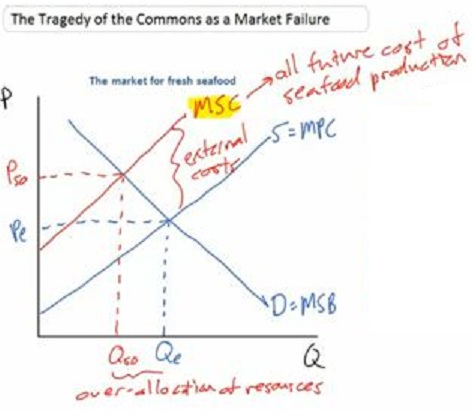
- So what can be done to internalize these
externalities?
- Garrett Harding -- only two solutions
exist:
- privatize
- manage as a group like the government
(socialism)
- Privatize: Permits for usage
- fishing permits
- permits for pollution
- Public management
Elasticity (Lessons 4a and
4b)
LESSON 4a - PRICE ELASTICITY OF
DEMAND AND TAX INCIDENCE
2.4.1
(4:47) Defining Elasticity - 4a
- Outline
- Defining elasticity
- The effects of elasticity on total
revenue
- Defining elasticity
- Will lowering the price of a good
increase your revenue?
- elasticity means
"responsiveness"
- the elasticity of demand is the
extent to which the quantity demanded changes when there is a
change in the price of a good (ME: our textbook uses the term
"price elasticity of demand")
- the price elasticity of demand is
the percentage change in quantity demanded that results from a
percentage change in price
- ME:
- we know from lesson 3a that if price
goes down then quantity demanded (not demand) goes up,
elasticity tells us HOW MUCH the quantity demanded goes
up
- if the P

 Qd
Qd or Qd
or Qd  ?
?
- if the price goes down, HOW MUCH
does the quantity demanded increase: a little or a
lot?
- HOW MUCH will the Qd change when
the price changes?
- or
- if the P

 Qd
Qd or Qd
or Qd  ?
?
- if the price goes up HOW MUCH does
the quantity demanded decrease: a little or a
lot?
- HOW MUCH will the Qd change when
the price changes?
- The effects of elasticity on total
revenue
- if at a price of $2, the quantity sold
is 20
- if at a price of $1, the quantity sold
is 30
- so when the price went down the total
revenues (TR = P x Q) went down. $2 x 20 = $40 and $1 x 30 =
$30
- so when the price went down the
quantity demanded went up a little
- the demand curve is steeper
- demand is less elastic
- if at a price of $2, the quantity sold
is 20
- if at a price of $1, the quantity sold
is 50
- so when the price went down the total
revenues (TR = P x Q) went up. $2 x 20 = $40 and $1 x 50 =
$50
- so when the price went down the
quantity demanded went up a lot
- the demand curve is flatter
- demand is more elastic
- what happens to total revenue when the
price went down?
- It depends on elasticity
- The video lecture will
ask you a multiple choice question. ANSWER THE QUESTION by
selecting A, B, or C and more of the lecture will
follow
- inelastic demand (quantity demand is not
very responsive to a change in price)
- if at a price of $2, the quantity
sold is 20, then total revenue = P x Q = $2 x 20 =
$40
- if at a price of $1, the quantity
sold is 30 then TR= P x Q = $1 x 30 = $30
- so when the price went down the
quantity demanded went up a little and the total revenue
declined
- if demand is inelastic and the price
goes down, then the TR will decrease
- elastic demand (quantity demand is very
responsive to a change in price)
- if at a price of $2, the quantity
sold is 20, then total revenue - P x Q = $2 x 20 =
$40
- if at a price of $1, the quantity
sold is 50 then TR= P x Q = $1 x 50 = $50
- so when the price went down the
quantity demanded went up a lot and the total revenue
increased
- if demand is elastic and the price
goes down, then the TR will increase
2.4.2
(11:43) Calculating Elasticity - 4a
- Outline
- Defining elasticity
- Characteristics of the formula for
elasticity
- Calculating elasticity using the
midpoint formula
- Defining elasticity
- when we measure elasticity we want a
formula that does not depend on the units:
- this means it should not matter if we
measure the price of ice cream in dollars ($1) or in pennies
(100 cents)
- and it should not matter if we
measure the quantity of ice cream in cones, or scoops, or
pounds
- we want a unitless
measure
- definition of the price elasticity of
demand:
- Characteristics of the formula for
elasticity
- Fraction
- the fraction bar means "that results
from"
- Never negative due to the absolute value
in the formula
- the two bars on each side of the
formula mean "absolute value"
- absolute value means that we ignore
the negative sign
- we know that there is an inverse
relationship between P and Qd
- this means that the fraction that we
use when we calculate the price elasticity of demand will
always have a negative value
- so the |absolute value
bars| on each side of the fraction just means that we
get rid of the negative sign
- Unitless measure
- by calculating PERCENTAGE CHANGES we
get rid of the units
- it doesn't matter whether we measure
the price in dollars or pennies, the percentage change will
be the same
- Calculating elasticity using the midpoint
formula
- ME: YouTube
video on how to calculate percentages
- ME: our textbook calls this the
"coefficient of price elasticity of demand"
(Ed)
- How to calculate a percentage change in
quantity demanded (%
 Qd)
Qd)
- first you find the change in Qd by
taking the new Qd minus the old Qd
- then you divide by . . .
.what?
- The video lecture
will ask you a multiple choice question. ANSWER THE QUESTION
by selecting A, B, or C and more of the lecture will
follow
- usually the original (old quantity),
BUT . . . WE WON'T DO THIS. WE WILL USE THE MIDPOINT
FORMULA, because if you use the original quantity in the
denominator you will get a different percent change in
quantity for price increases and for price
decreases
- Tomlinson says: "WAIT A MINUTE
SOMETHING IS WRONG HERE"
- we want one measure of elasticity
that is the same for price increases and for price decreases
so we will use the MIDPOINT on our graph for our denominator
(what Tomlinson calls the "base")
- The video lecture
will ask you a multiple choice question. ANSWER THE QUESTION
by selecting A, B, or C and more of the lecture will
follow
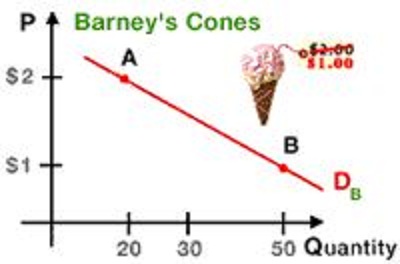
- If the price goes from $2 to $1,
what is the price elasticity of demand?
- Data:
- P1 = $2; Q1 =20;
- P2 = $1; Q2 = 50
- Formula: Ed = | %
 Qd
/ %
Qd
/ % P
|
P
|
- ME: our textbook calls this the
"coefficient of price elasticity of demand"
(Ed)
- ME: see the textbook for the
midpoint formula
- %
 Qd
= change in quantity / midpoint
Qd
= change in quantity / midpoint
- change in quantity = Q2-Q1 = 50 -
20 = 30
- midpoint = halfway between 20
and 50 = (Q2+Q1)/2 = (50+20)/2 = 70/2 =
35
- %
 Qd
= change in quantity / midpoint = 30/35 = 6/7
Qd
= change in quantity / midpoint = 30/35 = 6/7
- %
 P
= change in price / midpoint
P
= change in price / midpoint
- change in Price = P2-P1 = 1-2 =
-1
- midpoint = (P2+P1)/2 =
(1+2)/2 = 3/2 = -3/2
- %
 P
= change in price / midpoint = -1/(3/2) =
-2/3
P
= change in price / midpoint = -1/(3/2) =
-2/3
- The video lecture will
ask you a multiple choice question. ANSWER THE QUESTION by
selecting A, B, or C and more of the lecture will follow
- If the price goes from $1 to $2, what
is the price elasticity of demand?
- Data:
- P1 = $1; Q1 = 50
- P2 = $2; Q2 = 20
- you will get the same answer
9/7 or 1 and 2/7; ERROR: there are two correct answers
9/7 is the same as 1 and 2/7
- using the midpoint formula we estimate
the price elasticity of demand and it does not matter if the
price increases or the price decreases, the elasticity will be
the same
- ME: we will always use the midpoint
formula
2.4.3
(8:42) Applying the Concept of Elasticity - 4a
- ME: be sure to read the textbook
section: "Interpretations of Ed" !!
OPTIONAL:
Introduction
to Price Elasticity of Demand - Calculating PED Using Data from a
Demand Diagram
(econclassroom.com 11:46) - 4a
OPTIONAL:
Price
Elasticity of Demand and the Total Revenue
Test (econclassroom.com 13:24) -
4a
2.4.4
(6:50) Identifying the Determinants of Elasticity - 4a
- Outline
- What determines the price elasticity
of demand?
- Availability of close
substitutes
- Time needed to search for a
substitute
- Percentage of budget (income)
spent on the good
- ME: the textbook also includes
luxuries vs. necessities
- Review: elastic vs.
inelastic
- What determines the price elasticity of
demand?
- the price elasticity of demand
is:
- the responsiveness of the quantity
demanded to changes in the price of the good
- the % change in quantity demanded
that results from a % change in price
- what determines if the price elasticity
of demand for a good is elastic or inelastic?
- Availability of close substitutes
- many substitutes = more elastic
demand
- few substitutes = less
elastic
- Time needed to search for a
substitute
- more time = more elastic
- less time = less elastic
- ME: students often get this wrong. If
the price of gas increases to $7.00 a gallon today what will
happen to the quantity demanded in the next few weeks? Yes, it
will decrease but by HOW MUCH? Most students say that it would
decrease by a lot, BUT what other alternatives do we have? I
think that there would be only a small decrease in quantity
demanded and demand is less elastic. Now, if we wait six months
and then check to see how consumers responded to that increase
in gasoline prices I think we would see a much bigger response
(more elastic) because they would have had more time to fins
substitutes (check the bus schedule, get a more fuel efficient
car, find friends to share rides with, etc.).
- Percentage of budget (income) spent on the
good
- if you spend a small percent of your
budget on a product then demand for that product is less
elastic
- if you spend a large percent of your
budget on a product then demand for that product would be more
elastic
- ME: the textbook also includes luxuries vs.
necessities
- luxuries have a more elastic
demand
- necessities have a less elastic
demand
- Review: elastic vs. inelastic
- demand for a product is more price
elastic if:
- there are many
substitutes
- you have lots of time to find
substitutes
- if is makes up a large part of your
budget
- if it is a luxury
- demand for a good will be less price
elastic if:
- it has few close
substitutes
- you have little time to find
substitutes
- if is makes up a small part of your
budget
- you have a necessity
Examining
the Effect of an Excise Tax on an Inelastic Good -- Cigarettes
(12:41) - 4a
http://www.econclassroom.com/?p=2771
- An excise tax is either a specific tax or
an ad valorem tax placed on a particular good or service. (ME: we
will only look at a specific excise tax)
- An excise tax is a tax of a specific
amount to be paid on every unit of a product sold. Example: a $2
tax on a pack of cigarettes
- ME: we won't worry about ad valorem tax,
but Illinois does have a specific excise tax on a gallon of
gasoline ($0.19 per gallon) and an ad valorem excise tax on
gasoline (5% of the price)
- Example: what happens when the government
places a $2 tax per pack on cigarettes?
- we know that taxes decrease
supply
- a $2 tax will shift the S=MC
curve "upwards" by $2. At every quantity sold, the
cigarette producers face an additional $2 cost, in
the form of the tax that they must pay to the
government
- the amount of the tax is
the vertical distance between the two supply
curves
- what happens to the
equilibrium price and quantity as a result of the
$2 tax?
- equilibrium quantity will go
down; people will buy fewer packs of
cigarettes
- But notice that a $2 tax
does NOT increase the price by $2;
- who pays the tax (bears the
burden of the tax), or how much the price
increases, depends on the price elasticity of
demand
- if the demand for cigarettes
was perfectly inelastic (if the demand curve was
vertical) then a $2 tax would cause the price to
increase by $2
- but demand is not perfectly
inelastic so customers do not pay the whole amount
of the tax
- so if producers did raise
the price by the whole $2 they would make much
less profits as they will lose many
customers
- so producers will raise
the price by less than the amount of the tax
($1.20 in the example) and the producers will
pay the rest of the tax ($0.80)
themselves
- Tax burden (or tax
incidence) refers to the amount of the tax
paid by producers and the amount of the tax paid
by consumers; ME: our textbook uses the term
"tax incidence"
- notice that the consumers
bear a higher burden of the tax
- how much tax is collected by
the government is calculated by taking the amount
of the tax ($2) times the quantity sold (25) =
$50
- consumers pay $1.2 times 25
= $30 = blue rectangle
- producers pay $0.80 times 25
= $20 = green rectangle
- what happen to social
welfare (allocative efficiency)?
- let's assume that there are
no externalities associated with cigarettes, then
the original S = MSC and D = MSB and the original
equilibrium quantity of 30 would maximize society's
satisfaction or it is the allocatively efficient
quantity; this is when the consumer and producer
surplus is maximized
- but with the tax the
quantity that consumers buy is lower; this
represents allocative inefficiency because
consumers are buying less;
- another way to show this is
by measuring the dead weight loss
- consumer surplus
decreases (purple triangle)
- producer surplus also
decreases (yellow triangle)
- government gains $50 in
tax revenue (government surplus?) which can be
seen as a benefit to society (red rectangle = CB
+ PB)
- dead weight loss of the
tax = loss of social welfare (satisfaction)
caused by the tax (black triangle)
|
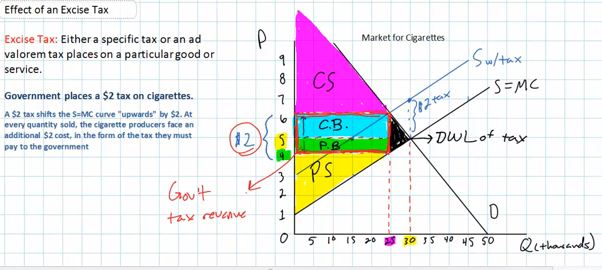
|
- Summary: if we add an excise tax to a
product
- supply will decrease causing the
price to increase and the quantity to decrease
- the amount of the tax is the vertical
distance between the two supply curves
- the excise tax is shared between the
consumers and producers; the incidence of the tax depends on
price elasticity of demand
- if the demand is relatively
inelastic then the consumers will pay most of the
tax
- if the demand is relatively
elastic then the producer will pay most of the
tax
- the amount of tax revenue collected
by the government is the amount of the tax times the new
equilibrium quantity
- if the demand is relatively
inelastic then the government will collect more tax
revenue
- if the demand is relatively
elastic then the government will collect less tax
revenue
- social welfare (allocative
efficiency) decreases; there is a loss of satisfaction to
society (dead weight loss ) due to the excise tax because
less will be produced
- if the demand is relatively
inelastic then there will be a small loss of satisfaction
to society (only a little allocative
inefficiency)
- if the demand is relatively
elastic then there will be a large loss of satisfaction
to society (a lot of allocative inefficiency)
- we will see in the next video
lecture that the amount of dead weight loss is greater if
demand is elastic and smaller if demand is
inelastic
Examining
the Effect of an Excise Tax on an Elastic Good -- Candy Bars (8:08) -
4a
http://www.econclassroom.com/?p=2774
- Review of the previous lecture
(excise tax on cigarettes)
- the excise tax is shared between the
consumers and producers; the incidence of the tax depends on
price elasticity of demand
- if the demand is relatively inelastic
(like for cigarettes) then the consumers will pay most of
the tax
- if the demand is relatively elastic
(like for candy bars) then the producer will pay most of the
tax
- The demand for candy bars more elastic than
the demand for cigarettes?
- there are lots of substitutes for candy
bars and few substitutes for cigarettes
- cigarettes are also addictive (like a
necessity) = less elastic demand
- the demand curve then will be flatter
for candy bars = more responsive to a change in price (bigger
change in Qd when the price changes)
- Effects of a $2 excise tax on candy bars
(elastic demand)
- supply decreases (supply shifts
up by $2) causing the price to increase and the
quantity to decrease;
- since the demand is elastic
the quantity demanded (equilibrium quantity)
will decrease A LOT.
- and since the demand is
elastic the equilibrium price paid by consumers
will increase only a little
- the incidence of the tax on
consumers (consumer tax burden) is smaller
than the producer tax burden; the producer will pay
most of the tax
- the amount of tax
revenue collected by the government, tax revenue =
$2 excise tax times quantity, (the blue + green
rectangles ) is small because the quantity sold
decreases a lot
- there is larger dead weight
loss (black triangle), i.e. loss of satisfaction
to society
|
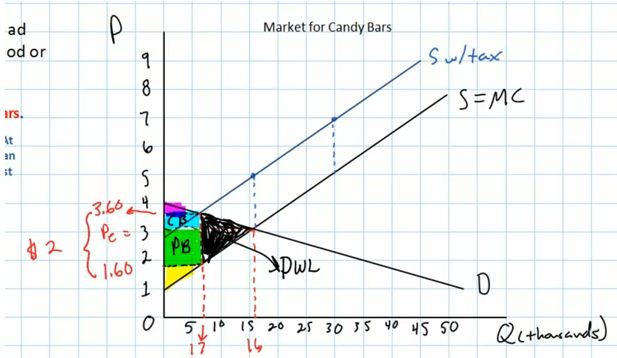
|
- Why tax products with inelastic demand
rather than products with elastic demand?
- if demand is inelastic ( like
cigarettes):
- quantity decreases only a little and
the price increases a lot
- incidence of the tax is more on
consumers
- government collects more tax
revenue
- negative effect on allocative
efficiency (dead weight loss) is less
- if demand is elastic (like candy
bars):
- quantity decreases a lot and price
increase a little
- incidence of the tax is more on the
producers
- government collects less tax
revenue
- negative effect on allocative
efficiency (dead weight loss) is greater
- BUT:
- remember: if there are negative
externalities associated with a product (like cigarettes)
then
- too much will be
produced
- the government may want to put an
excise tax on the good to decrease the quantity
consumed
- BUT (again) if the demand is
inelastic, the excise tax will not have a big
effect on the quantity demanded
LESSON 4b - OTHER TYPES OF ELASTICITY
- PRICE ELASTICITY OF SUPPLY
- CROSS ELASTICITY OF DEMAND
- INCOME ELASTICITY OF DEMAND
Elasticity
of Supply (Khan Academy 9:33) - 4b
http://www.khanacademy.org/finance-economics/microeconomics/v/elasticity-of-supply
CROSS
ELASTICITY OF DEMAND
Cross
Elasticity of Demand (Khan Academy 11:20)- 4b
http://www.khanacademy.org/finance-economics/microeconomics/v/cross-elasticity-of-demand
- HOW MUCH does a price change of one good
affect the quantity demanded of another good
- uses the midpoints formula to calculate the
percent increase in price of an airline ticket and the percent
change in quantity
- "CED" = cross elasticity of
demand
- cross elasticity of demand = % change in
quantity demanded of one product / % change in price of
another product
- if the products are near perfect
substitutes then the cross elasticity of demand will be very high
and will approach infinity (example tickets on different
airlines)
- substitutes have + (positive) cross
elasticities of demand (example: Coke and Pepsi)
- complements have - (negative) cross
elasticities of demand (example: e-books and e-reader)
- unrelated products have a cross
elasticity of demand that equals zero
INCOME
ELASTICITY OF DEMAND
Income Elasticity of Demand (Gale Pooley
3:14)- 4b
http://www.youtube.com/watch?v=Tct2EmT9iNE
- Edy = coefficient for the income elasticity
of demand
- formula = % change in Qd / % change in
income
- if Edy < zero, the product is an
inferior good
- when incomes increase the quantity
bought will decrease
- example: ramen noodles = inferior
good
- if Edy is between zero and one, the product
is a normal good
- when incomes increase the quantity
bought will increase
- example: candy bar = normal
good
- if Edy > 1, the product is a luxury
good
- when incomes increase the quantity
bought will increase a lot
- example: restaurant meal = luxury
good
Consumer Behavior
LESSON 6a - CONSUMER DECISIONS:
UTILITY MAXIMIZATION
3.1.1 (4:31) Understanding
Utility Theory - 6a
- Outline
- Utility theory
- Measuring total utility (TU) and
marginal utility (MU)
- The law of diminishing marginal
utility
- Utility theory
- utility theory explains how households
allocate their budget (spend their money) over a wide array of
goods and services
- ME:
- how much do we buy of each item to
maximize our utility (satisfaction)
- why do we buy what we buy? why do we
buy many different things?
- why don't we just buy the one thing
that we like the best?
- Measuring total utility (TU) and marginal
utility (MU)
- economists measure satisfaction
(utility) using an artificial unit called the "Util". A util is
an increment of satisfaction, and artificial construct of
utility or psychological satisfaction
- ME: utils do not exist. We cannot
measure satisfaction. But, economists ASSUME that they can to
explain consumer behavior; to explain why we buy the quantities
that we do.
- ME: utility cannot be
measured
- ME: utility can be compared. We can say
that we like something more than something else, but we cannot
measure the number of "utils"
- TU is the total satisfaction (number of
utils) a consumer gets from consuming units of a good or
service
- MU is the additional satisfaction
(number of utils) that a consumer receives from consuming
one additional unit of a good
- marginal utility diminishes
- ME: MU =
 TU
/
TU
/  Qconsumed
Qconsumed
- TU is the sum of the MU
- more is better, up to a point, but each
additional unit provides less additional satisfaction than the
unit before
- The law of diminishing marginal
utility
- after some point consumption is subject
to the law of diminishing marginal utility
- after some point, each additional unit
that you consume, in a set period of time, ceteris paribus,
will provide less additional satisfaction than the unit
before
- more of everything is better, but more
of one thing in a given period of time give less and less extra
satisfaction and may give no, or even negative,
satisfaction
- ME: we get "sick of it"; this explains
why we do not just eat our favorite food every meal, every day.
Even though it is our favorite food, after a while, we will
become sick of it, i.e. we will get little, or even negative,
satisfaction from additional units
- ME: surprisingly, Professor Tomlinson
does not graph TU and MU. See our textbook and yellow pages for
the graphs.
3.1.2 (4:47) Optimal
Consumer Choice - Finding Consumer Equilibrium - 6a
- Outline
- How will a household spend its
limited income on the goods and services that provide it with
satisfaction?
- The utility maximizing
model
- How will a household spend its limited
income on the goods and services that provide it with
satisfaction?
- How much will we spend on apples and how
much will we spend on candy bars?
- the utility maximizing rule: to get the
most satisfaction possible, households will spend their income
such that the MU per dollar spent is equal for all
items
- MUx/Px = MUy/Py
- To maximize utility, consumers will
equalize their marginal utilities per dollar spent between
goods
- The utility maximizing model - an example:
candy bars and apples
- In a two-good model, a consumer
continuously reallocates her income until the marginal utility
per dollar spent on one good is equal to the marginal utility
per dollar spent on the other good
- ME: we can easily expand this model to
include more goods -- to maximize utility consumers will spend
their income such that: MUa/Pa = MUb/Pb = MUc/Pc = MUd/Pd = . .
. . .
- An example:
- Given:
- income = $6
- only two items to buy: apples and
candy bars
- the price of apples =
$1.00
- the price of candy = $
0.50
- the MU received from different
quantities of apples and different quantities of apples
(see table below)
- Question: how many apples and candy
bars would be bought to receive the maximum utility
(satisfaction) possible from the $6 in income?
- consumers will buy an item as long
as the MU they receive per dollar spent on the item is
greater than the MU per dollar that they could bet on a
different good; i.e. buy the item that gives you the most
satisfaction for your money
FIRST you must
calculate MU/P for each product:
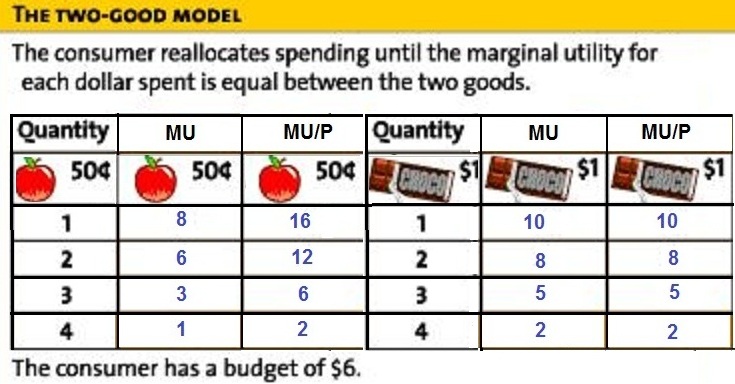
Then: go shopping and
buy the item that gives you the greatest MU for your
money (the highest MU/P):
You will first buy one apple
because it give you 16 utils per dollar and the first
candy bar gives you only 10 utils per dollar
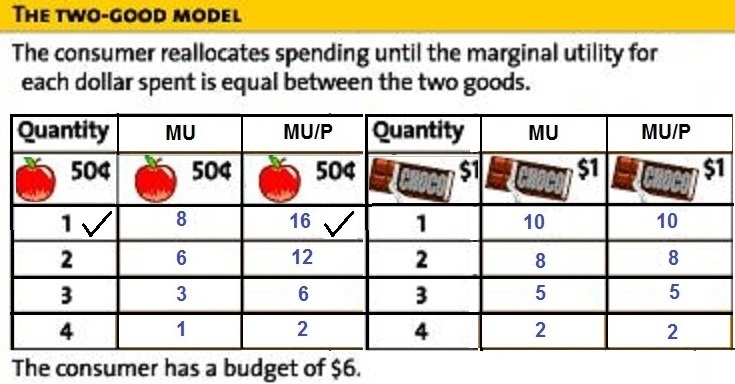
Next you will buy another apple
because you get 12 utils per dollar which is more than
you would get from the first candy bar,
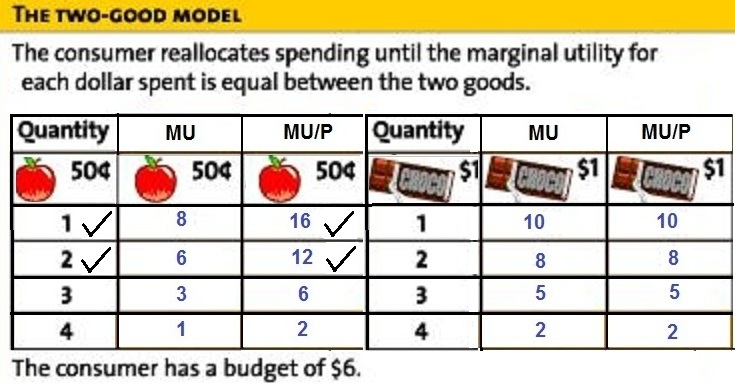
Now you would buy your first candy
bar and get 10 utils per dollar (if you bought another
apple you would only get 6 utils per dollar)
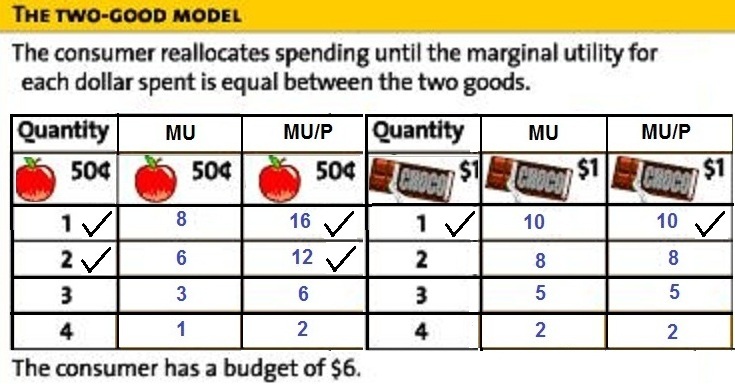
And another candy bar (8 utils per
dollar is more than the 6 utils per dollar that you would
get if you bought another apple)
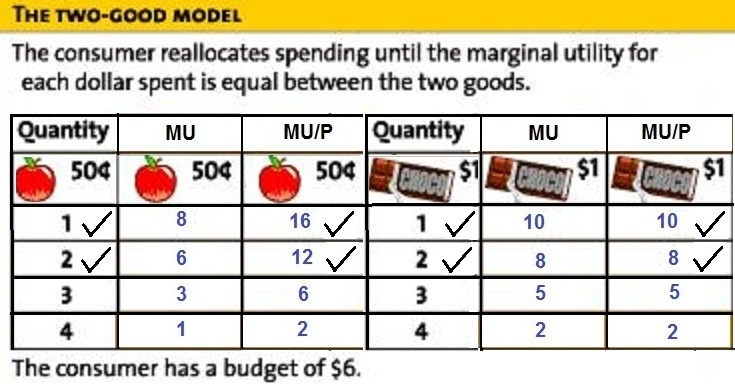
So far you have spent $1 on apples
and $2 on candy bars. You have $6 to spend, so continue
to shop. What would you buy next? Your third apple (6
utils/$ for the third apple compared to 5 utils/$ for the
third candy bar).
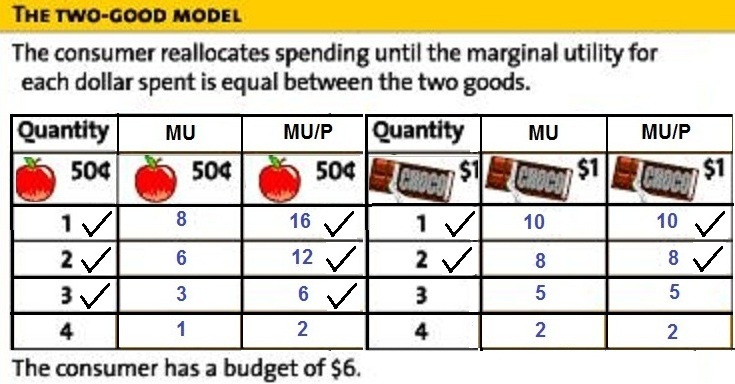
And you continue to shop this way
until you have spent your $6.
ME: This is a strange problem
because you end up buying everything on the table. Be
sure to do some of the "practice exercises" (see link on
Blackboard) because in them you will have to stop
shopping when you run out of money and before you buy
everything on the table.
ME: Also, Professor Tomlinson did
not have you calculate the maximum total utility (TU)
possible. You can see from the table below that if you
buy 4 apples the TU you receive is18 utils, and if you
buy 4 candy bars the TU you receive is 25 utils. So, if
you spend all of your $6 income the maximum TU possible
is 18 + 25 = 43 utils.
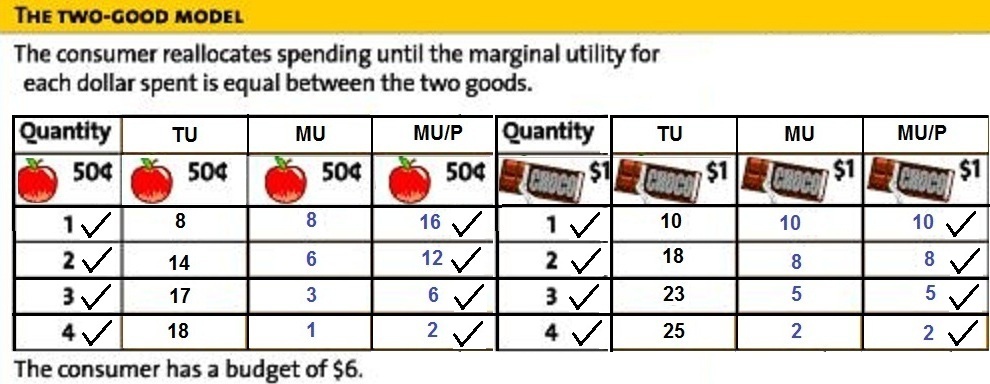
BUT, you may be asking how did we
calculate the TU in the table above? Remember, MU is the
extra utility received from consuming one more. If you
add up all of the marginal utilities, you get the total.
For two apples the TU = 8 + 6 = 14. For three apples the
TU is 8 + 6 + 3 = 17.
- ME: be sure to do several practice
exercises on these types of problems.
Professor Harmon Calculates the Utility
Maximizing Bundle in 5 mins (YouTube - 02001orh) - 6a
http://www.youtube.com/watch?v=LY1slp1dacA
- ME: You will encounter two different types
of utility maximization problems
- one where you are given the MU (like in
the video lecture above and the "Worked Problem" link
above)
- and one where you are given the TU (like
in this YouTube video) and you have to calculate the
MU
- Problem:
- Video games cost $12 and spy novels cost
$10
- You have $54 to spend
- The TU is given in the table
- Question: What quantity of video games and
spy novels should you buy to maximize your utility and what is the
maximum total utility possible?
- Use the Utility Maximization Rule: always
buy the product that gives you the greatest MU/P (MU per dollar)
first, and continue buying until you have spent all of your
money
- First calculate the MU for each
product
- Then calculate the MU/P for each
product
- Then go shopping buying the product that
gives you the highest MU/P first and continue buying video
games and spy novels until you have spent all $54 or as much as
possible.
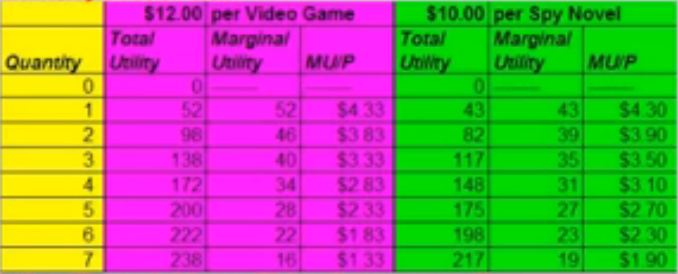
The Costs of Production (LESSONs
7a, 7b, and 7c)
LESSON 7a - ECONOMIC PROFITS
AND THE PRODUCTION FUNCTION
- AN ECONOMIST'S VIEW OF COSTS AND
PROFIT
- PRODUCTION IN THE SHORT RUN
AN
ECONOMISTS VIEW OF COSTS AND PROFIT
5.1.4
(13:54) Finding Economic and Accounting Profit -7a
- Outline
- economic profit and accounting profit
differ from each other in the way that each defines
costs
- calculating economic profits of a
firm: compare total revenues to ALL OPPORTUNITY COSTS of the
resources that it employs
- sunk costs (fixed costs) are
prior-occurring costs that are unrecoverable and should not
affect current decisions
- economic profit is the difference between
the revenue that a firm earns and the sum of the opportunity costs
of the all resources that the firm employs
- ME: economic profit = TR - TC (where TC
include all of the opportunity costs)
- TR = P x Q
- TC includes all of the opportunity costs
of the resources used
- if the total revenue > the sum of the
opportunity costs of the resources the firm is making an economic
profit and then the resources will stay with the firm
- BUT, if the total revenue < the sum of
the opportunity costs of the resources, the firm has economic
losses and then the resources will seek employment elsewhere (go
out of business)
- ME: this explains why a zero profit IS GOOD
in economics
- Economists vs. accounting profits:
- accounting profit = total revenue -
explicit costs only
- economic profit = total revenue - all of
the opportunity costs
- economic profit = total revenue -
(explicit costs + implicit costs)
- c.o.g.s = cost of goods sold
- accounting profit does not
tell us if the resources in our business are earning as much,
or more, than they could earn in their next best
opportunity;
- accounting profit does not
tell us if the resources will stay with our business OR
leave for a better opportunity elsewhere.
- accounting profit does not
tell us if our business will continue to exist.
- because accounting profit does NOT
include the opportunity cost of the resources
- economic profit does take
into account what our resources could earn elsewhere and
therefore it tells us if the resources will stay with us or
move elsewhere.
- economic profit does tell us
if the resources will stay with our business OR leave for a
better opportunity elsewhere.
- economic profit does tell us
if our business will continue to exist.
- because it includes the opportunity
cost of the resources (what they could have earned in their
next best alternative)
- economic rent: the amount of
payment an economic resources receives in excess of
its next best alternative
- how much better a resources is
doing than in their next best alternative
- ME: we will call this "economic
profit"
- economic profit tells us how much the
revenues exceed the total opportunity costs of all resources
employed
- economic profits then are divided
among the resources in the form of economic
rents
- if economic profits are
negative the business will end up closing down because
the resources would have better opportunities elsewhere --
even if the accounting profit is positive; i.e. even though
the books look good according to the accountant, the firm
will close down
- ME: this is why a ZERO PROFIT in
economics is GOOD; because a zero economic profit INCLUDES
covering all of the opportunity costs; i.e. you are paying
yourself just as much as you would be paid in your next best
alternative,
- what you could make elsewhere is
included in the costs;
- therefore, if TR - TC = zero,
you have already paid yourself and the opportunity
costs of all other resources
- sunk costs are unrecoverable
costs incurred in a previous time period that have no relevance
to the current decisions
- ME: also called "fixed
costs"
- ignore sunk costs; they should not
affect current decisions
- to make good decisions you should
compare the extra benefits (MB) and the extra costs (MC); if
the MB > MC then do it, but you should ignore sunk
costs
- ME: i.e. do not come to class if you
are very ill just because you already paid the
tuition
PRODUCTION
IN THE SHORT RUN
4.1.1
(8:48) Understanding Output, Inputs, and the Short Run -
7a
- Outline
- How much should a firm
produce?
- Definition: Total Output (also called
Total Product)
- Total output in the short
run
- Redefining total
output
- Total output schedule
- How much should a firm produce?
- Goal: to maximize profits
- WE WILL SPEND THE NEXT 20 OR 30 VIDEO
LECTURES ON THIS TOPIC: How much should a firm produce?
- to answer this we need to took at how
a firm makes a product, i.e. its technology
- then we look at the costs = how much
it costs to make a product
- finally we combine costs with the
price a firm can get for its product
- technology is a catalog (or list) of the
things that a firm knows how to do
- how much output can a firm produce
with a given amount of input
- this is really engineering
(technology); what can a firm do?
- Definition: Total output (also called Total
Product)
- total output is the total amount of
output that a firm can produce with a given amount of inputs
(resources) and its technology
- also called Total
Product
- ME: sometimes this is called the firm's
production function
- Total output in the short run
- short run is a period of time
that is so short that a company can only change one, or a few,
of its inputs
- ME: our textbook introduces short run
and long run in lesson 4b (elasticity);
- in the short run some of the
resources are fixed, i.e. cannot be changed;
- usually the size of the factory
(plant) is fixed;
- in the short run there is not
enough time to change the size of the factory, but you
can change the amounts of variable inputs
used
- ME: the video lecture simplifies the
short run definition by saying that only one input is
variable
- Tomlinson assumes all resources are
fixed except labor; labor then is the only variable
input
- Redefining total output
- total output of the variable input labor
is the total amount of output that a given amount of labor can
produce holding constant technology and all other
inputs
- Total output schedule
- how many televisions can be produce in a
week with 1 worker, 2 workers, 3 workers, etc, assuming all
other inputs are constant?
- with more workers more televisions can
be produced UNLESS we get too many workers, then the number of
televisions produced will decrease? Why?
- ME: because since we are holding all
other inputs constant, like the size of the factory, the
factory is becoming overcrowded
- a plot of the total output schedule is
called the Total Product Curve
4.1.2
(15:57) Explaining the Total Product Curve - 7a
- Outline
- Production Possibilities in the short
run
- Graphing the total product
curve
- Properties of the total product
curve
- The marginal product of
labor
- Why does the marginal product
change?
- Production Possibilities in the short
run
- what a single firm can do in the short
run when it adds more labor assuming all other resources are
fixed
- Graphing the total product curve
- always label the axes!
- vertical: the total amount of output
or total product (TP)
- horizontal: the amount of labor (# of
workers) or quantity of variable input
- make the graph
- Properties of the total product
curve
- ME: whenever we create a new
graph we always explain its shape!
- S-shape with three different
parts
- at first the curve is
increasing at an increasing rate (getting steeper
or convex)
- then the curve is still
increasing but at a decreasing rate (getting
flatter or concave but still going up)
- finally the curve reaches a
maximum and then if we add more worker we produce
LESS and the curve goes down
- Why? We will explain the
shape of the TP graph by discussing the marginal
product of labor (MP)
|
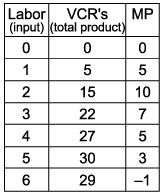
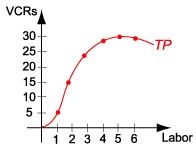
|
- The marginal product of labor
- definition: the change in total output
that results from changing the variable input by one unit; how
much more output we get from each additional worker
- MP = change in TP / change in the
quantity of variable input;
- MP =
 TP /
TP /  Qinput
Qinput
- ME: MP is the slope of the TP
graph
- MP goes up because TP gets steeper
(convex), then MP goes down because even though TP is still
increasing it's slope is less - getting flatter (concave),
finally MP becomes negative when TP starts to decline, the
TP then has a negative slope
- Why does the marginal product
change?
- Why does MP increase at first, reach a
maximum and then declines and finally becomes
negative?
- MP increases (TP increases at an
increasing rate) at first because of specialization and
teamwork;
- specialization causes increases in
productivity through fewer setup costs
- teamwork: larger groups of workers
can use different techniques that can increase
productivity
- MP later decreases (TP increases at a
decreasing rate) because of the problem of congestion --
the factory is getting crowded; remember the size of the
factory is fixed and it can get crowded. This reduces
productivity and the additional output that results from adding
another worker will decline
- MP eventually becomes negative (TP
decreases) because the factory becomes overcrowded. The
factory is so crowded that the addition of one more worker
actually causes output to decrease.
- ME: this idea of specialization and
teamwork, congestion, and overcrowded, will be used later in
lesson 7b to explain the shapes of other graphs
4.1.3
(7:22) Drawing Marginal Product Curves - 7a
- Outline
- Trying to graph the marginal
product
- Intuition about the marginal product
curve
- Plotting and
connecting
- Change in MP as part of
technology
- Convex/concave: a demonic
device
- Trying to graph the marginal product
- a graph that describes a firm's
technology
- know how the axes are
labeled
- MP =
 TP /
TP /  Qlabor
Qlabor
- Intuition about the marginal product
curve
- MP = slope of the TP curve
- MP goes up because TP gets steeper
(convex),
- then MP goes down because even though
TP is still increasing it's slope is less - getting flatter
(concave),
- finally MP becomes negative when TP
starts to decline - TP then has a negative slope
- Plotting and connecting
- ME: note when TP is at its peak, MP is
zero, (when TP is at its peak its slope [MP] is
zero)
- Change in MP as part of technology
- why does MP increase at first?:
specialization and teamwork possible if more workers are
working at the same time together (see previous
lecture)
- why does MP start to decline?: problem
of congestion
- why does MP become negative?:
overcrowded
- Convex/concave: a demonic device (memory
trick)
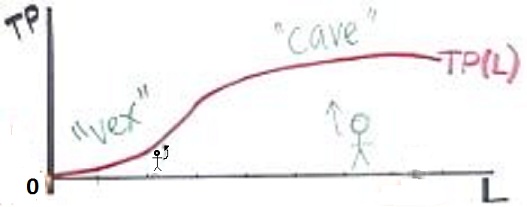
4.1.4
10:32) Understanding Average Product - 7a
- Outline
- Marginal Product (MP) vs. Average
Product (AP)
- Computing AP
- Graphing AP
- MP and AP together
- MP intersects AP at its maximum
point
- Marginal Product (MP) vs. Average Product
(AP)
- AP is another measure of
productivity
- Using MP, a firm can determine the level
of output it has to produce in order to maximize its
profits
- Using AP, a firm can determine whether
it will make a profit or a loss when it is trying to maximize
its profits
- Computing AP
- AP is the total output divided by the
total quantity of labor input
- AP = TP/Qlabor or AP =
TP/Qinput
- AP is the output per worker
- sometimes called "labor
productivity"
- the amount of output that the average
worker produces
- Graphing AP

- shape:
- slopes upward than downward (upside down
U-shape)
- reaching a maximum (i.e the max. number
of televisions per worker)
- MP and AP together
- when the MP is above the AP, then the AP
is rising
- when the MP is below the AP, then the AP
is downward sloping
- the MP crosses the AP when the AP is at
its maximum point
- MP intersects AP at its maximum
point
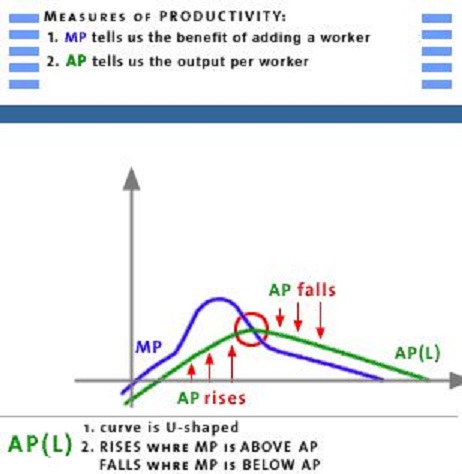
- what happens to your GPA if your "marginal
grade point" (GPA THIS semester) is above your cumulative GPA? It
will rise. MP above AP then AP rises.
- what happens to your GPA if your "marginal
grade point" (GPA THIS semester) is below your cumulative GPA? It
will fall. MP below AP then AP falls
- therefore the MP crosses the AP at the
maximum of the AP. This is the point where labor productivity is
at its highest. Know this because it will be used
later.
- JOKE: how can a student leaving one school
and going to another school cause the IQ of both schools to
increase? He was below average at the first school but above
average at the other school.
LESSON
7b - PRODUCTION COSTS IN THE SHORT RUN
4.2.1
(4:23) Defining Variable Costs - 7b
- Outline
- Definition of variable
cost
- Information needed to find variable
cost
- Computing variable
cost
- The costs of production include:
- variable costs
- fixed costs
- average costs
- marginal costs
- Definition of variable cost
- cost of hiring the variable input
needed to produce a given amount of output
- the total spending on the variable
inputs to produce a given quantity of output
- Information needed to find variable
cost
- the amount of labor (variable
input) needed to produce a given amount of output; this is
given in the total product (TP) curve
- the price of the labor or wage
rate
- Computing variable cost
- to get the variable cost you
multiply the wage rate times the number of workers
- ME: our textbook calls this the Total
Variable Cost (or TVC); the video lecture calls it simply
Variable Costs (VC); they are the same thing
4.2.2
(4:57) Graphing Variable Costs - 7b
- Outline
- Plotting the VC (TVC)
curve
- Eliminating inefficient
points
- The Maximum total
product
- Plotting the VC (TVC) curve
- the VC (TVC) curve shows you how much
money must be spent on labor to produce a given quantity of
output
- graph
- horizontal axis: we put the quantity
of output (televisions)
- on the vertical axis we put the
costs
- NOTE: if you produce zero televisions
then the TVC will be zero
- Eliminating inefficient points
- no firm will ever hire so many workers
so that the output (TP) begins to decline
- so we won't plot the quantity of
television when TP is declining
- The Maximum total product
- TVC curve becomes vertical since at
certain point it does not matter how much you spend on labor,
you can't produce any more television sets in your given size
factory
- again: in our given size factory, the
maximum number of television sets that we can produce is 49 so
the VC (or TVC) curve becomes vertical at that
point
- ME: remember our textbook uses TVC and
the video lectures uses VC
- ME: once we draw a new graph we always
want to understand its SHAPE. This will be discussed in a later
video lecture (7.3-4)
4.3.1
(6:41) Defining Marginal Costs - 7b
4.3.2
(10:59) Deriving the Marginal Cost Curve - 7b
4.3.3
(10:26) Understanding the Mathematical Relationship between Marginal
Cost and Marginal Product - 7b
- Outline
- Definition: MC and MP
- A mathematical
connection
- The inverse relationship between MC
and MP
- Mirror images: MC and MP
curves
- Maximum MP and minimum
MC
- Definition: MC and MP
- MP is the extra output that can be
produced when you hire another worker
- MC is the cost of producing an extra
unit of output
- there is an inverse relationship between
costs and productivity
- when productivity increases then cost
fall
- when productivity goes down then
costs go up
- A mathematical connection
- The inverse relationship between MC and
MP
- there is an inverse relationship between
costs and productivity
- when productivity increases then cost
fall
- when productivity goes down then
costs go up
- Mirror images: MC and MP curves
- note: the horizontal axes in these two
graphs are measuring different things
- Maximum MP and minimum MC
- at the maximum point of the MP curve
teamwork and specialization are maximized and the extra cost of
and additional unit of output (MP)is minimized
- beyond this point, as more is produced, we
start to experience the problem of congestion and productivity (MP
falls causing the extra costs (MC) to increase
- ME: the key to understanding all of this
is to understand (1) specialization and teamwork and (2) the
problem of congestion
4.4.1
(5:37) Defining Average Variable Costs (AVC) - 7b
- Outline
- Defining Average Variable Costs
(AVC)
- Computing AVC
- AVC and profitability
- Understanding why AVC changes
(understanding the shape of the curve)
- Defining Average Variable Costs
(AVC)
- We will use MC in later lessons to help
us find the quantity that firms will produce in order to
maximize their profits
- ME:
- in these later lessons (lessons 8 to
11) we will use benefit cost analysis (that we studied in
lesson 1d) to find that firms will maximize their profits if
they produce all quantities where the marginal benefits (MB)
are greater than the marginal costs (MC) up to the point
where MB=MC. A you should know, when MB=MC we are making the
best decision possible.
- We will use the MC that we calculated
in the previous video lectures and we will combine it with
something called marginal revenue (MR). MR is the extra
revenue that a firm gets when it produces and sells one more
unit of output. MR measures the extra benefits (MB) that a
firm gets for producing one more unit of output.
- So: a firm will maximize its profits
if it produces all quantities where MR>MC up to where
MR=MC. This MR=MC rule is very important. It tells us
how much firms will produce, or WHAT WE GET.
- Then we will look to see if this
quantity that we get is the quantity that WE WANT, or the
allocatively efficient quantity. We will do this in lessons
8/9b, 10b, 11a, and 11b. This is the ultimate goal: to see
if profit maximizing firms will produce the efficient
quantity that society wants.
- we use MC (and MR) to see what quantity
of output firms will produce (how much to produce)
- we use average costs to see if the firms
are making any profit or not at this level of output (are we
making a profit?)
- Definition of AVC: the cost of variable
resources (like labor) per unit of output produced
- Computing Average Variable Costs
(AVC)
- AVC = VC/TP
- ME: our textbook uses the formula: AVC =
TVC / Qproduced
- variable costs per unit produced or
labor costs per unit produced
- AVC is the total amount spent on
variable costs like labor divided by the quantity of output
produced
- AVC and profitability
- if AVC is greater than the price of the
product then firms will by making a loss
- if AVC is less than the price of the
product then the firm is making enough to cover all of the
labor costs and they will also have some left over to pay some
of the fixed costs of production (like rent on the factory,
etc.)
- ME: AVC will help us later to see if we
should continue to produce or not in the short run
- AVC is a guide to help us begin to
understand whether producing a certain level of output could be
profitable
- Understanding why AVC changes
(understanding the shape of the curve)
- why does he AVC curve decrease at first,
then increase, as more output is produced?
- it depends on productivity
- if your workers are more productive
then fewer will be needed to produce the product and the
average costs will be lower
- if our workers are less productive
than more workers will be need to produce a given level of
output and the average costs (costs per unit) will be
greater
- ME: remember --
- worker productivity increases because
of specialization and teamwork so average costs
decrease
- worker productivity decreases because
of the problem of congestion so average variable costs will
increase
4.4.3
(7:54) Understanding the Relationship between Marginal Cost and
Average Variable Cost - 7b
- Outline
- Marginals and
Averages
- Marginal Cost: a
review
- Putting AVC and MC
together
- MP and AP with MC and
AVC
- Marginals and Averages
- marginals and averages always have the
same relationship
- if marginal is above average, then
the average is going up
- when marginal is below average, the
average is going down
- and marginal will cross the average
at the highest point of the average
- we saw this when we graphed the MP and
AP curves
- we discussed this when we said:
- if your "marginal grade point" (grade
point average this semester only) is above your overall GPA,
then your GPA will increase
- if your marginal grade point this
semester is below your GPA, then your GPA will
decrease
- we will see this same relationship with
MC and AVC
- Marginal Cost: a review
- MC is the slope of the TVC curve at any
point
- at the point of inflection on the TVC
curve the MC will be at its lowest point
- at first the slope of the TVC curve is
decreasing (getting flatter) so the MC is decreasing; then
after the inflection point, the slope of the TVC curve
increases (gets steeper) so MC increases
- Putting AVC and MC together
- we know that AVC will reach its minimum
point when it crosses the MC curve
- if MC is below AVC then AVC will be
pulled down
- if MC is above AVC then AVC will be
pulled up
- ME: we could also plot AVC curve by
plotting the numbers in the table that we calculated in the
previous video lecture
- NOT REQUIRED: How did we know WHERE AVC
crosses the MC: or WHERE AVC is at its lowest point?
- AVC is equal to the slope of a line
that runs from the origin to a point on the VC
curve
- the slope of that line = rise/run =
VC/Q = AVC
- AVC then will be at its minimum when
that slope of this line is the lowest; i.e. when the slope
of a line from the origin that touches the TVC curve is the
flattest
- MP and AP with MC and AVC
- a upside down mirror image of the MC
curve is the MP curve; MC is reciprocally related to the
MP
- an upside mirror image of the AVC curve
is the AP curve; AVC is reciprocally related to the AP
curve
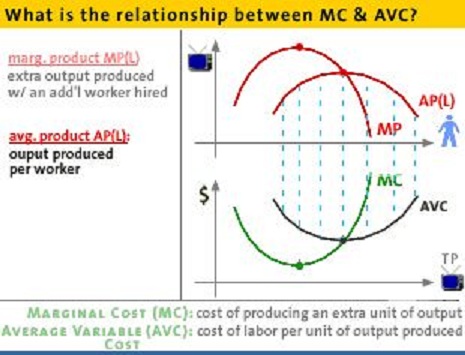
- the more workers it take to produce a
unit of output the higher the costs AND the more workers it
takes to produce a unit of output the lower the productivity
and therefore it will take more workers
- costs and productivity are reciprocally
related
4.5.1
(6:55) Defining and Graphing Average Fixed Cost and Average Total
Cost - 7b
- Outline
- Costs in the short
run
- Defining Fixed Cost
- Calculating fixed costs per unit of
output (AFC)
- Graphing AFC
- AFC + AVC = ATC
- Costs in the short run
- the short run is a period of time that
is so short that at least one input (resource) is fixed;
usually we assume that the size of the factory (or plant) is
fixed in the short run
- the costs of production then include the
variable costs and the fixed costs
- Defining Fixed Cost (FC = TFC)
- fixed costs are the costs of fixed
inputs (resources)
- the fixed costs are costs that do not
change even if we produce more
- ME: fixed costs are costs that we have
to pay even if nothing is produced
- ME: the video lecture uses "FC" for
total fixed costs whereas our textbook uses TFC for total fixed
costs
- TFC stay the same at every level of
output (even zero)
- to keep things simple the video lecture
assumes at ALL costs are fixed except labor in the short
run
- ME: therefore if we graph TFC it would
be a horizontal line
- Calculating fixed costs per unit of output
(AFC)
- fixed costs per unit = average fixed
costs = AFC
- AFC = TFC/Qproduced = TFC/TP =
FC/TP
- AFC is the fixed costs per unit of
output; or spreading the fixed costs even among hate quantity
of output produced
- AFC then declines as more is produced;
as the quantity produced increases the AFC gets smaller and
smaller and smaller
- ME: our textbook authors simplify the
calculation of AFC (and AVC and ATC) by using a table of data
where the quantity produced increases by 1;
- Graphing AFC
- as the quantity produced increases the
AFC gets smaller and smaller and smaller
- graph is called a rectangular hyperbola
in geometry
- ME: I often do not include the AFC graph
on my graphs because as we will see below you can easily
calculate AFC = ATC - AVC; this way I have few lines on my
graphs to keep it looking simple, but we can still calculate
AFC by a simple subtraction
- AFC + AVC = ATC
- if we add the AFC to the AVC we get the
total cost per unit of output = ATC = average total
costs
- ATC = AVC + AFC
- ME: The video lecture is a little sloppy
when they graphed the ATC; The ATC and the AVC curves should be
getting closer and closer together as the quantity increases;
this is because the difference between them is the AFC which
keeps getting smaller and smaller as more is
produced
4.5.2
(4:51) Calculating Average Total Cost - 7b
- Outline
- Total Cost and
profitability
- Defining Average Total Cost
(ATC)
- Calculating ATC: two
methods
- ATC in short
- Total Cost and profitability
- profits = total revenue - total costs =
TR - TC
- profit per unit of output = price -
ATC
- Defining Average Total Cost (ATC)
- ATC is the total cost of producing a
certain quantity divided by the quantity produced
- the the total cost PER UNIT of
output
- ATC = TFC / Qproduced
- total costs of production include the
total fixed costs plus the total variable costs
- TC = TFC + TVC
- in the video lecture the TFC =
$10,000 and the TVC is the number of workers times the wage
rate; wage rate is $1000;
- with one worker the TVC = 1 x $100
= $1000; total cost then is TFC + TVC = $10,000 + $1,000
= $11,000
- with two workers the TVC = 2 x
$100 = $2000; total cost then is TFC + TVC = $10,000 +
$2,000 = $12,000
- ATC = TC/Qproduced = TC/TP
- Calculating ATC: two methods
- ATC = TC/Qproduced =
TC/TP
- ATC = AFC + AVC
- ME: Professor Tomlinson in the video
lectures always runs through the algebraic steps in his
calculation; you should remember from junior high math class
that you if you do something to one side of an equation then
you must do the same thing to the other side
- ME: where professor Tomlinson uses TP,
our textbook usually uses the quantity produced (Qproduced) or
often just "Q".
- ATC in short
- ATC = TC/Q or TC/TP
- ATC = AFC + AVC
4.5.3
(4:51) Putting the Cost Curves Together - 7b
- Outline
- Reviewing AVC: cost and
productivity
- Components of ATC
- What to remember about ATC and
AVC
- The Marginal Cost curve
(MC)
- Profit maximizing levels of
output
- Reviewing AVC: cost and productivity
- ME: we will be using the following
curves a lot: ATC, AVC, and MC !!
- the AVC curve is the mirror image of the
AP curve and displays the changed in productivity as we add
more workers and produce more
- specialization and teamwork:
productivity increases and costs fall
- problem of congestion" productivity
decreases and costs rise
- Components of ATC
- ATC = AVC + AFC
- the shape of the ATC (remember: we must
try to understand the shape of all of our graphs)
- ATC falls at first as production
increases because
- you are able to spread the fixed
costs out over a greater range of output; ATC falls at
first because AFC fall; Tomlinson sometimes uses the term
"overhead spreading" for this concept
- increasing productivity due to
specialization and teamwork means that it take fewer
workers on average to produce a unit of
output
- then ATC increases as production
increases even though AFC continues to fall because of the
problem of congestion which decreases labor
productivity
- the minimum point of ATC is at a higher
level of output than the minimum point of AVC
- What to remember about ATC and AVC
- the distance between the ATC and
the AVC is the AFC
- the ATC curve and the AVC curve get
closer and closer together as the quantity produced
increases
- because the AFC is decreasing as output
increases
- The Marginal Cost curve (MC)
- when drawing the MC curve be sure
that it passes through the LOWEST POINTS of the AVC and the ATC
curves
- because when the marginal is below the
average it pulls the average down and when the marginal is
above the average it pulls the average up
- remember that the shape of the MC curve
is also because of the changing productivity of labor caused by
specialization and teamwork and by the problem of
congestion
- Profit maximizing levels of output
- We will be using these three
curves (ATC, AVC, and MC) to show the profit maximizing level
of output that businesses will produce
- these three curves summarize the firm's
productivity and the costs of the resources that the firm
uses
- How do we find the profit maximizing
level of output in the short run?
- The video lecture
will ask you a multiple choice question. ANSWER THE QUESTION
by selecting A, B, or C and more of the lecture will
follow
- This is a trick question
- because we have not yet discussed
anything about the revenue the we earn when we sell our
product, all we have is information about costs; we do not
have any information about at what price we can sell our
output
- ME: the profit maximizing level of
output will be that quantity where MR=MC
- ME: in later clessons (lessons 8-11) we
will use benefit cost analysis (that we studied in lesson 1d)
to find that firms will maximize their profits if they produce
all quantities where the marginal benefits (MB) are greater
than the marginal costs (MC) up to the point where MB=MC. A you
should know, when MB=MC we are making the best decision
possible.
- We will use the MC that we calculated
in the previous video lectures and we will combine it with
something called marginal revenue (MR). MR is the extra
revenue that a firm gets when it produces and sells one more
unit of output. MR measures the extra benefits (MB) that a
firm gets for producing one more unit of output.
- So: a firm will maximize its profits
if it produces all quantities where MR>MC up to where
MR=MC. This MR=MC rule is very important. It tells us
how much firms will produce, or WHAT WE GET.
- Then we will look to see if this
quantity that we get is the quantity that WE WANT, or the
allocatively efficient quantity. We will do this in lessons
8/9b, 10b, 11a, and 11. This is the ultimate goal: to see if
profit maximizing firms will produce the efficient quantity
that society wants.
- we use MC (and MR) to see what
quantity of output firms will produce (how much to
produce)
- ME: the video lectures says that we will
discuss REVENUES NEXT, but actually we will not get to revenues
until unit three.
4.6.4
(3:26) Shifts in the Cost Curves - 7b
- Outline
- Shifts in the cost
curves
- A change in the price of labor: a
change in variable costs
- A change in the price of capital: a
change in fixed costs
- A change in
technology
- Shifts in the cost curves
- Review
- MC is upward sloping because of the
diminishing marginal product of labor
- the MC crosses the ATC and the AVC
curves at their minimum points
- the vertical distance between the AT
and the AVC measures the AFC
- cost curves shift when you change a
variables that were held constant while drawing the
curves
- input prices
- price of labor
- price of capital
- technology
- A change in the price of labor: a change in
variable costs
- ME: labor is a variable
resource
- an increase in the price of a variable
resource like labor results in upward shifts of the MC, ATC and
the AVC
- ME: recall that we will be using the
profit maximizing rule: MR=MC, to find the quantity that firms
will produce. If the price of a variable input increases, this
will shift up the MC and reduce the profit maximizing
quantity
- since there has been no change in the
fixed costs, the distance between the new ATC and AVC does not
change
- A change in the price of capital: a change
in fixed costs
- capital in our example is a fixed cost
(ME: capital isn't always a fixed cost)
- an increase in the price of a fixed
input results in the upward shift of only the ATC
- the ATC will still cross MC at the
minimum point of the ATC
- and the distanced between ATC and AVC
will still get smaller and small are the quantity of the
product increases
- note that the variable costs did not
change so the AVC and the MC curves do not shift
- since fixed costs increases, the
distance between the ATC and the AVC, which measures the fixed
costs, gets wider
- ME: recall that we will be using the
profit maximizing rule: MR=MC, to find the quantity that firms
will produce. If the price of a fixed input increases, this
will shift up the ATC only. It will not change MC (the extra
costs of producing one more unit of output, so it will not
change the profit maximizing level of output. Recall that
in benefit-cost analysis we "ignore fixed costs"
- A change in technology
- an improvement in technology generally
results in a downward shift of the cost curves depending on the
nature of the technological change
- improved technology will result in
higher productivity so it will take few inputs to produce our
product which will lower the costs of production
- ME: recall that we will be using the
profit maximizing rule: MR=MC, to find the quantity that firms
will produce. If technology improves, this will shift the MC
curve down (lower coasts) and increase the profit maximizing
quantity
LESSON
7c - PRODUCTION COSTS IN THE LONG RUN
4.6.1
(5:55) Defining the Long Run - 7c
- Outline
- The long run defined
- Reviewing the short
run
- What the firm decides in the long
run
- Technique and scale
- The long run defined
- ME: in lessons 8/9b, 10b, 11a, and 11b
we will use the long run costs curves to see if different types
of firms achieve efficiency (both allocative and
productive)
- the long run is a period of time in
which all inputs become variable so it has not fixed resources
and therefore no fixed costs
- ME: note -- you still have the
capital resources like the factory, but now there is enough
time to change the size of the factory so the plant size has
become a variable resource
- in the long run the firm must consider
two thing:
- the technique it will use
- the size, or scale, of the
factory
- Reviewing the short run
- a firm aways maximizes it profits where
MR=MC (or P=MC in competitive industries)
- ME: I know that Tomlinson said that
profits are maximized where P = MC, but we will see later
that this is only true in competitive industries (lessons
8/9 a and 8/9b)
- ME: also, I know that we have not yet
seen a video lecture where he discusses how to maximize
profits. i am not sure why he is calling that a
"review"
- in the short run some resources, like
the size of the factory, is fixed so there are fixed
costs
- in the short run the only way to
increase output is to add more variable resources like the
number of workers
- the problem of congestion occurs only in
the short run which causes productivity to fall and MC to go
up
- What the firm decides in the long
run
- there are two important decisions that
are independent of each other in the long run, but are related
to each other in the short run
- (1) the choice of the technique of
production, or how a firm combines its inputs, or the ration
of labor to capital
- the technique can be capital
intensive where a lot of capital is combined with few
workers
- or it can be labor
intensive where a lot of labor is combined with only
a little capital
- (2) how big the operation will be, or
the scale
- in the short run these two decision are
linked together
- if a firm wants to expand its output
(produce more) then it will add more labor (variable
resource),
- THIS will change the technique to one
that is more labor intensive
- Technique and scale
- two independent decisions in the long
run
- cost minimizing technique (the ratio
of worker to capital)
- the scale of operation that will
maximize profits
4.6.2
(9:01) Determining the Firm's Return to Scale - 7c
- Outline
- Considering optimal
scale
- Defining scale
- Constant returns to
scale
- Increasing returns to
scale
- Decreasing returns to
scale
- Considering optimal scale
- ME: Tomlinson says that we discussed the
choice of selecting the cost minimizing technique in previous
lectures. Although, we introduced the issue in the previous
lecture, I don't think we got to see the lectures that
discussed this. don't worry
- here we will discuss what is the right
size of operation for maximizing profits?
- review: in the short run a firm must
change its technique AND its scale at the same time. To produce
more (increase its scale) it will add more labor to its given
fixed inputs and this will change the technique (makes it more
labor intensive)
- review: in the long the scale of
operation can be decided independently of the ratio of workers
to capital
- since in the long run the scale of an
operation can be decided independently of the ratio of workers
to capital (technique) the long run costs are always lower than
the short run costs; the firm has more flexibility
- Defining scale
- scale is said to increase if it has a
proportional increase in all of its inputs
- example of an increase in
scale:
- one worker and one
tool
- two workers and two
tools
- three workers and three
tools
- etc.
- to have an increase in scale it is
required that all inputs increase by the same
proportion
- if we just increase labor and hold
the amount of capital constant then that is not an increase
in scale ME: by definition this would be a change in
technique
- ME: Note that Tomlinson appears to be
inconsistent in the use of this definition. At the beginning
of this lecture he said something like, "in the short run a
firm must change its technique AND its scale at the same
time", but later he says something like, "if we just
increase labor and hold the amount of capital constant then
that is not an increase in scale". Well, this can be a bit
confusing. I think what he means is IF we change the
proportion of capital to labor (example: instead of one
worker and one tool we do two workers and one tool) then we
call this a change in technique, not a change in scale.
Don't worry too much about it.
- How does a firm's productivity (and
therefore costs) change as we change the scale of
operation?
- to answer this question we need to
understand another concept: "economies of scale"
- as we change scale, what happens to
output?
- if we go FROM 1 worker and one tool
TO two workers and two tools, what happens to
output?
- Constant returns to scale
- if doubling both of our inputs (workers
and tools) causes output to double as well then we say that
there are constant returns to scale
- definition: a technology where
increasing all inputs by a given proportion will increase
output by the same proportion
- constant returns to scale seems
reasonable due to the concept of replication
- Increasing returns to scale
- if doubling both of our inputs (workers
and tools) causes output to MORE THAN DOUBLE then we say that
there are increasing returns to scale
- definition: a technology where
increasing all inputs by a given proportion will increase
output by the a greater proportion
- why? teamwork and
specialization
- Decreasing returns to scale
- if doubling both of our inputs (workers
and tools) causes output to increase, by less than double the
amount then we say that there are decreasing returns to
scale
- definition: a technology where
increasing all inputs by a given proportion will increase
output by the a smaller proportion
- what would cause decreasing returns to
scale?
- management problems may occur in a
large organization
- influence activities are
efforts on the part of workers to influence the
organization to their advantage
- ME: see lesson 7c readings in our
textbook for a better and more detailed explanation of
increasing returns to scale and decreasing returns to
scale
4.6.3 (15:06) Understanding
the Short Run and Long Run Average Cost Curves - 7c
- Outline
- Reviewing the long and short
run
- The long run average cost
curve
- Costs in the long run
- Cost minimizing point
- Point of efficient
scale
- Reviewing the long and short run
- long run: all inputs are variable (we
can change all resources including the size of the
factory)
- short run: some inputs are fixed (we
cannot change the size of our factory)
- The long run average cost curve
- U-shape
- downward sloping part represents
increasing returns to scale
- average costs (costs per unit)
costs go down as we increase the scale
- ME: our textbook uses the term
"economies of scale"
- the bottom represents constant
returns to scale
- the upward sloping part represents
decreasing returns to scale
- average costs increase as we
increase the scale
- ME: out textbook calls this
"diseconomies of scale"
- Costs in the long run
- when Tomlinson says "suppose that we
freeze capital at a particular level of output and allow the
firms to change only labor" he is talking about a short run
cost curve with a given size factory (amount of
capital)
- why does it cost a firm more to change
its output in the short run than it does in the long
run?
- The video lecture
will ask you a multiple choice question. ANSWER THE QUESTION
by selecting A, B, or C and more of the lecture will
follow
- the firm has more options: they can
change the technique and/or the scale
independently
- in the short run all they can do is
change the number of workers
- so the short run cost curves lie above
the LRAC except at one point where the firms are using the cost
minimizing technique
- to change output in the short run you
can hire more labor and move along the short run ATC curve but
now you are above the LRAC curve
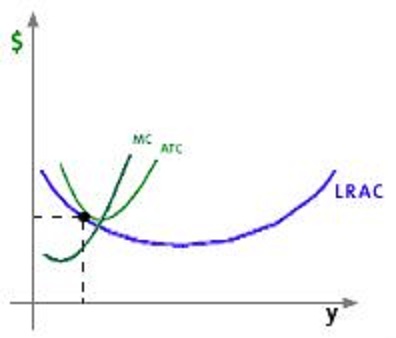
- Cost minimizing point
- what if we freeze capital at the level
of output corresponding to the lowest point on the LRAC curve?
(ME" another way of saying this is" what if we chose a factory
size that corresponds to the level of output at the lowest
point on the LRAC curve?)
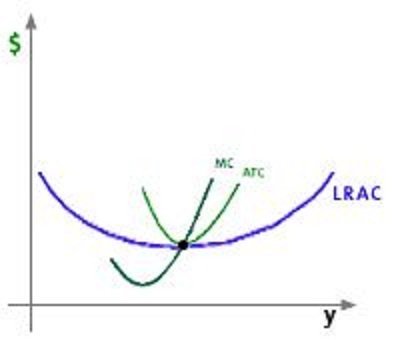
- Summary:
- REPEAT: in the short run the ATC will be
higher than the LRAC because in the long run there is more
flexibility (more options) of finding the cost minimizing
technique
- The LRAC curve is an "envelope" of all
the possible short run ATC curves
- only at the very bottom of he LRAC
curve are the two curves tangent at their lowest
points
- ME: it seems like we are missing a video
lecture because Tomlinson says, "we have looked at three extreme
cases of the LRAC curve", but we didn't. See your textbook and
study the three cases seen in the figure below
- constant returns to scale over a wide
range of output (or constant returns to scale)
- economies of scale over a wide range of
output (or increasing returns to scale)
- diseconomies set in at a low level of
output (or decreasing returns to scale)
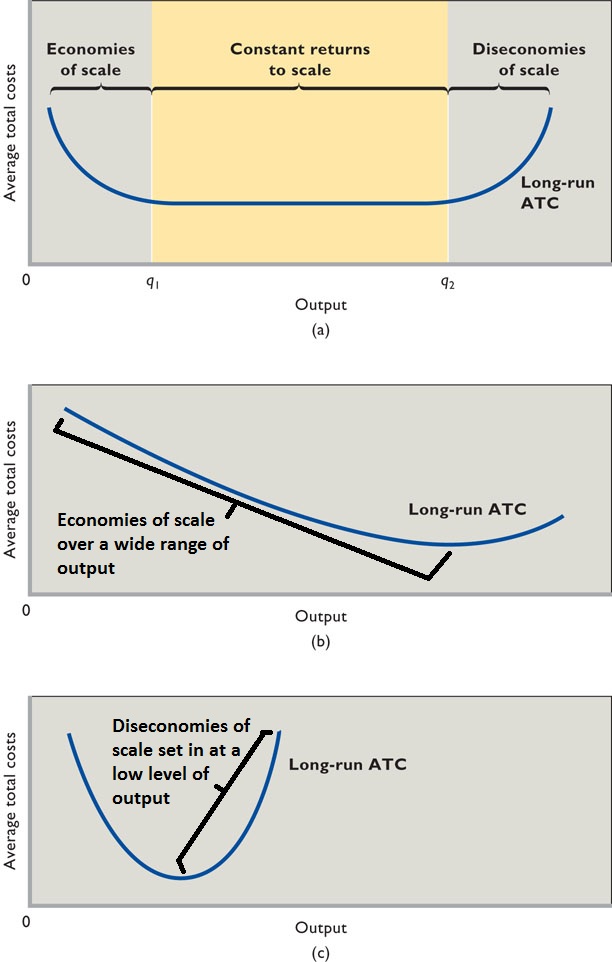
- Point of efficient scale
- U-shape LRAC
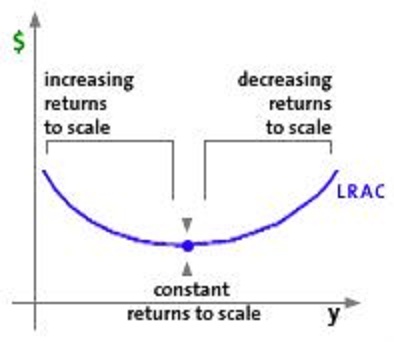
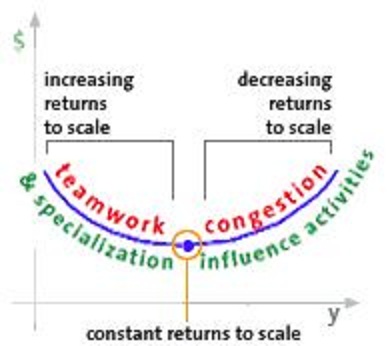
- the point at the bottom of the LRAC
curve is called Point of efficient scale
- the size where the long run average
costs are minimized; where ether is a very short area of
constant returns to scale on the figure above.
- (ME: our textbook discusses a similar
concept called the "minimum efficient scale" which is the
minimum level of output where the LRAC curve is minimized;
quantity Q1 on the figure below
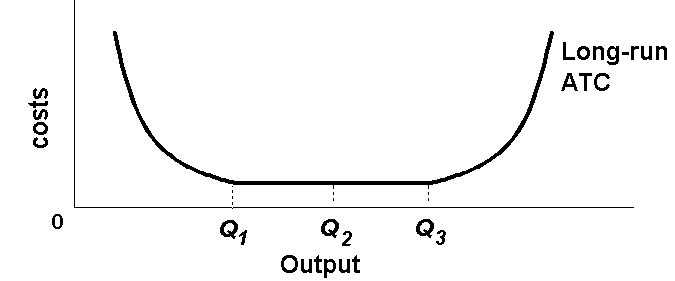
Pure Competition (Lessons 8/9a
and 8/9b)
LESSON 8/9a - PURE
COMPETITION: CHARACTERISTICS AND SHORT RUN EQUILIBRIUM
- MARKET STRUCTURE
- WHAT IS A PERFECTLY COMPETITIVE MARKET?
(PURE COMPETITION)
- PURE COMPETITION - SHORT RUN PROFIT
MAXIMIZATION
- PURE COMPETITION - SHORT AND LONG RUN
MARKET SUPPLY
MARKET
STRUCTURE
5.1.3
(10:55) Understanding Market Structure - 8/9a
- Outline
- The Relevance of Market
Structure
- Perfect Competition
- Monopoly
- Monopolistic
Competition
- Oligopoly
- The Relevance of Market Structure
- the structure of a market determines
whether a firm can exercise market power (set its own price) or
make a profit in the long run
- Perfect Competition
- large number of small firms
- producing identical products
- therefore each firm has no market power
(the-y are price takers)
- the demand for an individual firm is
therefore horizontal at the market price (perfectly
elastic)
- no barriers to entry; therefore if there
are short run profits then new firms will enter the industry
until economic profits equal zero (called a "normal profit)
until
- ME: an extreme market with few
real-world examples, BUT if it did exist it would be best for
society, i.e. in the long run competitive markets achieve both
allocative and productive efficiency
- Monopoly
- another extreme market with few
real-world examples
- only a single large producer serving the
whole market
- therefore they can set there own prices
(they have market power)
- the monopolist's demand curve is
downward sloping because it IS the market demand curve since
they are the only producer in the market
- monopolies arise because of very good
barriers to entry (ME: our textbook says that for a pure
monopoly entry is blocked)
- ME: in the long run monopolies are both
allocatively and productively INEFFICIENT
- Monopolistic Competition
- a hybrid of monopoly and competition
(characteristics of both)
- a large number of firms (like pure
competition)
- producing differentiated products; each
making their products a little different than their competitors
(each is like a little monopoly)
- this gives the monopolistically
competitive firms a little market power; some can charge high
prices if consumers prefer their product over
others
- ME: therefore the demand curve for each
firm is downward sloping but very elastic since for consumers
there are many other substitute products available
- the market demand curve is downward
sloping because it is the summation of the individual
demand curves of all firms in the industry
- no barriers to entry (ME: our textbook
says that there are some barriers, but they are low and easily
overcome)
- Oligopoly
- few firms
- may produce identical (standardized) or
differentiated products
- have a lot of market power
- BUT, since there are just a few
producers they carefully watch what their rivals are doing,
called mutual interdependence
- there are significant barriers to
entry
- what does the demand curve look like for
oligopolies:
- economists disagree
- the kinked demand curve is a
popular theory
- assume:
- that rivals ignore if one firm
raises its price because they will probably get more
customers
- but rivals will match the price
change if one firms decides to lower its price to try
to keep their customers
- ME: result: the demand curve will
be kinked
- it will be more elastic
(flatter) above the original price because if one firm
raises its price AND all of its competitors do not,
then the firm will lose A LOT of customers
- the demand will be less elastic
(steeper) below the original price because if one firm
decides to lower its price all of its competitors will
ALSO lower their prices and each would get only A FEW
new customers
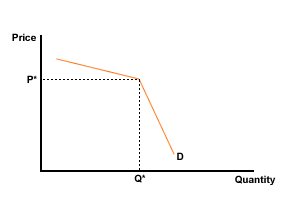
- Summary - ME: the textbook has a more
detailed table in lesson 89/9a -- Study it!
WHAT IS A
PERFECTLY COMPETITIVE MARKET? (PURE COMPETITION)
5.1.2
(3:43) Understanding the Role of Price - 8/9a
- Outline
- Market Power and Price
- a firm with market power can set
its own price
- firms with market power are
usually large relative to market size
- Perfect Competition
- a large number of
sellers
- selling identical goods
(standardized or homogeneous)
- no barriers to
entry
- Firm and Market demand in Perfect
Competition
- an individual firm's demand curve
is horizontal (perfectly elastic) at the market
price
- the firm is a price
taker
- total revenue equals price times quantity:
TR = P x Q or TR = P x Y
- market power determines the price a firm is
able to charge for its product
- market power is a firm's ability to
set the price of its product
- if a firm can raise the price of its
product without losing all of its customers to a
competitor
- if a firm can lower the price of its
product without attracting the entire market
- what determines if a firm has market
power?
- how large a firm is compared to the size of
the market
- perfect competition:
- large number firms
- each firm is small compared to the
market
- firms sell identical goods
- there are no barriers to
entry.
- they are price takers = no market
power
- each firms only produces a very small
share of total market demand
- identical product - therefore customers
do not care who they buy from
- the supply and demand in the market sets
the price for all of the firms (they are price
takers)
- and the demand for a single firm
is horizontal (perfectly elastic)
5.1.1
(3:36) Calculating Total Revenue - 8/9a
- Outline
- computing Total
Revenue
- plotting the total revenue
curve
- slope of the total revenue
curve
- total revenue equals price times quantity:
TR = P x Q or TR = P x Y
- ME: total revenue is how much the firm puts
in its cash register
- plotting the TR curve = a straight upward
sloping line
- the slope of the TR curve is equal to the
price of the product (the slope of the TR curve is 500 for
televisions in a perfectly competitive market selling television
sets)
- ME: Is the market for television sets
perfectly competitive? NO!
- there are not very many companies
producing television sets
- most television producers mare quite
large companies
- all television sets are not
identical
- there are barriers to entry -- what
would it cost for you to start a company to produce an sell
televisions?
- television producers do have market
power
- if one producer raises its price a
little it does not lose ALL of its customers
- If one producer lowers its price a
little it does not gain ALL television buyers
PURE
COMPETITION - SHORT RUN PROFIT MAXIMIZATION
5.2.1
(14:24) Finding the Firm's Profit Maximizing Output Level -
8/9a
- Outline
- strategies for profit
maximization
- understanding the competitive
firm
- marginal cost, price, and
profit
- marginal revenue and marginal
cost
- intuiting the maximum
profit
- GOAL: maximizing profits
- RULE: produce another television set as
long as it adds more to revenues than it adds to costs
- never produce another television set if
it adds more to your costs than to your revenues - this would
cause profits to decline
- in pure competition (a competitive
firms) should continue to produce as long as the price it gets
(P) is greater than its marginal costs (MC)
- if the marginal cost is less than its
price then produce more to add to your profits
- maximum profit occurs when P =
MC
- ME:
- this rule (P = MC) only works for
perfectly competitive firms
- ALL firms (including competitive
firms) maximize their profits when MR = MC
- we will study this in the next
lessons, but the MR=MC rule to find the quantity where a
firm receives the maximum profit does work for pure
competition as well
- the TC and TR graph
- why is the TR curve a straight
line?
- why does the TC curve have the
"backwards S" shape"?
- the MR and MC graph ("double decker"
graph)
- MR
- definition: the extra revenue that
a firm gets when it produces and sells one more
unit
- formula: change in TR / change in
Q
- also: MR is equal to the slope of
the TR curve
- graph: in pure competition (only)
the MR curve is a straight horizontal line that is equal
to the product price
- MR = P = $500; MR = Price ONLY IN
PURE COMPETITION
- in later lessons MR DOES NOT equal
price
- MC
- definition: the extra cost of
producing one additional unit of output
- formula: the change in TC / change
in Q
- also: MC is equal to the slope of
the TC curve
- graph:
- at first goes down then reaches
a minimum (where the inflection point is on the TC
curve)
- crosses the P (or demand) curve
at the profit profit maximizing level of output (Y* or
Qprof max)
- ME: I do not care too much
about the Y dagger quantity
- the profit maximizing level of
output using the TR and TC graph
- Y* in the video lectures; ME: I like
to simply use "Q" or "Q prof max"
- output level ( or quantity) where P =
MC
- ME: where the gap between the TC and
TC curves is the greatest (with TR being greater than
TC)
- Tomlinson: where the slope of TC =
slope of TR
- the profit maximizing level of
output using the P and MC graph
- Y*
- where P = MC (or MR = MC)
- at a quantity greater than Y* (Qprof
max) the MC is greater than price and therefore your profits
are declining; it is costing you more for each additional
unit produced (MC) than you are getting (P = MR)
- at a quantity less than Y* the MC
(extra cost of producing one more) is less than the price
(or MR) that you get, so if you produce more you will be
getting more than it costs you and your profits will
increase
- Ydagger is where your profits are the
lowest; any point less or more than Y dagger will be better
for the firm
- P=MC is the rule for maximizing
profits for a purely competitive firm as long as the MC curve
is increasing
5.2.2
(4:20) Proving the Profit Maximizing Rule (Pure Competition) -
8/9a
- Outline
- the rule for profit
maximization
- proving it with real
numbers
- discerning whether the max profit
point will yield a positive profit
- ME: the lecture begins with the table
below. Here he is using the production function from lectures
7.2-1 and 7.2-2 where "L" is the quantity of labor in our factory
(number of workers) and TP is total product or the quantity of
output produced (televisions). He then adds the MC (marginal cost)
data from lectures 7.3-3 and 7.3-4.
- profit maximized at a quantity of 48
television sets
- produce all as long as the price (MR) in
pure competition) is greater than MC up to where they are
equal
- maximizing a profit does not guarantee that
there will be a profit, it may mean that they are minimizing a
loss
- To tell if there will be a profit or loss
we need to use the AVERAGE cost graphs from lesson 7b.
- ME: ATC = TC/Q; Tomlinson: ATC =
TC/TP
- if the price is above ATC then the firm
is making a profit
- if the price is below the ATC then the
firm is making a loss
5.2.3
(12:26) Calculating Profit (Pure Competition using the cost curves) -
8/9a
- Outline
- Reviewing profit and
cost
- Examining a profitable
firm
- Determining total revenue from a
graph
- Figuring out who get the
revenue
- In summary
- ME:
- These graphs are important!
- the lecture uses slightly different
abbreviations than does our textbook
- VC (variable costs) in the lecture =
TVC (total variable costs) in the textbook
- FC(fixed costs) in the lecture = TFC
(total fixed costs) in the textbook
- profit = TR-TC
- profit per unit = P - ATC
- ATC = AVC + AFC
- ME: you must be able to find the AFC from a
graph that has only ATC and AVC (hint: AFC = ATC-AVC or the
distance between the ATC and the AVC)
- the ATC and AVC curve get closer and closer
together BECAUSE as production is increases (as you move to the
right on the graph) the AFC is getting smaller and
smaller
- Adding the price (MR in pure competition)
to the graph as a straight horizontal line at the price
($500)
- The video lecture will ask
you a multiple choice question. ANSWER THE QUESTION by selecting
A, B, or C and more of the lecture will follow
- the profit max quantity is where P=MC as
long as MC is increasing, Y* or Qprofitmax
- The next thing to do is to use the graph to
calculate how much profit (or loss) the firm is making
- Profit is TR - TC
- Use the graph to find the AREAS that
represent TR and TC
- TR is the area on the graph that represents
P x Q
- ME: YOU MUST BE ABLE TO FIND THE
RECTANGLE ON THE GRAPH THAT REPRESENT TOTAL REVENUE
(TR)
- Who gets this revenue that the firm brings
in?
- how to find TVC on the
graph
- the AVC curve tells you the labor
costs (or all variable costs) per unit (per television
set)
- AVC x Q = TVC, or according to
the video lecture AVC x Y* = total labor cost
- ME: YOU MUST BE ABLE TO FIND THE AREA
ON THE GRAPH THAT REPRESENTS TVC
- how to find TFC on the
graph
- the ATC curve tells us the total
costs of producing this quantity of output (television
sets)
- AFC = ATC-AVC
- TFC = AFC x Q
- ME: YOU MUST BE ABLE TO FIND THE AREA
ON THE GRAPH THAT REPRESENTS TFC
- how to find TC on the
graph
- TC = TVC + TFC or ATC x Q =
TC
- ME: YOU MUST BE ABLE TO FIND THE AREA
ON THE GRAPH THAT REPRESENTS TC
- how to find profit or loss on the
graph
- TR - TC = profit
- ME: YOU MUST BE ABLE TO FIND THE AREA
ON THE GRAPH THAT REPRESENTS PROFIT
- Summary
5.2.4
(9:13) Calculating Loss (Pure Competition) - 8/9a
- Outline
- A firm earning a loss, but still
produces in the short run
- when price falls
- figuring out how TR is
distributed
- A firm earning a loss but shuts down
in the short run
- when AFC exceeds
price
- the shut down
point
- Always label the axes !!!
- A firm earning a loss, but still
produces in the short run
- what happens if the price drops and is
now between the ATC and the AVC?
- find the profit maximizing level of
output where P=MC or MR=MC
- Y* or Qprofitmax
- find the area that shows total revenue
on the graph
- find the area that shows TVC on the
graph
- The video lecture will
ask you a multiple choice question. ANSWER THE QUESTION by
selecting A, B, or C and more of the lecture will
follow
- find the area that shows the TFC on the
graph
- find the area that shows the TC on the
graph
- NOTE: price is now less than the ATC,
therefore they are losing money on each television that it
sells
- find the loss on the graph, YOU MUST BE
ABLE TO FIND THE AREA THAT REPRESENTS THE LOSS ON THE
GRAPH
- QUESTION: in the short run, if you are
earning a loss will you keep producing television sets or would
you shut down and not produce anything (Q = 0)?
- The video lecture will
ask you a multiple choice question. ANSWER THE QUESTION by
selecting A, B, or C and more of the lecture will
follow
- ANSWER: you should continue producing in
the short run because:
- if you shut down:
- your total revenue will equal
zero
- your TVC (labor costs) will equal
zero
- BUT, you still have to pay your
fixed costs (TFC)
- if you continue to operate your
revenues are enough to cover all of your variable costs AND
some of your fixed costs
- therefore: if you continue to operate
your loss will be smaller than if you shut down and produce
nothing
- A firm earning a loss but shuts down in
the short run
- RULE: a firm should shut down if the
price is below the minimum average variable costs (minimum
point of the AVC curve)
- more int he next video lecture
(8.4-1)
5.2.5
(8:35) Finding the Firm's Shut-Down Point (Pure Competition) -
8/9a
- Outline
- when is it optimal to shut
down?
- when TR = TC
- when the price falls below
AVC
- in summary: rules to operate
by
- shut down in the short run if the loss you
get by shutting down is less that the loss you would have if you
continued to produce
- on the graph the first thing you do is find
the the profit maximizing point
- The video lecture will ask
you a multiple choice question. ANSWER THE QUESTION by selecting
A, B, or C and more of the lecture will follow
- in this example the price happens to be at
the point of minimum AVC, we know this because this is where the
MC crosses the AVC
- note in this case the TR is equal to our
TVC,
- but we still have TFC to pay so we are
earning a loss that is equal to the TFC
- should the firm shut down or continue to
operate?
- if it shots down it loses it
TFC
- if it continues to operate it will also
make a loss equal to tis TFC
- so it doesn't matter if it continues or
if it shuts down
- if the price falls even lower
- then the TR will not be enough to even
cover the TVC
- therefore it would make more sense to
shut down because you loss will be less if you shut down than
if you continued to produce
- RULE:
- in pure competition, in the short
run, you should shut down if the price is less than the
AVC
- if the price > AVC you should
continue to produce even if you are making a loss
- if the price < AVC and you should
shut down and your loss will be equal to your TFC
- if the price < AVC and you
continue to produce, then your loss will be greater
- the minimum point of the AVC is called
the shut down point
- The short run supply curve for a purely
competitive firm is the MC curve above the AVC
PURE
COMPETITION - SHORT AND LONG RUN MARKET SUPPLY
5.3.1
(20:44) Deriving the Short-Run Market Supply (Pure Competition) -
8/9a
- Outline
- Conditions for determining the short
run supply curve
- Finding the ideal output for a
firm
- Getting the market supply curve from
single supply curves
- Conditions for determining the short run
supply curve
- firms are purely competitive and
therefore are price takers
- the firm will maximize its profits at
the quantity where P = MC and the MC is upward
sloping
- a firm will shut down in the short run
if the P< minimum AVC
- finding the short run supply curve for the
market from the graphs for three individual firms or
factories
- Remember to label the axes !
- What is a supply curve? = a schedule that
shows the various quantities that firms will produce a various
prices in a given time period, ceteris paribus
- if the price is too low, none of the firms
will produce any output, Why not?
- The video lecture will ask
you a multiple choice question. ANSWER THE QUESTION by selecting
A, B, or C and more of the lecture will follow
- note that the three firms have different
shut down points because these firms either
- have different technologies, some that
can produce cheaper
- the first firm may have a bigger factory
which can produce at a lower cost, or
- the firms may have to pay different
wages for their their workers, but this is unlikely in a purely
competitive market
- if the price rises so that it is high
enough to cover the variable costs of only one firm than that firm
will produce, but the other two still will not produce since the
price is below their shut down points.
- this quantity becomes a point on the market
supply curve
- if the price rises again, the first firm
will produce more moving along its MC firm, so in the market the
market supply is the same as the first firm's MC curve
- when the price rises high enough now the
second firm will find it profitable to produce as well, Therefore
on the market supply curve there will be a "jump" in production,
i.e. quantity increase a lot when firm 2 enters the
market
- at higher prices the market supply curve is
the total of the MC of the firms 1 and 2
- when the price gets up to the shut down
point of firm three then it will enter the market nd there will be
another jump in the market supply since all three are now
producing
- at even higher prices the market supply
curve is the total of the MC curves of all three firms
- summary: jumps occur in the market supply
curve when the price gets up to the shut down points of additional
firms
- but if there are more than three firms,
like if there are very many firms, there will be many more jumps
and if each firm is small each jump will be very small, do
therefore the short run supply curve for the market will become
smoother
- the short run supply curve for the market
will be the sum of the short run supply curves of all the firms in
the market
5.3.4
(9:13) Deriving the Long-Run Market Supply Curve (Pure Competition) -
8/9a
- Outline
- Long run equilibrium
- Increasing cost
industry
- Constant cost
industry
- Decreasing cost
industry
- market graph on the left and individual
firm graph on the right
- long run equilibrium, "firm is making zero
economic profit and the firm is producing at point of efficient
scale"
- long run equilibrium means no firm wants to
change its behavior
- the firm is maximizing its profit by
producing at the quantity where P = MC and it is earning zero
economic profits" therefore no tendency for entrance or
exit
- ME: how can the firm stay in business if it
is earning ZERO ECONOMIC PROFIT?
- what happens if the demand for the product
increases causing the price of the product to increase?
- now, with the higher price, the firm is
earning profits. and new firms will enter the market (ME:
remember: in pure competition there are no barriers to
entry)
- therefore the supply will increase due
to an increase in the number of producers (ME: this would be a
good time to review the non-price determinants of supply in
lesson 3b)
- Noe the question is: what happens to the
cost of resources used by firms in this industry when new firms
enter the market producing more?
- there are three option:
- costs could increase due to an
increase in demand for limited resources because of the new
firms
- therefore the long run cost curves
for all firms will shift upwards
- this is called an increasing
cost industry: as the industry expands, competition
for limited resources will increase the costs of all
firms in the industry
- example: computer industry in the
late 1970s because of the limited supply of computer
programmers
- therefore the price of the product
will not fall back to the original price but the new
equilibrium price will be higher, at the point of the now
higher minimum point of the new long run cost
curve
- the long run supply curve shows
what happens to an industry's minimum cost as the
industry expands
- costs could stay the same, called a
constant cost industry
- as the industry expands (new firms
enter), costs do not change for the firms in the
industry
- the result would be a long run
supply curve that is horizontal at the original
price
- ME: this is because this industry
really does not use a very large proportion of all of the
resources available
- costs could go down as new firms
enter, called a decreasing cost industry
- this might occur if as the
industry expands the resources, labor can come up with
new cheaper ways to produce the product
- this would cause the costs of
production for all firms to fall
- this would result in a long run
supply curve that is downward sloping
LESSON
8/9b - PURE COMPETITION - LONG RUN EQUILIBRIUM AND
EFFICIENCY
From
Short-run to Long-run in Perfectly Competitive Markets
(econclassroom.com 21:23) - 8/9b
http://www.econclassroom.com/?p=3018
Why a firm in a perfectly competitive market
will only earn normal profits (zero economic profits) in the long
run.
Review:
- In a perfectly competitive market the
market supply and market demand determine the price and marginal
revenue for each individual firm in that market
- for each individual firm the demand is
perfectly elastic at the market price and the marginal revenue
will be equal to the price
- two graphs: one for the market and one for
the individual firm
- supply and demand curves for the whole
market which includes all of the individual firms
- graph for the individual firm
includes:
- D=P=MR
- MC
- AVC
- ATC (per unit cost of the firm's
output)
- the profit maximizing quantity for the
individual firm will occur where MR = MC
- The equilibrium quantity in the market will
be equal to the profit maximizing quantity for the individual
firms times the number of firms
- The video shows a graph where a firm is
breaking even and economic profits = zero
- TR minus TC = zero
- the firm is earning a normal profit
which means that its total revenue (TR) is enough to just equal
all of its explicit costs AND the implicit costs of paying the
entrepreneur (owner) a salary to keep him/her in
business
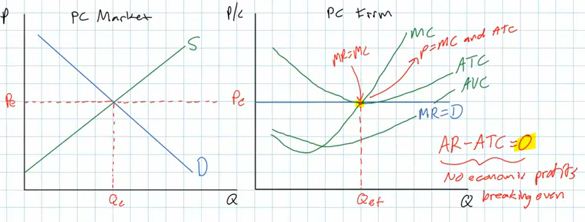
Long Run Equilibrium
A normal profit (zero economic
profits) is what we would expect individual firms in a perfectly
competitive market to earn in the long run because there are no
barriers to entry.
And in long run equilibrium the P = MC
(allocative efficiency, more later) and P = minimum ATC
(productive efficiency, more later).
The individual firms are producing the
quantity where their costs per unit (the ATC) are the
lowest.
if the firms produce any other
quantity (less or more) then the costs per unit (ATC) will be
higher than the price and they would earn economic losses
[ME: meaning that they could make more by quitting this
business and going to their next best alternative.]
Why do perfectly competitive firms only earn
a normal profit in the long run?
- What if they are earning short run profits
due to an increase in demand for their product?
- on the market graph the market demand
will shift to the right resulting in higher equilibrium market
price
- on the graph for the individual firm the
higher market price is shown as a shift upwards of their
perfectly elastic D= P curve which is also their MR curve
(D=P=MR)
- each individual firm then will respond
to the higher market price by producing a higher quantity since
they will always try to maximize their profits by producing
where MR = MC, and this now occurs at a higher level of
output
- this higher price and quantity for
each individual firm will result in short run economic
profits
- ME: with the higher price and
quantity its total revenue (TR) will be a lot
higher
- its total costs (TC) will be only a
little higher. Note the ATC curve does not shift, but rather
as firms increase output they move slightly up their
existing ATC curves
- and the yellow rectangle represents
the firms new short run profits caused by an increase in
market demand
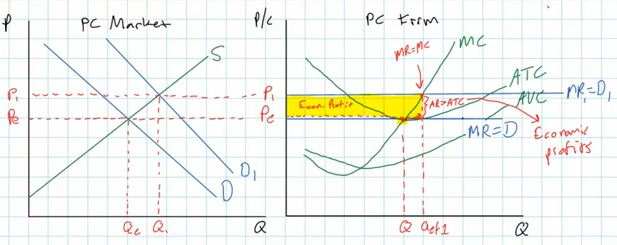
- But, what will happen in the long
run?
- these short run economic profits will
attract new firms to the industry. REMEMBER: in pure
competition there are no barriers to entry so new
firms can easily enter the industry to try to capture some
of these economic profits.
- so, what will happen to our graphs
if new firms enter?
- one of the non-price determinants
of supply is the number of producers. If the number of
producers goes up, then the market supply will increase
and shift to the left.
- this will cause the market price
to fall and the P=D=MR curve for the individual firms to
fall
- the individual firms then will no
longer be earning short run profits and in the long run
they will be back to zero, or normal, profits
- Entry Eliminates
Profits
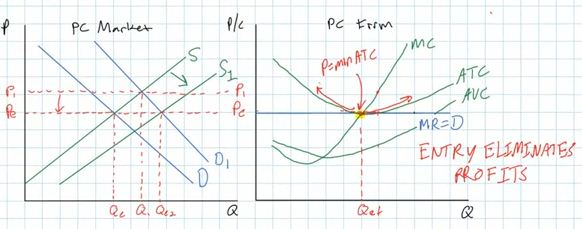
- ME: so what has happened in this
perfectly competitive industry in response to an increase in
demand?
- Earlier we said: "The equilibrium
quantity in the market will be equal to the profit
maximizing quantity for the individual firms times the
number of firms"
- because of the increase in demand
and the increase in supply that resulted from it the
equilibrium quantity in the market has increased from Qe
to Qe2 on the graph above.
- each individual firm is still
producing the same quantity as before (Qf) after
temporarily producing a larger quantity
- But, there are now more firms in
the industry each producing QF at the original price of
Pe.
- This is good for consumers
(society) . We wanted more (increase in demand) and we
got more at the same price.
- What if they are earning short run losses
due to a decrease in demand for their product?
- Assume that initially all individual
firms are earning zero (normal) profits
- if demand decreases the market demand
curve will shift to the left and the equilibrium price will
fall
- for the individual firms this means that
their D-P- MR curve will shift downward
- firms always want to maximize their
profits so they will produce the quantity where MR=MC, which is
now at a lower quantity
- and at this new profit maximizing
quantity the price is now below their ATC and they will now be
earning economic losses.
- price is lower, so TR is
lower
- ATC is now higher
- so their ATC is now > P
- ME: Price (P) and Average Revenue
(AR) mean the same thing
- and Profits = TR - TC = will be
negative (economic losses)
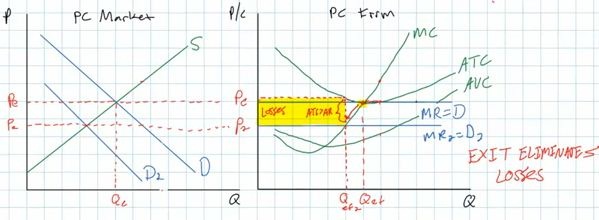
- How will firms respond to these short
run economic losses?
- Exit Eliminates Losses
- due to the short run losses some
firms will leave the industry
- remember an economic loss means
that they can make more at their next best
alternative
- and since there are no barriers to
entry or EXIT, it is easy for firms to leave and go to
their next best alternative
- this will decrease the number of
producers and decrease the market supply
- causing the equilibrium market price
to increase
- for each individual firms this will
shift their D = P = MR curve upward
- and they will respond by producing
where MR = MC which will be at a higher quantity and they
will be earning normal (zero) profits again
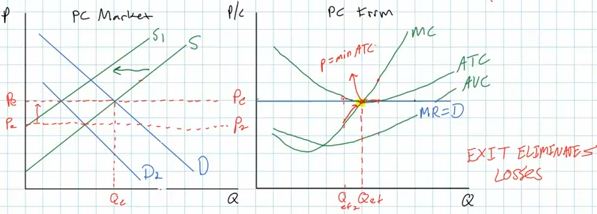
- after all adjustments the price will
again be equal to the minimum ATC, where the MC crosses the
ATC
- and P = ATC = MC
- ME: So, in the long run in a perfectly
competitive market we will always get:
- normal (zero) profit
- P = minimum ATC
- P = MC
- Next lesson: Perfect Competition and
Efficiency
Allocative
and Productive Efficiency in Perfectly Competitive Markets
(econclassroom.com 19:35) - 8/9b
http://www.econclassroom.com/?p=3066
Why a firm in a perfectly competitive
market will achieve allocative and productive efficiency in the long
run.
Introduction
- "In order to understand what makes less
competitive markets inefficient, we first must understand what it
is that makes perfectly competitive markets
efficient."
- Imperfectly competitive markets: monopoly,
oligopoly, monopolistic competition
Review
- Productive efficiency:
- productive efficiency is producing at
the lowest cost
- on a graph this is the lowest point on
the ATC curve (minimum ATC)
- this means the firm is using its
resources wisely and not wasting any resources
- "Productive efficiency occurs if the
price of the good is equal to the minimum ATC"
- ME: and, as we should already know, the
MC curve crosses the ATC curve at the lowest point of the ATC,
so we find the productively efficient quantity by finding the
quantity where MC = ATC
- Allocative Efficiency
- when the quantity of output produced
achieves the greatest level of total welfare (ME: satisfaction)
possible
- producing the quantity where the
consumer and producer surplus is maximized
- ME: producing the quantity where MSB =
MSC (marginal social benefit = marginal social cost from
lessons 3c, 5a, and 5.)
- ME : producing the quantity that
maximizes society's satisfaction
- ME: producing more of what people want
and less of what they don't want (more music downloads and less
CDs)
How Perfectly Competitive Markets achieve
Productive Efficiency in the long Run
- Productive efficiency:
- productive efficiency is producing at
the lowest cost
- on a graph this is the lowest point on
the ATC curve (minimum ATC)
- this means the firm is using its
resources wisely and not wasting any resources
- "Productive efficiency occurs if the
price of the good is equal to the minimum ATC"
- ME: and, as we should already know, the
MC curve crosses the ATC curve at the lowest point of the ATC,
so we find the productively efficient quantity by finding the
quantity where MC = ATC
- firms achieve productive efficiency if P
= MC = ATC
- On the graph of a perfectly competitive
firm in long run equilibrium
- the firm will produce the4 quantity
where MR = MC because this is its profit maximizing quantity
(Qf on the graph below)
- and, we can see that the profit
maximizing quantity is also the quantity where the ATC is at a
minimum (Qf on the graph below)
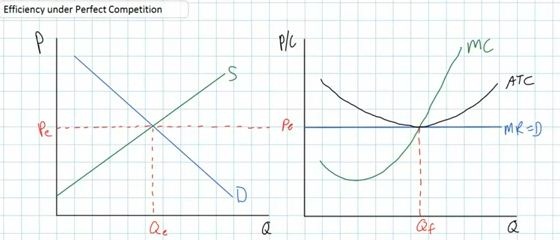
- So, purely competitive firms will
achieve productive efficiency in the long run
- what would happen if the price was
higher than ATC?
- the firm would produce
more
- and the profit maximizing quantity
will not be at the lowest point of the ATC curve; not where
MC = ATC
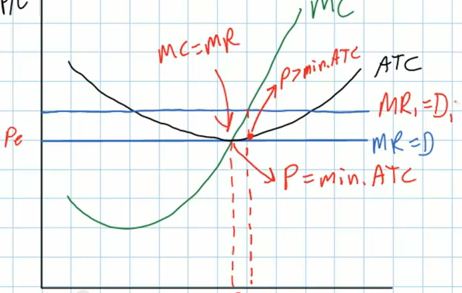
- so, in the short run this firm is not
productively efficient, but it is now earning economic
profits
- and as we learned in the previous
video lecture, these profits will attract new firms, and
because there are no barriers to entry, this will increase
supply and decrease the price until each firm is again
producing the quantity where the P = minimum ATC
- and in the long run productive
efficiency is achieved in perfectly competitive markets (P =
minATC)

How Perfectly Competitive Markets achieve
Allocative Efficiency in the long Run
- Allocative Efficiency
- definition of allocative
efficiency:
- when the quantity of output produced
achieves the greatest level of total welfare (ME:
satisfaction) possible
- producing the quantity where the
consumer and producer surplus is maximized
- ME: producing the quantity where MSB
= MSC (marginal social benefit = marginal social cost from
lessons 3c, 5a, and 5b)
- ME : producing the quantity that
maximizes society's satisfaction
- ME: producing more of what people
want and less of what they don't want (more music downloads
and less CDs)
- consumer surplus (CS)
- is the total well being of consumers who
are willing and able to pay a higher price than the equilibrium
price in the market
- graphically consumer surplus is the area
of the triangle below the demand curve and above the
equilibrium price (the yellow area on the graph
below)
- producer surplus (PS)
- is the total welfare of producers who
are able to sell their product at a price greater than their
cots of production
- is the total welfare gained by producers
who were able to sell their product a price higher than the
price they were willing to accept
- graphically, producer surplus is the
area above the supply curve but below the equilibrium price
(the blue triangle on the graph below)
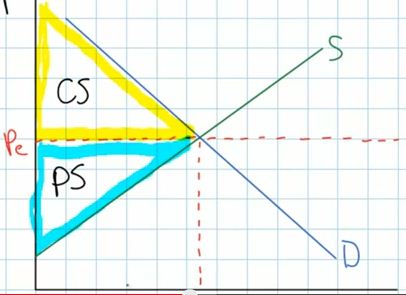
- So, in long run equilibrium a perfectly
competitive market will produce the quantity where consumer and
producer surplus is maximized and MSB = MSC
- if less is produced (Q1)
- we can see that MSB > MSC and this
means too little is being produced
- ME: I have use the terms MSB (marginal
social benefit) and MSC (marginal social cost) , here the
instructor is calling these just MB and MC
- if more than the long run equilibrium
quantity is produced (Q2):
- MSB<MSC (video MC>MB) and society
would be better off with less because the extra benefits that
they are getting from one more unit of output is less than its
costs
- ME: remember that all costs are
opportunity costs so if MSB<MSC this means that the costs to
society of producing more are the lost benefits that we could
have gotten if we produced something else. If MSC are high this
means that something else would give us more
satisfaction.
- and allocative efficiency is not
achieved
- So allocative efficiency is achieved at
that quantity where MSB = MSC (MB = MC)
- this is also called the "socially
optimal quantity"
- For the individual firm (the graph on the
right)
- MSC = MC
- MSB = P
- so allocative efficiency is achieved
where P=MC
- ME: why is the price we have to pay for
a product a benefit? Isn't that a cost?
- price is a benefit to the consumer
because it measure the benefits that the consumer is getting
from the product
- if consumers who are part of society
get a lot of benefits from a product they would be willing
to pay more. If consumers get few benefits from a product
they would only buy it if the price was less
- for example I would pay more to ski
in the mountains of Colorado (where I am now as I type these
notes) than I would pay to ski the hill of Wisconsin because
I get more benefits (more fun) skiing in
Colorado
- ME:We know that all firms what to
maximize profits so they will produce the quantity where MR=MC.
We can see on the graph below that this perfectly competitive
firm in long run equilibrium will produce the quantity Qf to
maximize its profits. But note that this is also where P=MC..
So even though all the firm was trying to do was to make as
much money as possible it will firm also achieve allocative
efficiency. This is the INVISIBLE HAND of competition that we
talked about in lesson 2a.

- SUMMARY: Competitive firms achieve
allocative efficiency in the long run
- All firms will produce the quantity
where MR=MC to maximize their profits
- Because of the lack of barriers to
entry, competitive firms will receive only normal profits in t
he long run
- But the long run profit maximizing
quantity will also be the allocatively efficient
quantity:
- the quantity where P =
MC,
- the quantity where MSB =
MSC
- and the quantity where the sum of the
consumer and producer surplus is maximized
- WHY?
- perfectly competitive firms achieve
allocative efficiency in the long run because the demand curve
for the individual firm is perfectly price elastic
- i.e. they are "price
takers"
- Since there are very many firms
producing standardized (identical) products, firms do not
have any control over the price of the product
- this means that each individual firm
can sell all they have at the market price
- This means that the P = MR
- since they don't have to lower their
price to sell more
- the extra revenue that they get when
they sell one more is the same as the price
- THEREFORE: when competitive firms try
to find the quantity where MR=MC to maximize their profits,
it will also be the quantity where P=MC. So when they
maximize their profits they also achieve allocative
efficiency
- P = MR for perfectly competitive firms
ONLY
- we will see in other product market
models that the P > MR, i.e. the price they receive is
greater than the extra revenue (MR) they get when they sell
one more
- only for price takers with perfectly
elastic demand curves does the P always equal MR
- firms in other product market models
must lower their price to sell more so, as we will see in
future lessons P>MR
- therefore, when firms in the other
market models produce the quantity to maximize their profits
(quantity where MR=MC, it will not be the allocatively
efficient quantity (where P = MC).
- To understand this better, let's see what
happens if the competitive firms produce less than the profit
maximizing quantity (Q1 on the graph below).
- at Q1 we can see that MR does not
equal MC so the firm is not maximizing its profits
- in fact, we can see that ATC is greater
than P , So TC will be greater than TR and the firm is
l
- earning a loss
- ALSO, P > MC so there is an
underallocation of resources toward this product. Too little is
being produced. Remember, P measures the MSB and MC measures
the marginal social costs (assuming that there are no
externalities, so if P>MC then MSB>MSC and society would
be happier with more.
- Now if we assume that all firms are
producing at Q1 on their individual cost curves then the market
quantity being produced will also be less then the equilibrium.
so on the market supply and demand graph Q1 would be produced,
not the profit maximizing equilibrium quantity Qe.
- At this smaller quantity the MB to
consumers is greater than the MC
- This is allocative inefficiency because
society is getting less satisfaction
- Using the consumer and producer surplus
model:
- allocative efficiency is achieved
when the consumer and producer surplus is
maximized
- this occurs at the equilibrium level
of output
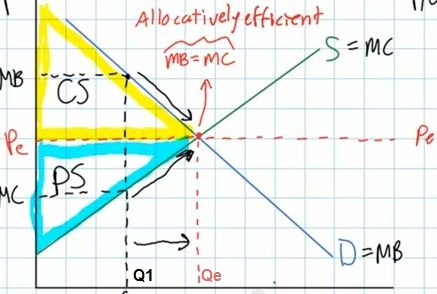
- but if the quantity is less than Qe,
like Q1 then the total consumer plus producer surplus is
less (see the green area on the graph below
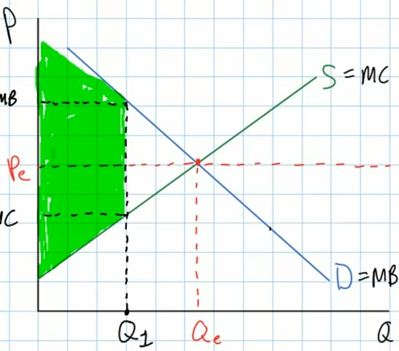
- and there is a loss of satisfaction
to society (less consumer and producer surplus) equal to the
yellow triangle on the graph below. this is what economists
call the "deadweight loss" of allocative inefficiency
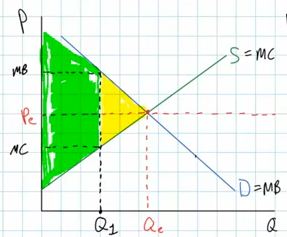
- We Since less than the efficient
quantity is being produced we say that resources are
underallocated to this product, i.e. society would
gain satisfaction (equal to the yellow triangle) if more
resources were used so that more was produced. This is
allocative inefficiency.
- if firms produced more than the
allocatively efficient (and profit maximizing) quantity then
again we would have allocative inefficiency. This time MC
will be > P, and resources will be overallocated to the
production of this product. Too much is being produced.
Society would be happier if less of this was produced and
more of something else that gives us more
satisfaction.
- in the market at Q2 on the graph
below, MSB<MSC
- ME: remember the opportunity cost
(MSC) of consuming this product is the satisfaction that
you are not getting from your next best alternative. So
if extra benefits that you are getting from this product
(MSB or D) is less than the benefits that you could get
from something else (MSC or S) then society would be
better off with less of this product. We say that
resources are overallocated to the production of this
product.
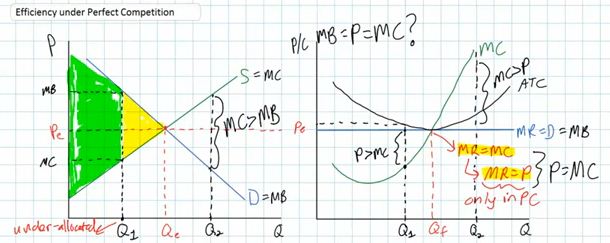
Perfectly competitive firms achieve both
productive and allocative efficiency in long run
equilibrium
- they will produce the profit maximizing
quantity where MR=MC
- and this quantity will also be the
productively efficient quantity where ATC is at its minimum
point
- and, this quantity will also be
allocatively efficient where P=MC
Pure Monopoly and Regulation
(LESSONS 10a and 10b)
LESSON 10a - MONOPOLY:
CHARACTIERISTICS AND SHORT RUN EQUILIBRIUM
- MONOPOLY
- PROFIT MAXIMIZATION FOR A MONOPOLY
- OPTIONAL
MONOPOLY
6.1.1
(10:10) Barriers to Entry - Defining Market Power -
10a
- Outline
- Market power
- Sole ownership
- Government created
Monopolies
- Natural Monopoly
- Summary
- If a firm that has a highly desirable
product and is the ONLY producer, what price will the firm
charge?
- a firm has market power if it is
able to influence the market price of its product
- the firm is able to set the price of its
own product
- the firm is a price setter
- a monopoly is a single seller of a
good or service
- monopolies are quite rare
- monopolies arise from one of three factors:
ME: our textbook calls these "barriers to entry")
- a firm that has sole ownership of a
particular resource used to produce a good
- e.g. diamonds: the deBeers diamond
company owned almost 80% of the world's diamond
mines
- e.g. if one company owns the only
place for selling concessions in an airport
- a monopoly that is created by government
action like patents, copyrights, or special licenses
- e.g. pharmaceuticals companies that
develop a new drug receive a patent to be the sole seller
for a certain length of time
- sole licenses granted by the
government to one company; e.g. the Hudson Bay
Company
- a natural monopoly arises because
of the interaction between the size of the market and the
efficient scale of operation of a single firm
- the lowest point of the long run
average cost curve show the efficient scale, or "right size"
for a firm in the long run
- ME: this is the productively
efficient quantity where costs per unit are minimized.
Recall that productive efficiency means producing at a
minimum cost. The productively efficient quantity then
occurs in the long run where the MC crosses the ATC
(MC=ATC)
- note that this is what happens in the
long run for purely competitive firms
- if the point of efficient scale
(productively efficient quantity) is small compared to the
total demand in the market then there can be many firms int
he industry providing this product, ALL producing at the
point of efficient scale (Productive efficiency)
- BUT, in a natural monopoly just ONE
FIRM can produce everything that is demanded and point of
efficient scale (the minimum point on the long run average
cost curve ) is BEYOND the demand curve. See how the demand
curve crosses the LRAC curve where it is still going
down
- this occurs when the industry has
very large economies of scale (the LRAC curve is downward
sloping over a wide range of output. This is a natural
monopoly because it makes for ether to be just one firm
producing the product because one firm (a monopoly) can
produce all that society demands at a lower cost than if
ether were more firms in the industry
- examples include: electrical
utilities (in the past) two sets of wires running to each
house i f there were two companies would be more
costly
6.1.2
(12:43) Defining Marginal Revenue for a Firm with Market Power -
10a
- Outline
- Marginal revenue
defined
- Total revenue
- Marginal revenue
table
- Graphing marginal
revenue
- Summary
- Example: you have a monopoly - the only
restaurant in an airport
- Problem: what price do you charge to
maximize profits?
- if you charge too high of a price many
people might just fly hungry
- if you charge too low of a price you
will attract more customers, but you will make less on each
one
- marginal revenue is the change in total
revenue that results form selling one more unit of
output
- MR = change in TR / change in Q
- the P and Q columns are your demand
curve
- calculate TR = P x Q
- ME why does the TR begin to decrease at
very low prices?: because demand is inelastic
- calculate MR = change in TR / change in
Q
- ME: MR is the slope of the TR
graph
- MR is negative when TR falls as you lower
the price too low and TR decline (demand in price
inelastic)
- How can you have less revenue when you
are selling more
- Graph:
- the demand curve
- downward sloping like in lesson
3a
- D=P=AR
- average revenue: AR =
TR/Q
- AR is the same as price
- the MR curve
- ME: our textbook plots the MR points
at the midpoints !!
- the MR is less than the price,
ALWAYS
- the MR curve lies below the demand
curve
- Why?
- why is the MR (the extra revenue
that we get when we sell one more unit) less than the
price at which we sold it?
- because in order to sell more the
firm has to lower the price on ALL units
PROFIT
MAXIMIZATION FOR A MONOPOLY
6.1.3
(14:18) Determining the Monopolist's Profit Maximizing Output and
Price - 10a
- Outline
- Marginal revenue
curve
- Graphing total
revenue
- Marginal cost curve
- Point of maximum
profit
- Problem for a firm with market power: what
price do you charge to maximize profits?
- if you charge too high of a price many
people might just fly hungry
- if you charge too low of a price you
will attract more customers, but you will make less on each
one
- How does a profit maximizing monopolist
choose the price for which it sells its product and the quantity
that it sells?
- ME: we will be using benefit-cost analysis.
It will continue to produce (and increase its profits) as long as
the extra benefits that it receives (MR) is greater than the extra
costs (MC)
- Review of MR: see above
- marginal revenue measures the extra
benefits that a monopolist gets when it sells one more unit of
its product
- remember: marginal revenue is always
less than the price
- What if there is no cost to produce the
product?
- in pure competition the price of a free
product would be free; this would be where P{=MC because MC
would be zero
- but a monopolist selling a product that
has no cost to produce, then you have market power and then
"you can maximize profits by charging a price equal to what the
market will bear"
- how to calculate TR and show on a
graph
- as long as your extra benefits, which in
this case is the MR is greater than zero (the extra cost), the
monopolist is adding revenue to its profits and profits will
increase. when MR = 0, then the TR are maximized.
- So if costs = 0, a profit maximizing
monopolist will produce where its MR = 0; then the produce the
quantity where MR = 0
- But what if there are costs? To maximize
profits you may not want to maximize your TR because your
profits depend on TR and TC
- add the marginal cost curve to the
graph
- and produce as long as the MR is greater
than the MC; the profit maximizing quantity is the quantity
where MR = MC !!!!! Know this !!!!!!
- keep producing more if MR >
MC
- never produce where MR < MC because
this will make your profits smaller
- the profit max Q is where MR=MC
- yes, this last unit (marginal unit)
is adding nothing to your profits
- but, if you produce where MR=MC you
know that you have also produced ALL the units where MR >
MC and this will maximize the profits
- how do you find the price that the
monopolist will charge for the profit maximizing quantity? To
find the price you must go up to the demand curve at the
Qprofmax
- ME: in pure competition you did not have
to go up to the demand curve to find th price because the
demand curve was horizontal, BUT for all other market models
you MUST get the price from the D or P curve.
6.1.4
(6:24) Calculating a Monopolist's Profit and Loss -
10a
- Outline
- Average total cost
curve
- Calculating profit
- Graphing profit
- Monopoly with a loss
- to maximize profits a monopolist will
produce the quantity, and charge the price, where
MR=MC
- charging the "profit maximizing price" does
not guarantee a profit; monopolies can earn losses, but the MR=MC
rule will minimize losses
- good review of the ATC curve
- a monopolist earning a profit
- profit = TR - TC
- TR = P x Q
- ME: I do not stress the "per unit
profit" or "profit margin"; it just seems to be an additional
step that is not necessary
- be able to find the following on the
graph: Q, P, ATC, TC, TR and profit
- especially the TR, TC, and profit
rectangles
- REMEMBER: once you find the quantity
where MR=MC you must got up to the demand curve to get the
price
- a monopolist earning a loss
- be able to find the following on the
graph: Q, P, ATC, TC, TR and loss
- especially the TR, TC, and loss
rectangles
- ME: the video lecture does not discuss the
shut down situation. See the textbook for this.
- Summary
- a monopoly will maximize profits by
producing where MR=MC
- if the P > ATC then the monopoly will
make a profit
- if the P < ATC then the monopoly will
make a loss
LESSON
10b - MONOPOLY: LONG RUN EQUILIBRIUM, EFFICIENCY, AND
REGULATION
- THE SOCIAL COST OF MONOPOLY
- REGULATING NATURAL MONOPOLIES
THE SOCIAL
COST OF MONOPOLY
6.2.1
(12:22) Determining the Social Cost of Monopoly - 10b
- Outline
- The missing supply
curve
- Price in a competitive
market
- Price in a monopoly
- Costs imposed by the
monopoly
- Introduction
- why are monopolies so
unpopular?
- maybe because they are imposing costs on
society
- ME: the textbook discusses how
monopolies, in the long run, are allocatively and productively
INEFFICIENT, that is:
- they do not produce the quantity that
would maximize society's satisfaction = dead weight loss
(allocative efficiency); monopolies will charge a higher
price and produce a smaller quantity than if we had a
competitive market
- the do not produce at the minimum
cost (productive efficiency
- The missing supply curve
- what does "supply" mean in economics
(see lesson 3b)
- monopolies are price setters therefore
there is no supply curve
- monopolies are not given a price, they
set the price
- Price in a competitive market
- ME: If this market were competitive
(lessons 8/a and 8/9b), then if the price were high and profits
existed, new firms would enter (remember: no barriers to entry)
and this would drive the price down to the MC. What quantity
would a competitive firm produce? The quantity where P=MC (or
demand = MC). This is the allocatively efficient quantity.
According to the textbook allocative efficiency occurs when
P=MC. Purely competitive firms are allocatively efficient. Are
monopolies?
- be able to find the price and quantity
that would occur if the market were competitive because this is
where "economic value" is maximized. ME: our textbook uses the
term "allocative efficiency".
- The demand curve measures the benefits
that that consumers get from a unit of the product and the MC
curves measures the costs of producing that extra unit. As long
as the marginal social benefits (MSB) are greater than the
marginal social costs (MSC), society is gaining satisfaction.
Society's satisfaction is maximized where MSB=MSC, or on our
graph, where P=MC (assuming no externalities exist) ME: this is
what our textbook calls the allocatively efficient quantity.
But do we get this quantity if this were a
monopoly?
- Price in a monopoly
- a monopoly will produce the quantity
that maximizes its profits; the quantity where
MR=MC
- the monopoly's profit maximizing
quantity is LESS THAN the quantity that maximizes society's
satisfaction (where MSB=MSC or where P=MC)
- you should be able to find the profit
maximizing quantity (WHAT WE GET) on the graph and the
allocatively efficient quantity (WHAT WE WANT)
- this imposes a cost on society because
less will be produced. A monopoly will not produce additional
units EVEN THOUGH the MSB of those units is greater than the
MSC (or the demand is above the MC)
- monopolies try to maximize profits, not
maximize society's satisfaction (allocative efficiency) they
therefore produce less and charge a higher price
- Costs imposed by a monopoly
- the loss triangle
- the area under the demand curve and
above the MC curve of the quantities that the monopolist does
not produce even though the benefits are greater than the costs
-- so society loses
- called a dead weight
loss
- Monopolies will:
- produce less
- impose a dead weight loss on
society
- monopolies are bad for society because
they will produce less than if the market were competitive and
the loss of satisfaction to society as a result is the dead
weight loss
- ME: monopolies do not produce the
allocatively efficient quantity
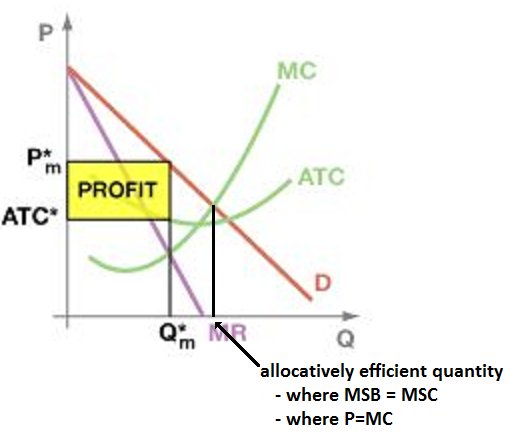
- on the graph above you can see
that the profit maximizing quantity (Q*m) is less than
the allocatively efficient quantity
- ME: the video lecture did not discuss how
monopolies are also productively inefficient, which means that
they do not produce the quantity that will minimize ATC (the don't
produce the quantity where MC=ATC). This is discussed in the
textbook.
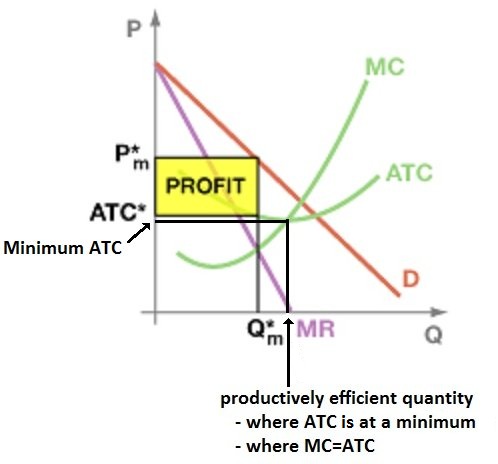
- on the graph above you can see
the the ATC at the profit maximizing quantity (ATC*)
is higher than the minimum ATC
6.2.2
(15:23) Calculating Deadweight Loss - 10b
- Outline
- Economic value in a competitive
market
- Economic value in a
monopoly
- Calculating the deadweight
loss
- Rent seeking
- Tomlinson assumes:
- constant marginal costs just to keep
things simple
- no externalities, therefore the MC
measures all of the marginal social costs (MSC); stated a
different way: private costs = social costs
- the demand curve shows the reservation
prices of consumers, that is, the highest prices that consumers
are willing to pay; which means the demand curve measures the
maximum benefits the consumers get from the product, or the
marginal social benefits (D=MSB) assuming no
externalities
- Economic value (efficiency) in a
competitive market
- what price and quantity will occur in a
competitive market?
- The video lecture will
ask you a multiple choice question. ANSWER THE QUESTION by
selecting A, B, or C and more of the lecture will
follow
- P=MC in a competitive market
- this is where the supply and demand
cross (remember the MC curve is the supply (horizontal in
this example)
- ME: the is also the allocatively
efficient quantity because P=MSB and MC = MSC, do MSB =
MSC
- no profit
- but a lot of consumer surplus;
consumers do not have to pay the maximum that they are
willing to so they are gaining satisfaction; Tomlinson
calculates the consumer surplus
- economic value equals the consumer
surplus plus the producer surplus (here there is no producer
surplus)
- Economic value in a monopoly
- what price and quantity will occur in a
monopolistic market?
- monopolies will try to maximize their
profits
- this will maximize the producer
surplus, BUT reduce the total economic value for
society
- assumes that this is a "one-price"
monopolist: i.e. there is no price discrimination (see
textbook)
- when maximizing profits the
monopolist will produce less than if the market were
competitive
- this then will reduce the economic
value for society since there will be less consumer surplus
because less is produced
- this loss of economic value (consumer
surplus in this example) is called dead weight
loss
- Monopolies will maximize their
profits by raising the price and reducing output ("restrict
trade) which will drive some customers out of the market and
society loses their consumer surplus
- ME: this represent allocative
inefficiency since at the profit maximizing quantity for the
monopolist, the P (or MSB) is greater then the MC or MSC
(P>MC or MSB>MSC; society wants more of the product
and the cost to society is low indicating that ether are
additional units when the benefits outweigh the costs that
society is not getting
- Rent Seeking
- this is another social cost of
monopolies (ME: another source of inefficiency)
- "rent seeking" refers to actions that
firms take to preserve their profits (ME: called "monopoly
preserving expenditures" in our textbook
- additional resources are used, NOT to
benefit society, but just to preserve the monopoly, this is a
loss to society
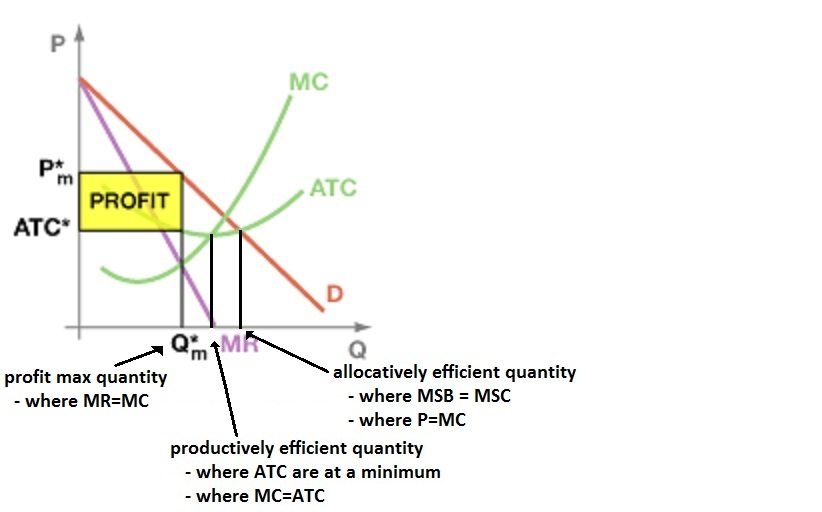
Price
Discrimination and its Effects on Efficiency in a Monopolistic Market
(econclassroom.com 14:51) - 10b
http://www.econclassroom.com/?p=3118
Outline:
- Define price discrimination
- Three conditions necessary for price
discrimination
- Three types (degrees) of price
discrimination
- The effect of perfect price discrimination
on efficiency (graph)
Definition: Price discrimination occurs when a
firm with market power charges different prices to consumers for an
identical product.
ME: Note that the word
"discrimination" does not mean that this is a bad thing. All
"discrimination" means is that different customers are treated
differently, i.e. they pay different prices. We will find out that
price discrimination may actually be GOOD for society.
Examples:
- Movie theaters: Charge different prices
based on age. Seniors and youth pay less since they tend to be
more price sensitive.
- Gas stations: Gas stations will charge
different prices in different neighborhoods based on relative
demand and location.
- Quantity discounts: Grocery stores give
discounts for bulk purchases by customers who are price
sensitive (think “buy one gallon of milk, get a second
gallon free”& the family of six is price sensitive
and is likely to pay less per gallon than the dual income
couple with no kids who would never buy two gallons of
milk).
- Hotel room rates: Some hotels will
charge less for customers who bother to ask about special room
rates than to those who don’t even bother to
ask.
- Telephone plans: Some customers who ask
their provider for special rates will find it incredibly easy
to get better calling rates than if they don’t bother to
ask.
- Airline ticket prices: Weekend stayover
discounts for leisure travelers mean business people, whose
demand for flights is highly inelastic, but who will rarely
stay over a weekend, pay far more for a round-trip ticket that
departs and returns during the week.
Three conditions necessary for price
discrimination to occur:
- firm must have market power (therefore
purely competitive firms cannot price discriminate, but monopolies
can
- firm must be able to segregate customers
with different willingnesses to pay which means with different
price elasticities of demand
- ME:
- those with a less elastic demand are
charged a higher price. So what happens to total revenue
(TR)? We know that if demand is inelastic and price goes up,
TR increase.
- those with elastic demand are charged
a lower price. So what happens to TR? We know that if demand
is elastic and price goes down, TR increase.
- Our textbook defines price
discrimination as "the selling of a product to different
buyers at different prices when the price differences are
not justified by differences in cost.
- so charging more for a car in
Alaska and less for one in Detroit because it costs more
to ship the car to Alaska is NOT price
discrimination
- But, since we assume that the costs
(TC) are the same, the result of price discrimination is
higher TR with the same TC, So, HIGHER PROFITS
- buyers are prevented from reselling the
product to someone else
Example: Airline tickets
ME: airlines have market power which
means that they can set their own price
ME: business travelers have a less elastic
demand curve than vacation travelers, but how can the airline know
if a ticket buyer is a business traveler or a vacation traveler?
One way is to require a Saturday night stay for customers buying
round-trip tickets. Business travelers prefer to be home on
weekends and vacation travelers tend to want to be on vacation
over the weekend
resale is prevented because your name is on
the ticket and you must have a matching ID
Three types (degrees) of price
discrimination
3rd Degree: where consumers are
divided into GROUPS. For example, age groups with different
price elasticities (movies tickets are cheaper for children and
more expensive for adults), or time of purchase (people who
buy early pay less than those who buy at the last moment).
2nd Degree: where price discrimination is
based on the quantity purchased. For example, buying in
bulk (large quantities) is cheaper than buying small
quantities or two-for one (or buy two get one free). the
more you buy the less you pay per unit
1st Degree: Also called "Perfect Price
Discrimination". This is where each individual consumer pays a
different price, each consumer pays the highest price that he or
she is willing to pay based on their demand. This way there will
be no consumer surplus but a lot of producer surplus.
The Effect of Perfect Price Discrimination on
Efficiency (graph showing 3rd degree price discrimination)
REVIEW: Graph of a "single-price"
monopolist maximizing profit. "Single-price" means that there is
no price discrimination
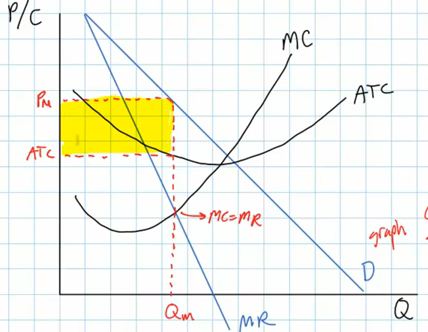
So, if this monopolist did not price
discriminate they would produce quantity Qm and charge price
Pm. (They will produce the quantity where MR=MC.) ME: and at
Qm, P > MC so the monopolist is not allocatively
efficient.
PRICE DISCRIMINATION: But notice that the
demand curve goes above Pm, meaning that there are customers
willing to pay more than Pm. What would happen if the
monopolist could charge these customers more since they are
willing to pay more? What happens is: if the monopolist can
charge each customer the highest price that they are willing to
pay, then MR will be the same as price (or demand). D =
MR or P = MR
So, what quantity will the perfectly
price discriminating monopolist produce to maximize profits?
This is always where MC=MR. Always.
On the graph, if P = MR then MR = MC
where P = MC. You should remember that this is the formula used
to find allocative efficiency (the socially optimal
quantity)
Results of perfect price
discrimination:
- more will be produced than a
single-price monopolist (Qp=MC on the graph
below)
- some consumers will pay higher prices
than they would if there was no price discrimination (Pm),
but other consumers will pay lower prices
- profits will be greater (the blue
plus the yellow areas on the graph below)
- AND MOST IMPORTANTLY the perfectly
price discriminating monopolist will produce the
allocatively efficient quantity!
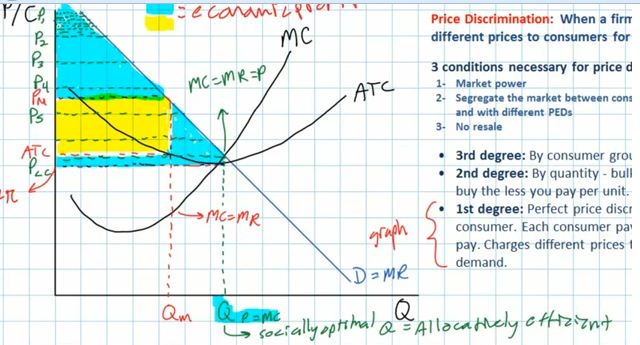
Conclusion:
- 1st degree price discrimination is
almost impossible and therefore very uncommon.
- 2nd and 3rd degree price
discrimination are more common
- but, 2nd and 3rd degree price
discrimination do not achieve the same increase in output as
perfect price discrimination and therefore do not achieve
the same level of allocative efficiency, but they are still
better than a single-price monopolist.
- effects:
- more is produced
- consumer surplus is transferred to
the producers in the form of higher revenues and
profits
- Is price discrimination good for
society? it depends:
- YES - it is better for the
monopolist because they get higher profits
- YES - it does improve
allocative efficiency
- NO - if you are one of the
customers who has to pay an even higher
price
- YES - if you are one of the
customers who gets the product at a lower price, and
if there were no price discrimination, you would not
get the product at all
REGULATING
NATURAL MONOPOLIES
Natural Monopoly and the need for Government
Regulation - 10b
http://www.econclassroom.com/?p=3115
What is a "Natural Monopoly"?
- Monopoly where the long run ATC curve has
economies of scale over a very large range of output
- You can identify the graph of a natural
monopoly because the demand (D) curve crosses the ATC curve when
the ATC is still downward sloping
- this means that one very large company can
produce every thing that is demanded AT AT LOWER AVERAGE COST than
if there were several competing firms
- Examples:
- providing water to homes in a
city
- electrical utilities
- natural gas
- If there were many companies each serving
only a few customers the ATC (costs per unit of output) would be
higher
- it would make more sense to have only one
company provide the product because then the costs per unit (ATC)
would be lower. That is why this is called a "natural"
monopoly.
- this is because there are very high fixed
costs (TFC). Think of all the costs of running water pipes to
every house in a city. These are all fixed costs. And since the
TFC are very very high, then the TC will be very high, and the
only way to get ATC to be low is to have a large amount of output
(Q)
- ATC = TC / Q
- if TC are very high because of very high
TFC then:
- ATC is high if: ATC = high TC / low
Q
- but, ATC would be low if : ATC = high
TC / large Q
Compare graphs:
- graph of a regular monopoly
- graph of a natural monopoly (EoS -
Economies of Scale)
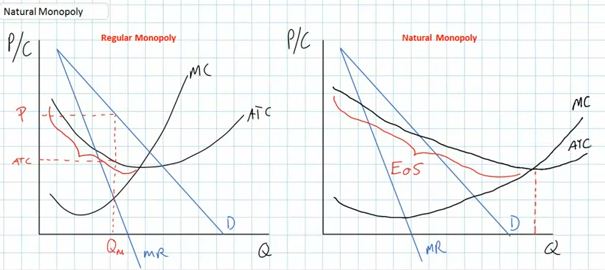
So, Society is better off (lower costs) if only
one firm produces the product, BUT:
- what will a profit maximizing monopolist do
is such a case?
- they would produce the profit maximizing
quantity, where MR = MC
- and this is NOT the allocatively efficient
quantity
- like other monopolists, a natural
monopolist will charge a higher price (Pm) and produce a lower
quantity (Qpm) than the socially optimum (alloc. eff.) price of
Pso and quantity of Qso
- Result: allocative inefficiency; an
underallocation of resources
- ME: so WHAT WE GET (Qpm) is less than
WHAT WE WANT (Qso)
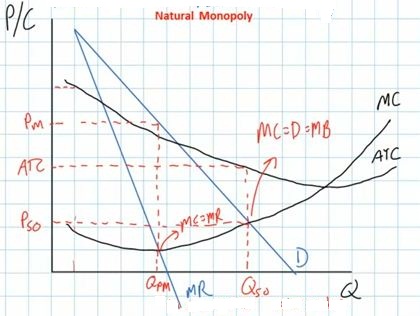
To really benefit society, natural monopolies
need to be regulated by the government
- This means that the government should use
price controls and subsidies to achieve allocative efficiency,
Qso
- But what price should the government
select?
- if the government puts on a price
ceiling at the allocatively efficient price of Pso
- the monopolist would then produce the
allocatively efficient quantity of Qso because the ceiling
price becomes the firm's MR and then MR = MC at Qso
- BUT, we can see that at Qso the ceiling
price is less than the ATC and the monopoly would be earning
losses equal to the blue rectangle on the graph
below
- in the long run, businesses cannot
operate at a loss and they will go out of business. This would
not be good for society.
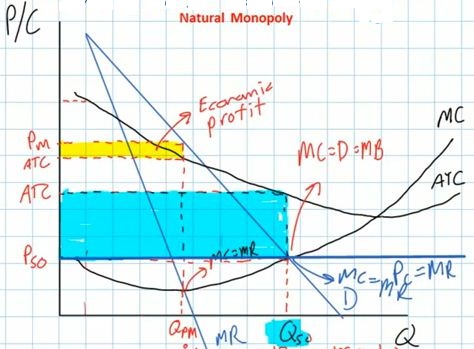
- What can the government do to prevent
natural monopolies from going out of business because to the price
ceiling?
- they can use BOTH a price ceiling AND a
subsidy to help the monopoly produce the socially optimum
quantity.
- ME: our textbook does NOT use the
subsidy graph shown in the video lecture (see below)
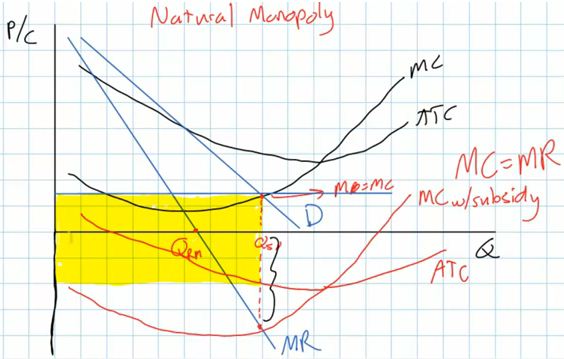
- ME: our textbook says that there are two
solutions to the problem of natural monopolies earning a loss
at the allocatively efficient price:
- provide a subsidy to cover their
losses
- but this may be politically
unpopular. Would you support higher taxes to give money
to Commonwealth Edison electric company?
- the other solution that is used a lot
in the united states is AC pricing, where the government
does not set a price ceiling at the allocatively efficient
price (Pso), but rather they put the price ceiling at a
prise where D=ATC (where the demand curve crosses the ATC
curve).
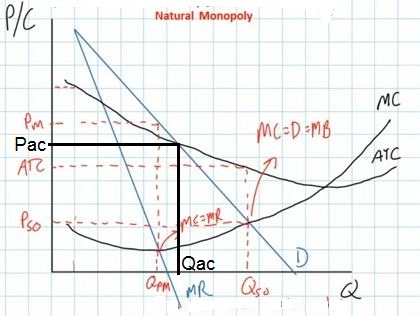
- If the price is Pac then the firm
will produce Qac
- is the allocative efficient? NO,
but it is closer to Qso
- will the firms earn profits or
losses? They will earn normal profits (profits = zero)
and they will be able to stay in business. (Remember:
economic costs include the explicit costs AND the
implicit cost which means that investors are earning a
return on their investment approximately equal to their
next best alternative.)
Monopolistic Competition and
Oligopoly (LESSONS 11a and 11b)
LESSON 11a - MONOPOLISTIC
COMPETITION
6.4.1
(7:01) Defining Monopolistic Competition - 11a
- Outline
- A Review of Two Market
Types
- Definition of Monopolistic
Competition
- Product
Differentiation
- How to Create Market
Power
- A Review of Two Market Types
- Monopoly: because of barriers to entry
they have market power [MR=MC] and can earn long run
economic profits, but they create less economic value for
society (ME: allocatively [P>MC] and productively
[not minimum ATC] inefficient in the long
run)
- Perfect Competition: because there are
no barriers to entry they earn zero economic profits int the
long run (ME: called a normal profit), but they maximize
economic value for society (ME: they are allocatively
[P=MC] and productively [P=MC=ATC] efficient in
the long run)
- Definition of Monopolistic
Competition
- Simple Definition: a market in which
firms can enter freely and obtain market power by
differentiating their product
- Some market power but no (or few)
barriers to entry
- firms compete to create little
monopolies
- firms have to convince their customers
that their product is distinct; this gives the firm a downward
sloping demand curve and some market power
- a hybrid of monopoly and
competition
- from monopoly: MR=MC ; the result of
market power because of product differentiation
- from competition: P=ATC in the long
run; i.e. firms earn zero economic profits in the long run
because there are no barriers to entry
- explains how variety arises in a
market
- Product Differentiation
- two different hamburgers look similar
BUT: companies advertise to convince customers that their
hamburger is different
- Pepsi vs. Coke, they are very similar
BUT: companies advertise to convince customers that their soft
drink is different
- How to Create Market Power
- why do firms spend so much money on
product differentiation, i.e. on trying to convince customers
that their product is distinct or different?
- because this creates market power; the
ability to increase a product's price without losing all of its
customers; creates little monopolies
- How:
- advertising
- actual differences in the product
itself
- Result:
- a little more inefficiency than in
perfect competition which reduces society's
satisfaction
- but more variety which increases
society's satisfaction
6.4.2
(8:58) Short-Run Profit Maximization for a Monopolistically
Competitive Firm - Understanding Pricing and Output in Monopolistic
Competition - 11a
- Outline
- The graph of a single
firm
- Free entry into the
market
- A shift in the demand
curve
- Equilibrium in monopolistic
competition
- The pros and cons of monopolistic
competition
- The graph of a single firm
- downward sloping demand curve because of
product differentiation
- product differentiation gives the
firm a kind of monopoly
- because demand is downward sloping the
marginal revenue (MR) curve is below the price
- add the cost curves
- to find the Q and P, this profit
maximizing firm will produce the Q where MR=MC and the price is
found on the demand curve above. Know how to do
this!
- know how to find profits or
losses
- Free entry into the market (a long run
change)
- there is only room in the market to
support a certain number of producers
- but since there are no barriers to entry
if existing firms are earning economic profits then new
firms will enter the industry AND WHAT WILL HAPPEN
THEN?
- A shift in the demand curve
- the demand for the existing firms will
decrease (shifts to the lift) also decreasing the MR
- result: quantity, price, and profits
for firms in the industry will decrease
- as long as firms are earning economic
profits more firms can enter and again causing Q, P and profits
to decrease.
- where is the new equilibrium? when will
it stop? when will new firms stop entering the
industry?
- Equilibrium in monopolistic
competition
- Answer: when firms are l]no longer
earning profits; when economic profits are zero (or normal
profits PAUSE the video and look at the new graph
carefully
- P = ATC and profits = 0 (breaking
even) like in pure competition
- the demand curve is tangent to the
ATC curve
- and no new firms will enter, this is
an equilibrium
- The pros and cons of monopolistic
competition in the long run
- Is the new long run equilibrium good or
bad for society?
- Pros: a lot of variety, product
differentiation, which will give society some
satisfaction
- Cons:
- not producing at the point of minimum
ATC (not achieving productive efficiency); costs are higher
wasting some resources
- also we are not producing where P=MC
(not allocatively efficient); there is a dead weight loss;
less is produced; there are still some quantities where the
MPB (or P) is greater then the MSC (or MC) representing lost
satisfaction for society
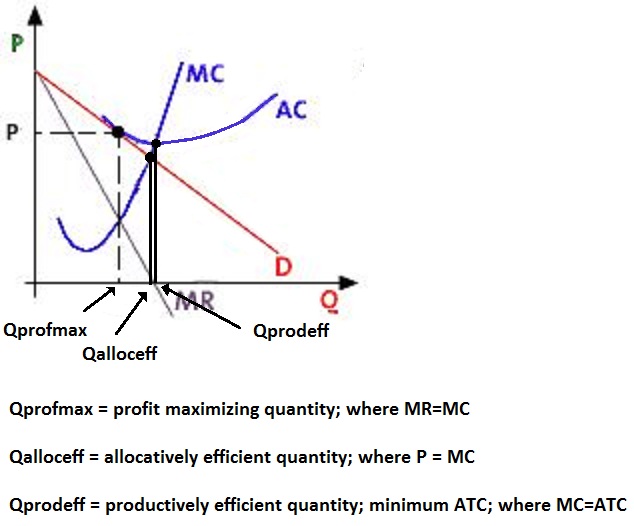
Monopolistic
Competition (econclassroom.com 20:51) - 11a
http://www.econclassroom.com/?p=3128
(efficiency begins at 15:00)
beginning at
15:00
- Are monopolistically competitive firms
efficient?
- Graph of a monopolistically competitive
firm in long run equilibrium
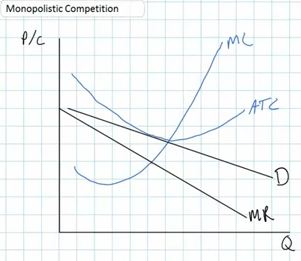
- firms earn a normal (zero) profit
because of few barriers to entry (P=ATC means zero
profit)
- therefore there is no incentive for
other firms to enter
- Are they efficient? NO. Neither
allocative or productive efficiency will be achieved by
monopolistically competitive firms in the long run.
- Productive efficiency is NOT being
achieved
- the profit maximizing quantity (Q)
is not at the lowest point on the ATC curve. The lowest
point is where MC-ATC (Qpe on the graph
below)
- so to maximize profits,
monopolistically competitive firms will restrict output
and charge a slightly higher price than the minimum
ATC
- Allocative efficiency is NOT being
achieved
- We know that allocative efficiency
occurs where MB=MC (or MSB=MSC). On the graph MSB is
measured by the demand (or price) curve and the MSC is
measured by the MC curve. So, allocative efficiency
occurs at the quantity where P=MC.
- At the profit maximizing quantity
we d]can see that P>MC or MSB>MSC, so the firm
is NOT allocatively efficient.
- There will be an underallocation
of resources (too little will be produced). The quantity
where P=MC (Qso) is greater than the profit maximizing
level of output (Q).
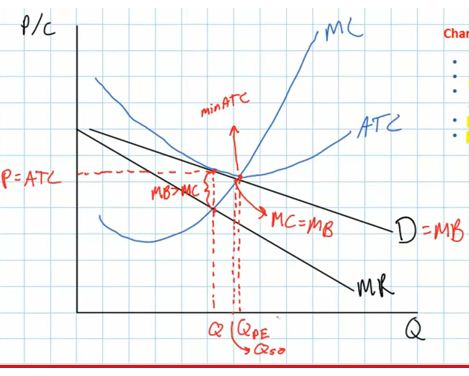
- We will always get productive and
allocative inefficiency when the demand curve is
downward sloping so the MR is less than the price
(demand)
- Only in pure competition do we get
productive and allocative efficiency
Monopolistic
Competition in the Long-Run: Econ Concepts in 60 Seconds with AP
Economics Teacher (ACDCEcon 3:26) - 11a
http://www.youtube.com/watch?v=erdzOu3juNI
- How to draw a monopolistically competitive
firm's long run equilibrium graph
- downward sloping demand
- MR is below the Demand
- MC goes down at first ant then
up
- IMPORTANT: NOW you must find the profit
maximizing price and quantity before you draw the ATC
curve
- find the quantity where
MR=MC
- then drive up to the demand curve and
over to get the price
- we need to know the price before we
draw the ATC curve
- then draw the ATC curve tangent to the
demand curve (just touching but not crossing) at the the profit
maximizing price (sweet spot).
- Now find the socially optimal quantity (the
allocatively efficient quantity)
- the alloc. eff. quantity occurs where P
= MC. (On the video he says this is "where supply equals
demand" and he shows that MC=S. This is the same as P=MC
[or MC=P])
- result. the profit maximizing quantity,
Q, (WHAT WE GET) is less than the allocatively efficient
quantity, Qso (WHAT WE WANT).
- there is a deadweight loss
- Now find the productively efficient
quantity
- this is at the minimum point of the ATC,
or where MC=ATC
- notice that the profit maximizing
quantity is less than the quantity where ATC is at a minimum,
so monopolistically competitive firms are not productively
efficient. They do not produce at the lowest ATC
- The difference between these two
quantities is called "excess capacity" meaning the firm could
produce more at a lower cost but they hold back production to
increase their profits
- Classic mistake when drawing the graph of
monopolistic competition in long run equilibrium:
- the classic mistake is drawing the ATC
tangent to where demand hits the MC curve
LESSON
11b - OLIGOPOLY and SUMMARY OF PRODUCT MARKET MODELS
6.3.1
(17:26) Introducing Oligopoly and the Prisoner's Dilemma -
11b
- Outline
- Oligopoly Defined
- Game Theory: The Prisoner's
Dilemma
- Nash equilibrium
- Definition of Dominant
Strategy
- Conclusion
- Oligopoly Defined
- SLIGHT ERROR: Tomlinson mentions that a
monopolistically competitive industry has "a small number of
sellers" each with some market power; he meant to say "a LARGE
number of sellers".
- Oligopoly
- small number of sellers
- that have to consider the reactions
of their competitors;
- they interact
strategically
- ME: our textbook uses the term
"mutual interdependence";
- where each firm tries to guess
what its competitor's are going to do,
- because the choices of all the
firms affects each individual firm
- there is no generally agreed upon
single model of oligopoly: there are several models each
with strengths and weaknesses
- Game Theory: The Prisoner's
Dilemma
- economists tend to agree that Game
Theory best describes strategic behavior between a small number
of firms
- the Prisoner's Dilemma is one of the
most basic forms of game theory and it applies quite will to
the strategic behavior of a small number of firms (i.e.
oligopoly) when they are making their pricing
decisions
- Bonnie and Clyde: confess or not
confess?
- called a "game" because the outcome
depends not just on what you do, but what your competitor
does; also called strategic interaction
- draw a matrix (table) with two
players representing the possible outcomes in each box;
prisoners cannot talk to each other and they don't know what
the other will choose
- each can either confess or not
confess
- if both confess they will get 10
years in prison each
- if neither confess then they will
get only 1 year in jail on a lesser charge
- if Bonnie confesses and Clyde
doesn't, then Bonnie is free (no jail time) and Clyde
will get 11 years in prison
- if Clyde confesses and Bonnie
doesn't, then Clyde is free (no jail time) and Bonnie
will get 11 years in prison
- Matrix of strategies available to
each player:
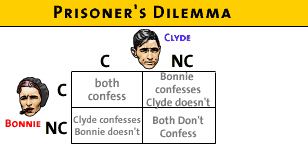
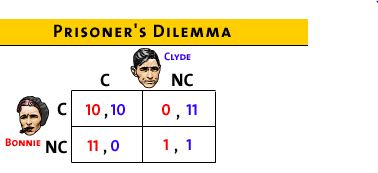
- Nash equilibrium
- What is the solution?
- Nash Equilibrium:
- the outcome when each player is doing
the best they can given what all other players are
doing
- If Clyde confesses what is the best
response for bonnie?
- The video lecture
will ask you a multiple choice question. ANSWER THE
QUESTION by selecting A, B, or C and more of the lecture
will follow
- If Clyde does not confess which is
the best response for Bonnie
- The video lecture
will ask you a multiple choice question. ANSWER THE
QUESTION by selecting A, B, or C and more of the lecture
will follow
- Definition of Dominant
Strategy
- In both cases, Bonnie will
minimize jail time by confessing; this is Bonnie's
"dominant strategy"
- Dominant Strategy: a choice for a
player that maximizes her satisfaction no matter what her
rivals are doing
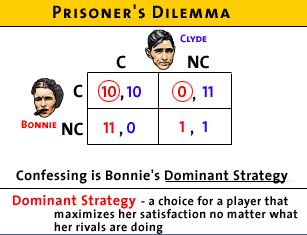
- What should Clyde do?
- The video lecture
will ask you a multiple choice question. ANSWER THE
QUESTION by selecting A, B, or C and more of the lecture
will follow
- Clyde will also have a dominant
strategy of confessing no matter what Bonnie
does
- So they will BOTH confess = Nash
equilibrium
- Nash equilibrium occurs when they
both give their dominant response
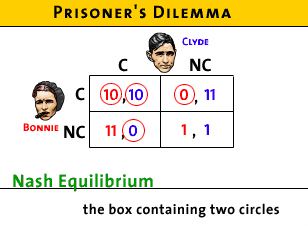
- it is also a "self-enforcing
agreement": when they are each giving their best
decision, neither can improve their situation by changing
their minds
- so they will not change their
minds; it is an equilibrium
- BUT is this equilibrium the BEST for
Bonnie and Clyde?
- The video lecture
will ask you a multiple choice question. ANSWER THE
QUESTION by selecting A, B, or C and more of the lecture
will follow
- It would be best if they would
both NOT CONFESS,then they each get only 1 year in prison
rather than 10 years
- but it is not a Nash
equilibrium because they can each do better if they
confess.
- they can do better because if
one confesses and the other does not then he or she
will get no jail time (0 years)
- so they will confess = Nash
equilibrium
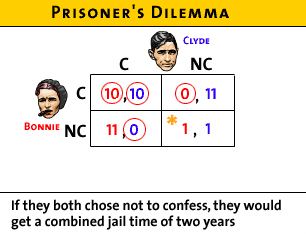
- The BEST outcome for both is
not an equilibrium outcome
- How does this apply to economics and
business?
- businesses try to form trusting
relationships so in a situation like this one, no one will
be tempted to cheat
- if Bonnie and Clyde play often enough
they may learn to trust one another and both choose not to
confess; they can enforce cooperation through
trust
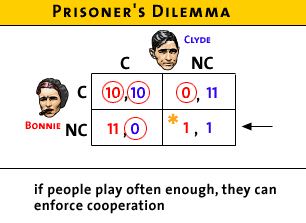
- but if they only play once, the
RATIONAL OUTCOME is for both to confess
- this is rational even if it isn't
the best outcome
- Maybe they can enforce cooperation
other ways:
- like through third party
enforcement of contracts
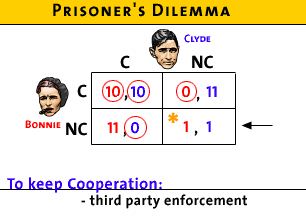
- but more likely, if people play often
enough they can form reputations that they will not cheat;
i.e. trust
- Conclusion
- the best outcome may not be individually
rational
- it would be better for an individual
business to pollute (cheaper and therefore larger profits),
but it would not best if all businesses polluted
- how to avoid a Nash equilibrium and end
up with the best outcome instead?
- repeated play
- reputation
- contracts
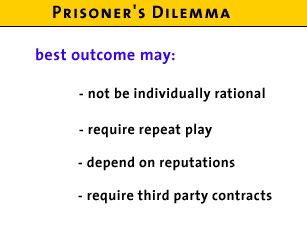
- NOTE: Tomlinson discusses the next
lesson when the prisoners 'dilemma is applied to an oligopoly, I
think he is referring to:
- 10.4-1 Game Theory and Advertising
and Brand Names - Understanding Monopolistic Competition as a
Prisoner's Dilemma AND this should be titled "Understanding
Oligopoly as a Prisoner's Dilemma"
6.4.3
(6:44) Game Theory and Advertising and Brand Names - Understanding
Oligopoly (Monopolistic Competition??) as a Prisoner's Dilemma -
11b
6.3.1 (17:26)
should be watched
before watching this video
- Outline
- How to use game
theory
- Dominant strategy
- Prisoner's Dilemma: Best outcomes vs.
Actual outcomes
- How to use game theory to understand
advertising: Coke and Pepsi
- Assumptions:
- two rivals: Coke and Pepsi competing
for a share of the $10 million soft drink market
- if no advertising they each have $5
million in sales
- advertising would cost them $3
million
- if you advertise and your rival does
not then you get all customers = $10 million in
sales
- if you advertise AND your rival also
advertises then you each get $5 million in sales - the same
as if neither advertise
- Here is the game matrix:
- Coke's Dominant strategy
- The video lecture
will ask you a multiple choice question. ANSWER THE QUESTION
by selecting A, B, or C and more of the lecture will
follow
- if Pepsi advertises
what ts the best strategy for COKE?
- if Coke does not
advertise it will get $0 in sales
- if coke does
advertise it will get $2 million in revenue
- BEST for Coke
to advertise
- If Pepsi does NOT
advertise, what is the best strategy for COKE?
- if Coke does not
advertise it will get $5 in sales
- if Coke does
advertise it will get $7 million in revenue
- BEST for Coke
to advertise
- So, Coke has a
dominant strategy to advertise
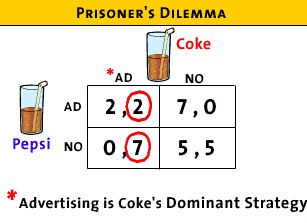
- Pepsi's Dominant strategy
- if Coke advertises
what ts the best strategy for PEPSI?
- if Pepsi does not
advertise it will get $0 in sales
- if Pepsi does
advertise it will get $2 million in revenue
- BEST for Coke
to advertise
- If Coke does NOT
advertise, what is the best strategy for PEPSI?
- if Pepsi does not
advertise it will get $5 in sales
- if Pepsi does
advertise it will get $7 million in revenue
- BEST for
Pepsi to advertise
- So, Pepsi's has a
dominant strategy to advertise
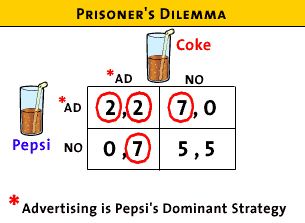
- Best outcomes vs. Actual outcomes
- Best outcome:
- for both Coke and Pepsi is for
neither one to advertise and then they each get $5 million
revenue
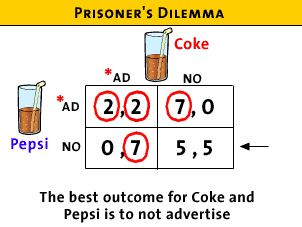
- but this is NOT a self enforcing
agreement because they both will realize that they can now
gain by advertising,
- if they agree together that they
will not advertise to achieve their best outcome ($5
million each)
- one can gain if they advertise
(i.e. cheat) if the other one doesn't
- so it makes sense ("individually
rational") to cheat and launch an ad campaign
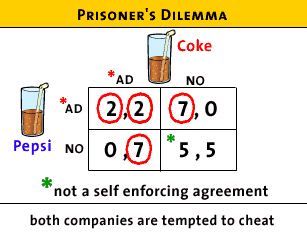
- But the actual outcome (Nash
equilibrium) is that they will both advertise and get only $2
in revenue
- because the best outcome (5,5) is not
a self enforcing agreement
- but if they both advertise, this is a
self enforcing agreement; i.e. they are BOTH giving their
best response to their rival
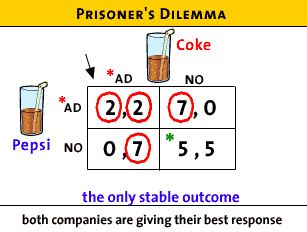
- How to get the best (5,5) outcome:
- they might learn through repeated play
that if they both do not advertise that they will both come out
ahead
- or if they can get the government to
outlaw soft drink advertising (they would like and support such
a law)
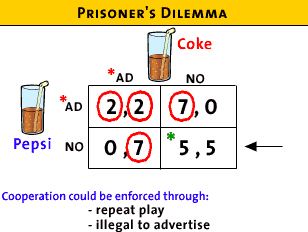
- Prisoner's Dilemma:
- advertising is like the arm's race
(nuclear weapons)
- it would be best if no one advertises
(or had nuclear weapons)
- but, because of the possibility of your
rival doing it, you have to keep up
- in the end everyone's profits are
reduced (2,2)
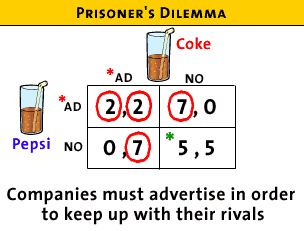
6.3.2 (10:47) Understanding
a Cartel as a Prisoner's Dilemma - 11b
- Outline
- Definition of a
Cartel
- Prisoner's Dilemma
- Best Outcome
- Definition of a Cartel
- an oligopoly where the individual
members try to act as a monopolist
- ME: (from the textbook) a group of
producers that typically creates a formal written agreement
specifying how much each member will produce and charge. Output
must be controlled—the market must be divided up—in
order to maintain the agreed-upon price. The collusion is
overt, or open to view.
- they get together and act as one,
setting the price and quantity together, choosing the profit
maximizing monopoly quantity and price and earning monopoly
profits that they divide among themselves; i.e. they act as a
monopoly
- ME: usually this is done by all member
restricting quantity and raising the price
- Problem: keeping the cartel together is
a problem because of the prisoner's dilemma
- .if one firm knows that all the
others are restricting the quantity which makes the price
higher, this firm can CHEAT and produce more and make
greater profits for itself; i.e. they have an incentive to
cheat
- but if all firms or countries) cheat
by producing more, the price will drop and they will all
earn lower profits than if no one cheated
- Prisoner's Dilemma: The Cartel as a case of
the Prisoner's Dilemma
- two countries form an oil cartel,
Nigeria and Venezuela
- they each have two options: cooperate or
cheat
- if they both cooperate they earn
maximum profits that are shared ($10 million total or $5
each)
- if both cheat and increase their
output then the price will fall an total profits will fall
(to $8 million) and they will each earn only $4.
- if one cheats and produces more but
the other does not an still produces less, the cheater more
profits ($6) ,but the other makes less profits ($3) and
total profits will be less ($6 + $3 = $9) because the price
will be lower; i.e. they are not earning the highest,
monopoly, profit.
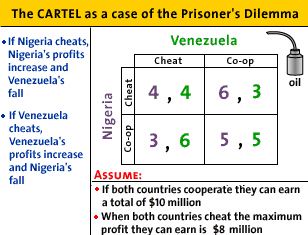
- What are Dominant Strategies?
- For Venezuela:
- if Nigeria cheats, then
Venezuela's best response is to cheat also and profits
are 4,4.
- if Nigeria cooperates then
Venezuela's best response is to cheat and profits are 3
for Nigeria and 6 for Venezuela
- So, Venezuela has an incentive to
cheat no matter what Nigeria does
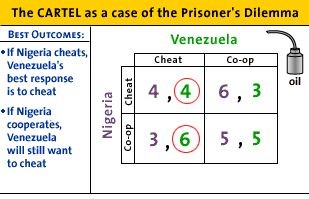
- For Nigeria:
- if Venezuela cheats, then
Nigeria's best response is to cheat also and profits are
4,4.
- if Venezuela cooperates then
Nigeria's best response is to cheat and profits are 3 for
Venezuela and 6 for Venezuela
- So, Nigeria has an incentive to
cheat no matter what Venezuela does
- Nash Equilibrium
- since both countries have a dominant
strategy to cheat the Nash equilibrium is for both top cheat
and the cartel falls apart
- profits are $4 million
each
- total profits are at the lowest of
all possible options
- ME: but this is the best outcome for
consumers!
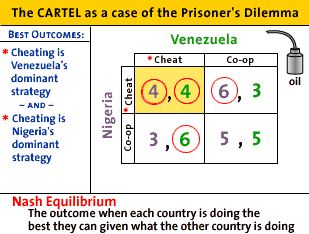
- Best Outcome
- the best outcome for the oil producing
countries is to collude (form the cartel) reduce output, and
raise the price acting like a monopolist
- this way each country would earn profits
of $5 million (5,5)
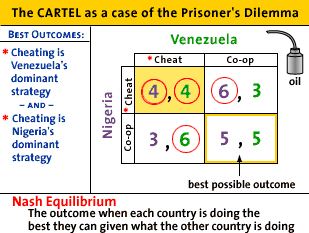
- but this is not a self enforcing
agreement because they each have an incentive to cheat and try
to improve their profits
- so this is not a Nash equilibrium (i.e.
not a stable outcome)
- So, what does this mean about cartels? Are
they possible?
Yes, if they
learn through repeated play that cheating hurts them both and that
cooperating is better for them.
6.3.3 (4:22) Understanding
the Kinked-Demand Curve Model
- Outline
- the kinked demand
curve
- the discontinuous MR
curve
- finding the profit maximizing
quantity
- problems with the kinked demand
model
- ME: mutual interdependence
- assume:
- that rivals ignore if one firm raises
its price
- but rivals will match the price change
if one firms decides to lower its price
- result: the demand curve will be
kinked
- it will be more elastic (flatter) above
the original price because if one firm lowers its price AND all
of its competitors do not, then the firm will lose A LOT of
customers
- the demand will be less elastic
(steeper) below the original price because if one firm decides
to lower its price all of its competitors will ALSO lower their
prices and each would get only A FEW new customers
- what will the MR curve look like?
- as always (except pure competition) the
MR will be below the demand curve (D)
- it will be discontinuous
- how to find the profit maximizing
quantity
- as always, we find the profit maximizing
level of output at the quantity where MR = MC
- It is quite likely that the MC curve
will cross the MR curve in the vertical gap
- if so, then the profit max quantity is
found on the horizontal axis directly below the gap and the
price is found off of the demand curve above
- the price would then be at the kink in
the demand curve
- Problems
- one problem with the model is that it
does not tell us how the kink in the demand curve got where it
is in the first place
- also there are not many good real world
examples
- But, logically it does make
sense.
Kinked
Demand Model (econclassroom.com 14:06) - 11b
http://www.econclassroom.com/?p=3144
Preview:
- In this lesson we take a graphical approach
to oligopoly, and seek to explain why prices tend not to
fluctuate up or down in oligopolistic markets.
- Why do some oligopolies have very little
incentive to decrease their prices, and also a strong incentive
not to raise their prices?
- What emerges is a kinked demand curve,
highly elastic at prices above the current equilibrium and highly
inelastic at prices below the current equilibrium. Along with this
kinked demand curve comes a kinked marginal revenue curve, with a
vertical section. The implication is that even as an oligopolist's
costs rise and fall in the short-run, its level of output and
price tends to remain stable.
Review -
Oligopolies:
- few firms
- mutual interdependence
- Mutual interdependence exists when firms
consider their rivals' reactions while adjusting prices and
outputs.
Assumptions
about oligopoly pricing behavior (kinked demand model)
- before changing its price an oligopolist
will try to predict what its competitors will do if they do change
their price
- ASSUME: competitors will match price
decreases - if one firm lowers its price the competitors will
lower their prices
- This make sense because the competitors
will not want to lose a lot of customers to a competitor that
lowers it price, so they will decrease their price
too.
- therefore, the demand curve is
inelastic, if all firms lower their prices they will not
gain very many customers, i.e. the % change is quantity
demanded will be small = inelastic
- ASSUME: competitors ignore price
increases - if one firm raises its price the competitors will
not raise their prices
- This makes sense because competitors
could gain a lot of customers if they kept their prices low
when one firm raises theirs
- therefore, the demand curve will be
elastic, if one firm raises its price and the other firms do
not, the one firm will lose a lot of customers, i. e. the %
change in quantity demanded will be large = elastic
So what does
the demand curve look like with these assumption?
- demand below the going price will be
inelastic (steeper); a small increase in quantity if the price is
decreased
- demand above the going price will be
elastic (flatter); a large decrease in quantity if the price is
increased
- so the demand curve will be "kinked", or
bent.
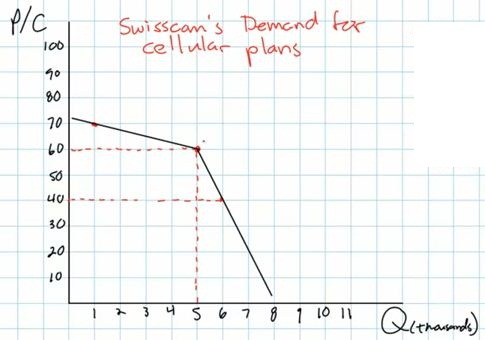
So why are
firms reluctant to change their prices?
- since demand is inelastic below the going
price, if a firms lowers its price (and its competitors do not)
then its total revenues will decrease; a big drop in price but a
little increase in quantity causes TR to decline
- since demand is elastic above the going
price, if a firm raises its price (and all its competitors raise
their prices too) then its total revenues will decrease; a little
increase in price but a large decrease in quantity causes TR to
decline
- Therefore, prices in an oligopolistic
market are "sticky"; i.e. they tend not to change because if a
firms raises, or lowers its price, its total revenues will
fall
So what does
the MR curve look like?
- We know that when the demand curve is
downward sloping, the MR curve is below it
- the MR diminishes at twice the rate that
demand does therefore, we end up with two MR curves, one somewhat
flat under the elastic portion of the kinked demand curve and one
more steep under the inelastic portion of the demand curve, and a
vertical portion of the MR curve connecting the two
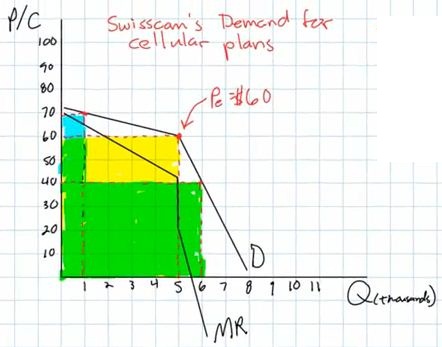
So what will
oligopolists do if their costs change? Will they change their prices
and quantities?
- maybe not
- in other markets
- if variable costs rise, the MC will rise
and the profit maximizing level of output (where MR=MC) will
decrease, and
- if variable costs fall, the MC will fall
and the profit maximizing level of output (where MR=MC) will
increase
- but in the kinked demand model, if the MC
crosses MR in the vertical section, a change in costs will not
change the profit maximizing level of output or the profit
maximizing price. the price and quantity where MR = MC will stay
the same even if MC rises or falls
ME:
- Most economic textbook and online video
lectures do not include the ATC curve in their kinked demand
model. I am not sure why. And they often include 2 MC curves to
show that changes in costs do not change the profit maximizing
quantity or price.
- here is a graph of the oligopoly kinked
demand model with the ATC curve and only one MC:
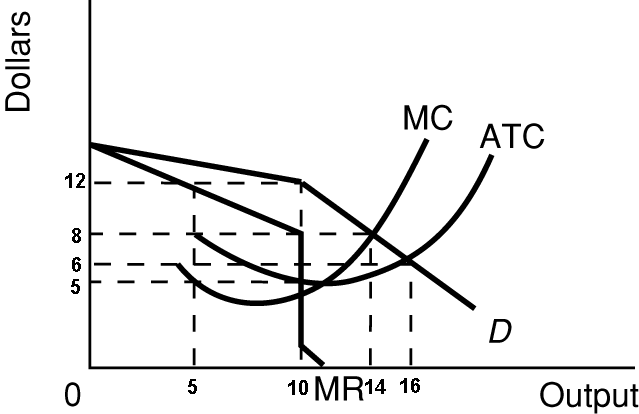
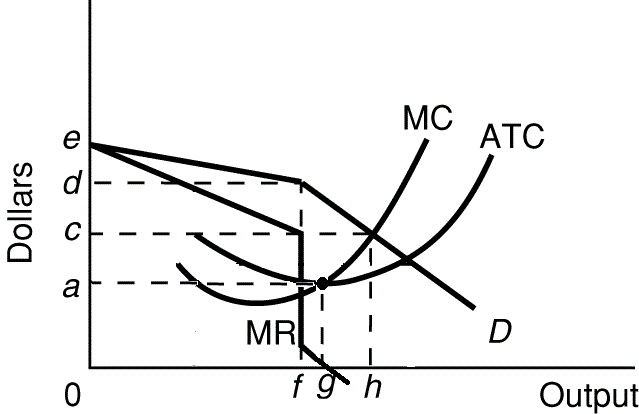
- Profit maximizing quantity and price:
Q = f; P = d
- Allocatively efficient quantity and
price: Q = h; P = c
- Productively efficient quantity and
price: Q = g; P = a
Oligopolies,
Duopolies, Collusion, and Cartels (Khan Academy 8:26) -
11b
http://www.khanacademy.org/finance-economics/microeconomics/v/oligopolies--duopolies--collusion--and-cartels
Introduction
- oligopoly
- "oli" means "few"
- "polies" means "sellers"
- sometimes oligopolies act more like
monopolies and sometimes they act more like competitive
markets
Collusion
(acting more like a monopoly)
- if they coordinate their pricing and
production decisions they are acting more like a
monopoly
- this is called collusion
- this is often illegal
- if they do it formally (like written
agreements) then we call it a cartel
- example of a cartel: OPEC (the Organization
of Petroleum Exporting Countries)
- 12 countries
- control 79% of the world's oil reserve
(2012)
- and 44% of the world's oil production
(2012)
- attempt to act like a monopoly
- one problem with collusion is that
individual firms (or countries as in OPEC) have an incentive to
CHEAT: i.e. they might be able to make more money if the say that
they are going to charge a high price like the rest of the firms,
but then they lower their price a take customers away from all the
other firms
Oligopolies
that are More Competitive
- Example: Coca-Cola vs.Pepsi
- Coke and Pepsi compete on price and on
marketing
- a duopoly is an oligopoly with only
two major firms
- examples of oligopolies that compete (act
more like pure competition):
- Coca-Cola and Pepsi
(duopoly)
- Boeing and Airbus (large passenger jet
manufacturers - duopoly)
- Airlines
- most cities have only a few
airlines
- their products are very similar
(standardized?)
- credit card (Visa, Mastercard,
Discover American Express)
- governments try to assure that oligopolies
compete rather than collude because collusion is inefficient (like
monopolies) and when they compete they are more efficient (more
like pure competition) with a larger consumer plus producer
surplus (total surplus).
SUMMARY
Determining
the Efficiency of Firms in Different Market Structures
(econclassroom.com 18:23) - 11b
http://www.econclassroom.com/?p=4456
Introduction
- two types of efficiency
- productive efficiency
- producing at the level of output
where its ATC is minimized
- is the price equal to the minimum
ATC
- ME: quantity where MC=ATC
- allocative efficiency
- producing at the level of output
where the MB = MC
- achieved where P=MC (or
D=MC)
- the demand curve represents the MB
that consumers receive from the consumption of a
good
- also called the socially optimal
quantity
-
Perfect
Competition Long Run Equilibrium
- very many firms producing standardized
(identical) products with no barriers to entry
- demand perfectly elastic (firm is a price
taker) since there are very many firms producing identical
products and no individual firm has any market power
- D=P=MR
- equilibrium price is established in the
market (supply and demand in the market)
- zero (normal) economic profits in long run
equilibrium because of no barriers to entry so ATC touches demand
at the lowest point of the ATC curve
- quantity produced is where MR=MC
(Qpc)
- productive efficiency is
achieved
- equilibrium quantity (Qpc) is where ATC
is at a minimum (P=minimum ATC)
- produce the quantity where
MC=ATC
- if they produce at any other quantity
then the ATC will be greater than the price and they will earn
economic losses and will go out of business in the long
run
- allocatively efficiency is
achieved
- at the profit maximizing quantity (Qpc)
the P=MC
- MSB=MSC
- this is the socially optimal
quantity
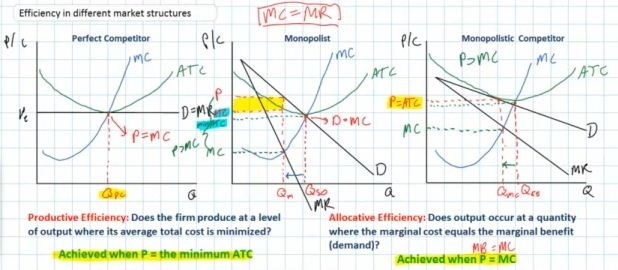
Monopoly
Long Run Equilibrium
- single firm in the industry since entry is
blocked
- producing a unique product
- downward sloping demand since the
monopolist has market power since it produces a unique product
that no other firms produce and the demand (or P) is greater then
the MR
- D=P>MR
- long run profits likely shown on graph as
the ACT is below the demand (P) curve because entry is blocked
(yellow rectangle)
- quantity produced is where MR=MC
(Qm)
- productive efficiency is NOT
achieved
- equilibrium quantity (Qm) is NOT where
ATC is at a minimum (P>minimum ATC)
- they do NOT produce the quantity where
MC=ATC
- at the profit maximizing level of output
(Qm) the actual ATC is higher than the minimum ATC
- since there is no competition the firm
does not need to produce in the least cost manner; without
competition the firm can charge a much higher price and produce
at a higher ATC and earn greater profits
- allocative efficiency is NOT
achieved
- equilibrium quantity (Qm) is NOT at the
quantity where P=MC (Qso)
- at the profit maximizing level of output
(Qm), P>MC
- meaning that there is an underallocation
of resources; too little is being produced
- monopolists can restrict output to
increase the price and earn greater profits
- at the socially optimal (alloc. eff.)
quantity (Qso), profits are not maximized so the monopolist
will not produce this quantity

Monopolistic
Competition Long Run Equilibrium
- many firms in the industry producing
similar products
- some market power (price making power)
because of product differentiation
- downward sloping demand for the individual
firms but more elastic since there are many substitutes and the
demand (or P) is greater then the MR
- D=P>MR
- zero (normal) economic profits in long run
equilibrium because of few barriers to entry so ATC is tangent to
the demand curve
- quantity produced is where MR=MC
(Qmc)
- productive efficiency is NOT
achieved
- equilibrium quantity (Qmc) is NOT where
ATC is at a minimum (P>minimum ATC)
- they do NOT produce the quantity where
MC=,ATC
- at the profit maximizing level of output
ATC is higher than the minimum
- allocative efficiency is NOT
achieved
- equilibrium quantity (Qmc) is NOT at the
quantity where P=MC
- at the profit maximizing level of output
(Qmc), P>MC
- meaning that there is an underallocation
of resources; too little is being produced
- as long as firms have some market power
(i.e. the demand is downward sloping) they will maximize
profits by producing a quantity that is less than the socially
optimal quantity (Qso)

Summary
- imperfect competition (monopoly,
monopolistic competition, and oligopoly) is a form of market
failure; the market fails to achieve efficiency as we saw in this
lesson
- ME: we studied market failure when we
studied externalities in clessons 5a and 5b; when externalities
exists markets fail to achieve efficiency
- ME: in lesson 2a where we studied the
economic functions of government, one of the functions was to try
to maintain competition ;i.e. to correct markets when they fail to
achieve efficiency; we also studied this in lesson 10b when we
discussed antitrust laws and monopoly regulation
- since most industries are imperfectly
competitive, does this mean that the most markets are market
failures?
- if we just look at the graphs we would
have to answer "yes", "technically speaking"
- but there are also some benefits to
imperfectly competitive markets that also have to be
considered:
- the great degree of product
differentiation provides society with a lot of benefits that
may make up for some of the underallocation of resources
(customer service, innovation, product development); variety
is good
LESSON 12a - THE DEMAND FOR
RESOURCES
7.1.1 (15:10) Deriving the
Factor Demand Curve - 12a
- Outline:
- A firm's demand for a resource like
labor is a derived demand. It is derived from the demand for
the product that the resource produces
- The profit maximizing rule says that
a firm hires labor up to the point at which MRP = MRC (or MRP =
W in competitive labor markets)
- to maximize profits, a firm will keep
hiring workers until the last worker adds just enough revenue to
the firm to cover the cost of that worker
- the demand for labor (by businesses) is a
derived demand, that means it resutls from the demand for
the products that the labor produces
- MRP = change in TR / change in quantity
of labor
- MRP = the extra revenue that the firm
gets when it hires one more worker
- MRP = the MB to the firm of hiring
another worker
- MRP = MR x MP
- MR = extra output of produding one
more unit of output
- MP = extra output from hirirng one
more worker
- for purely competitive product
market: MRP = P x MP = VMP = value of the marginal
product
- ME:
- this is just benefit-cost
analysis
- they hire all workers where the MB
> MC, up to where the MB = MC
- But, how do we measure the MB of
another worker and the MC of another worker?
- MRP
- marginal revenue product
- the MB that a firm gets when it hires
another worker
- Definition: the increase in the firm's
total revenue derived from hiring one additional worker (or any
other variable input
- Formula: MRP = change in TR / change in
quantity of labor
- VMP
- VMP is the Value of the Marginal
Output
- VMP is the value (P) of the extra output
produce by adding one more worker (MP)
- VMP = the price of the output (P) times
the extra output produced by the last unit of labor hired
(MP)
- P x MP is called the VMP
- if the firm is perfectly competitive then
MRP = VMP
- MRP = MR x MP
- but in pure competition we know that MR
= P
- so for firm's selling their product in a
perfectly competitve market: MRP = P x MP
- VMP = value of the marginal product = P
x MP
- VMP = MRP (for firms in purely
competitive product markets only)
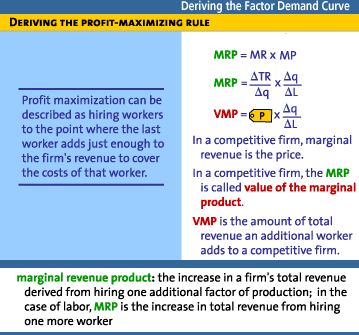
- What is the profit maximizing quantity of
labor to hire if the firm is purely competitive in the short
run?
- ME:
- we need to know the extra benefits of
hiring one more worker and the extra costs of hiring one
more worker
- then we hire up to the point that
MB=MC
- MB of hiring one more worker is the
MRP or the amount that TR increases when we add one more
worker
- MC of hring one more worker
- is the MRC
- margnal resource cost
- MRC = change in TC / change in
quantity of labor
- so we will maximize profits if we
keep hiring as long as the worker adds more to our revenue
(MRP) than it does to our costs (MRC)
- profit maximizing rule: MRP =
MRC
- Given:
- P of TVs = $100
- and the table below
- what is the profit maximizing Q of
labor to hire?
- i.e. where does MRP = MRC, or in
purely competitive product markets, where does VMP = W or
MRP = W
- hire as long as the VMP is > wage
you have to pay up to where VMP = W
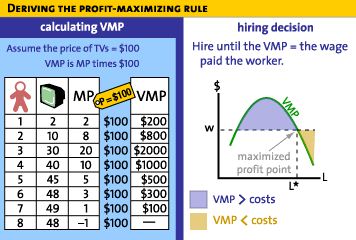
- hire L* number of workers
- thr VMP curve then is the derived
demand curve of labor
- it is also the MRP curve; in purely
competitive product markets VMP = MRP
- So: the demand for labor is the
MRP curve
- VMP = P of the product x
MP
- MRP = change in TR / change in
Q labor
- New rule for maximizing profits in
purely competitive product markets only: W = VMP or W =
MRP
- New rule for maximizing profits in purely
competitive product markets: W = VMP or W = MRP
- this is really the same as MR =
MC
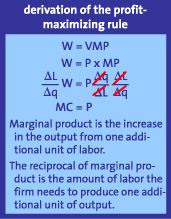
- Now we can draw a Demand curve for
Labor
- Remember: DEMAND is a schedule that
shows the quantiy employed at various wages
- we know they will hire the quantity up
to where the W = MRP (or until W = VMP in purely competitive
product markets)
- so we can pick different wages and find
the quantity of labor demanded at each wage
- ME:
- the VMP = W rule is only good if BOTH
the product market AND the labor markewt are purely
competitive
- a more general rule to maximize
profits is: MRP = MRC
- also, our textbook only shows the MRP
(or VMP here) to be downward sloping, just to keep it
simple
- SO, the MRP curve (or VMP here
with purely competitive product ASD resource markets) is
the resource demand curve
- What will change (shift) the demand for
labor (resource)?
- anything that changes the demand for thr
product (P, P, I, N, T)
- anything that changes the productivity
of the resource (like technology)
- ME: also, changes in the prices of other
resources (but this is complicated -- see textbook)
- ME: see the textbook for a more in depth
discussion of the determinants of resource (labor)
demand
- What happens if you do not have a purely
competitve product market and firms have to lower their prices to
sell more?
- then VMP will not be the same as
MRP
- to find the profit maximizing quantity
to hire: MRP = W (or VMP = W)
- ME:
- but this is only if the
RESOURCE market is competitive
- a more general rule is: to maximize
profits hire labor up to the point where MRP =
MRC
- SUMMARY:
- ALWAYS to find the profit maximizing
quantity to hire: MRP = MRC
- ONLY WITH competitive product AND
resource markets: VMP = W
- ONE MORE THING: since we know
compeititve markets are efficient, then the qallocatively
efficient quantity to hire is where: VMP = W
7.1.3 (15:24) The Supply of
Labor - The Determination of Wages - Analyzing the Labor Market -
12a
- Outline:
- Demand for Labor = MRP
- individual demand
- market demand: horizontal
summation
- Supply of Labor
- Equilibrium in the Labor
Market
- Demand for labor is the firm's MRP
curve
- For ALL graphs in econmics you should be
able to answer three questions:
- what is the relationship being described
by the graph?
- what accounts for the slope, or shape,
of the curve?
- what would cause the curve to
shift?
- for the MRP curve:
- the relationship is the relationship
between the wage in th emarket and the quantity of labor than
an individual firm finds profitable to hire
- the MRP curve is downward sloping
because of the diminishing MP of labor; that is, since each
additional workers produce less additinal output than the
previous worker so they therefore add less to the firm's
revenue
- if the MP of labor declines rapidly
the demand for labor (MRP) will be more elastic and a small
change in the wage rate will cause a large change in the
quantity hired
- ME: the textbook gives the folowinf
determinants of elasticity of demand for labor:
- rate of MP decline
- ease of resource
substitutability
- elasticity of product
demand
- labor-cost to total-cost
ratio
- the demand for labor will shift in
responsese to changes in two determinants:
- a change in the price of the good or
sevice being produced
- a change in labor
productivity
- Market Demand: horizontal summation
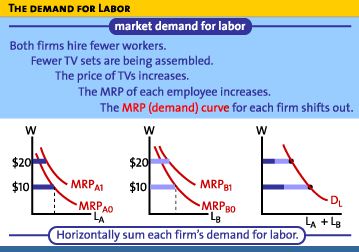
- The Supply curve for labor
- individual households supply labor to
businesses
- how much labor will people be willing to
supply at different wages
- tradeoff between work or
leisure?
- a backward bending supply of labor
curve?
- if wages are high people might decide
to work less and take more leisure - called the income
affect
- but the substitutin effect says that
if wages are high people might work more and take less
leisure
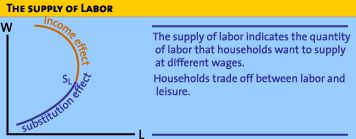
- but usually econmists assume an upward
sloping l;abor supply curve:
- what relationship: the relationship
the market wage and rthe amount of time people want to spend
at work
- why the upward slope: because the
higher the market wage the more people want to
work
- whar causes the curve to shift:
examples:
- lower taxes so people get to keep
more of their income
- if people needed more income like
for medical bills
- if preferences toward work and
leisure changed
- Equilbrium
- where the labor D and S
cross
- Qs = Qd is equilibrium; why
- if wages are too low then the
Qd>Qs and there will be a shortage of labor or excess
demand for labore will bid wages up through the bidding
mechanism
- if wages are too high the the
Qd<Qs and there will be excess supply and the bidding
mechanism will drive wages lower
- shifts in the demand or supply of labor
graphs will change the equilibrium wage rate and the quantity
employed
(THE LOST EPISODES) Factor Market Overview
(YouTube mjmfoodle 1:27) -12a
http://www.youtube.com/watch?v=J0LigIdph8I&list=UU_xHLAJ_zqPHkmC2aY2MdcA
(The Lost Episodes) Perfectly Competitive
Factor and Output Markets 5:14) -12a
http://www.youtube.com/watch?v=OUyvqq6ZY6s&list=UU_xHLAJ_zqPHkmC2aY2MdcA&index=2
LESSON 13a WAGE DETERMINATION
(LABOR MARKETS)
(THE LOST EPISODES) Monopsony Factor Market,
Perfectly Competitive Output Market (YouTube mjmfoodle 8:11)
http://www.youtube.com/watch?v=d5mf1hxXBZY
Micro 5.1 Market and Minimum Wage: Econ
Concepts in 60 Seconds:- Economics Lesson (YouTube ACDC Econ 3:26)
http://www.youtube.com/watch?v=D649L99JjnY
11.4.2
An
Analysis of Labor Unions and Unemployment
(7:27)
OPTIONAL:
11.4.3 Case
Study: "La Causa": The United Farm Workers
(5:10)
11.4.1
Minimum
Wage Laws (7:31)
11.4.4 The
Theory of Efficiency Wages
(10:54)
LESSON 20a - INCOME INEQUALITY
AND DISCRIMINATION
10.3.4 (5:20) Income
Distribution in the U.S. and the Poverty Level - 20a
- Outline:
- Income Distribution
- Poverty
- Income Distribution
- median income in the US in 2004 was
$43,389
- ME: "median" means that half the
families earned less ans half earned more
- doesn't tell ust how the incme is
distributed
- do most families earn about
$43,00
- or do some earn a lot more ans
others a lot less?
- Distribution by quintiles:
- Changes over time:
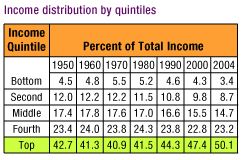
- little change from
1950-1990
- 1990: top quintile begins to earn a
greater share of all income
- 2000: bottom quintile begins to earn
a smaller share of all income
- Poverty Level (2004)
- poverty level

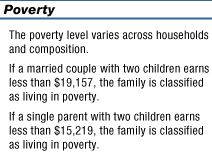
- poverty rate:
- the % of families with invcomes below
the poverty level
- 2004: 12.7% of families in the US
were living in poverty (about 1/8)
- the poverty rate used to be much
higher
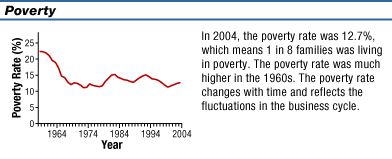
- poverty rates differ for different
demographic groups
- white families have lower rates
than minorities
- single mother headed households
have higher rates
- which families living in poverty
CHANGES a lot
- in any 10 year period, 4 families
out of 10 will at some time be lining in pocerty in the
united States
- less than 3% od families live in
poverty for long periods of time
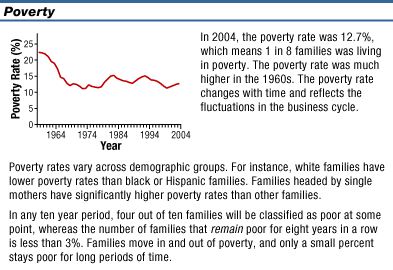
- What can be done?
- progressive income taxes help the
government pay for:
- transfer payments
- in-kind transfers
- public goods
- provide opportunities for acquiring
human and financial capital
- Incentive effects of poverty
programs
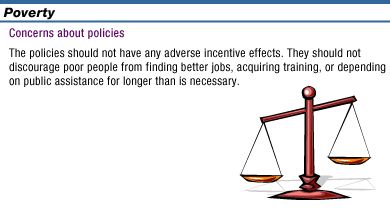
LESSON 22a -
IMMIGRATION
OPTIONAL:


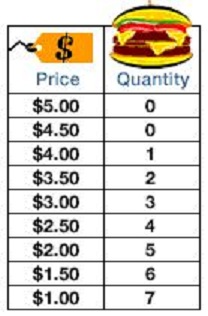
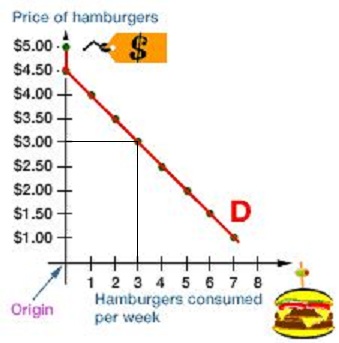





 (very elementary; he does make an adding error!)
(very elementary; he does make an adding error!)












![]() "means "change in")
"means "change in")![]() Pe
would cause an increase in demand today
Pe
would cause an increase in demand today![]() Psub
would cause an increase in demand
Psub
would cause an increase in demand![]() Pcomplement
would cause an increase in demand
Pcomplement
would cause an increase in demand![]() I
would cause an increase in demand for a normal
good
I
would cause an increase in demand for a normal
good![]() I
would cause an increase in demand for an inferior
good
I
would cause an increase in demand for an inferior
good![]() Npot
would cause an increase in demand
Npot
would cause an increase in demand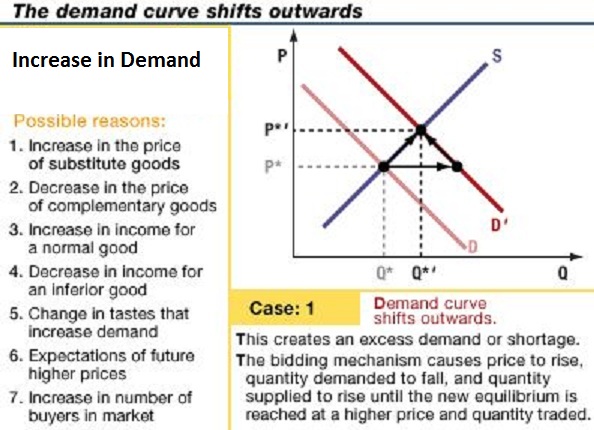
![]() Pe
would cause a decrease in demand today
Pe
would cause a decrease in demand today![]() Psub
would cause a decrease in demand
Psub
would cause a decrease in demand![]() Pcomplement
would cause a decrease in demand
Pcomplement
would cause a decrease in demand![]() I
would cause a decrease in demand for a normal
good
I
would cause a decrease in demand for a normal
good![]() I
would cause a decrease in demand for an inferior
good
I
would cause a decrease in demand for an inferior
good![]() Npot
would cause a decrease in demand
Npot
would cause a decrease in demand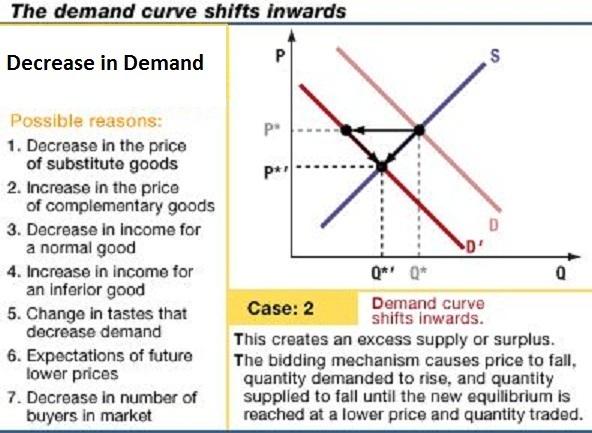
![]() Pe
would cause an increase in supply today
Pe
would cause an increase in supply today![]() Pog
would cause an increase in supply
Pog
would cause an increase in supply![]() Pres
would cause an increase in supply
Pres
would cause an increase in supply![]() Tax
would cause an increase in supply
Tax
would cause an increase in supply![]() Subsidy
would cause an increase in supply
Subsidy
would cause an increase in supply![]() Nprod
would cause an increase in supply
Nprod
would cause an increase in supply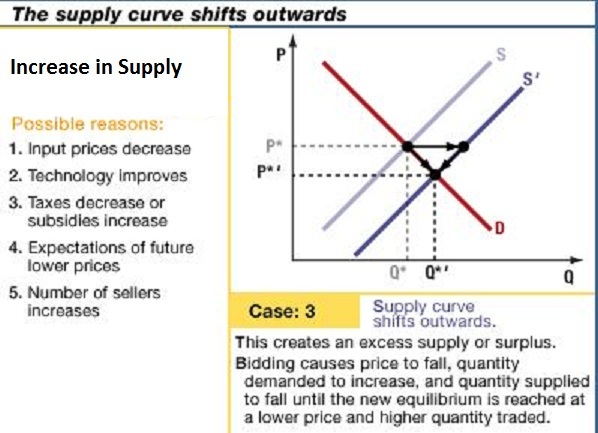
![]() Pe
would cause a decrease in supply today
Pe
would cause a decrease in supply today![]() Pog
would cause a decrease in supply
Pog
would cause a decrease in supply![]() Pres
would cause a decrease in supply
Pres
would cause a decrease in supply![]() Tax
would cause a decrease in supply
Tax
would cause a decrease in supply![]() Subsidy
would cause a decrease in supply
Subsidy
would cause a decrease in supply![]() Nprod
would cause a decrease in supply
Nprod
would cause a decrease in supply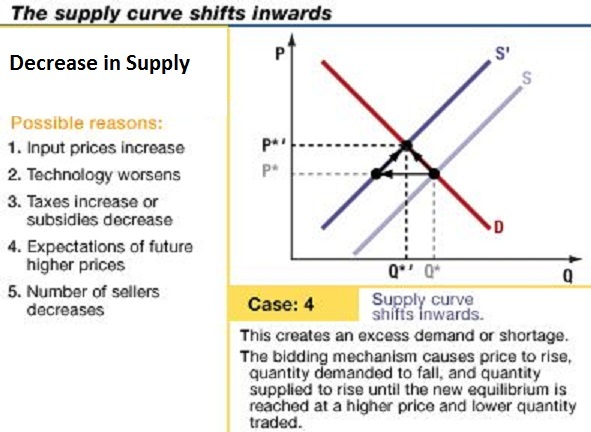










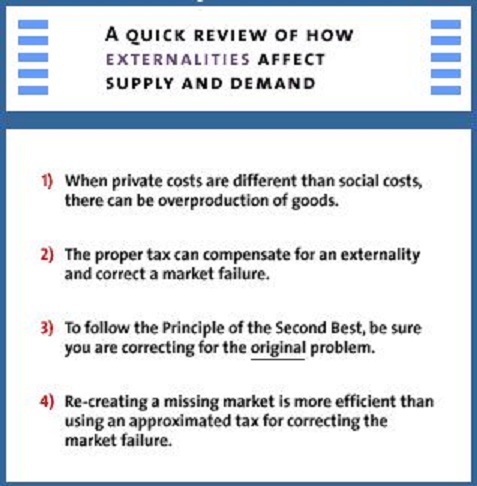



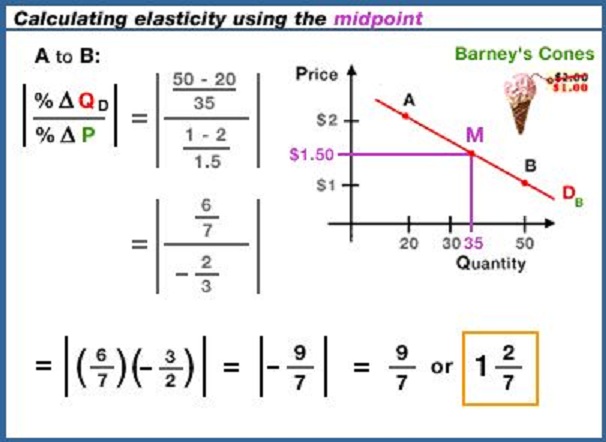
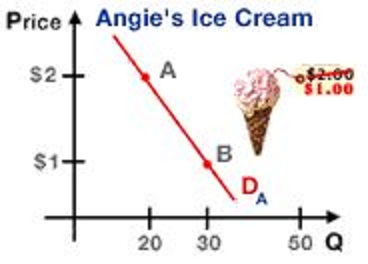

Qd / %
P
Qd = (Q2-Q1) / (Q2-Q1)/2 = 10/25 = 2/5 = 0.4
P = (P2-P1) / (P2-P1)/2 = 1/1.5 = 2/3 = 0.66667
Qd / %
P
Qd = (Q2-Q1) / (Q2-Q1)/2 = 10/25 = 2/5 = 0.4
P = (P2-P1) / (P2-P1)/2 = 1/1.5 = 2/3 = 0.66667


